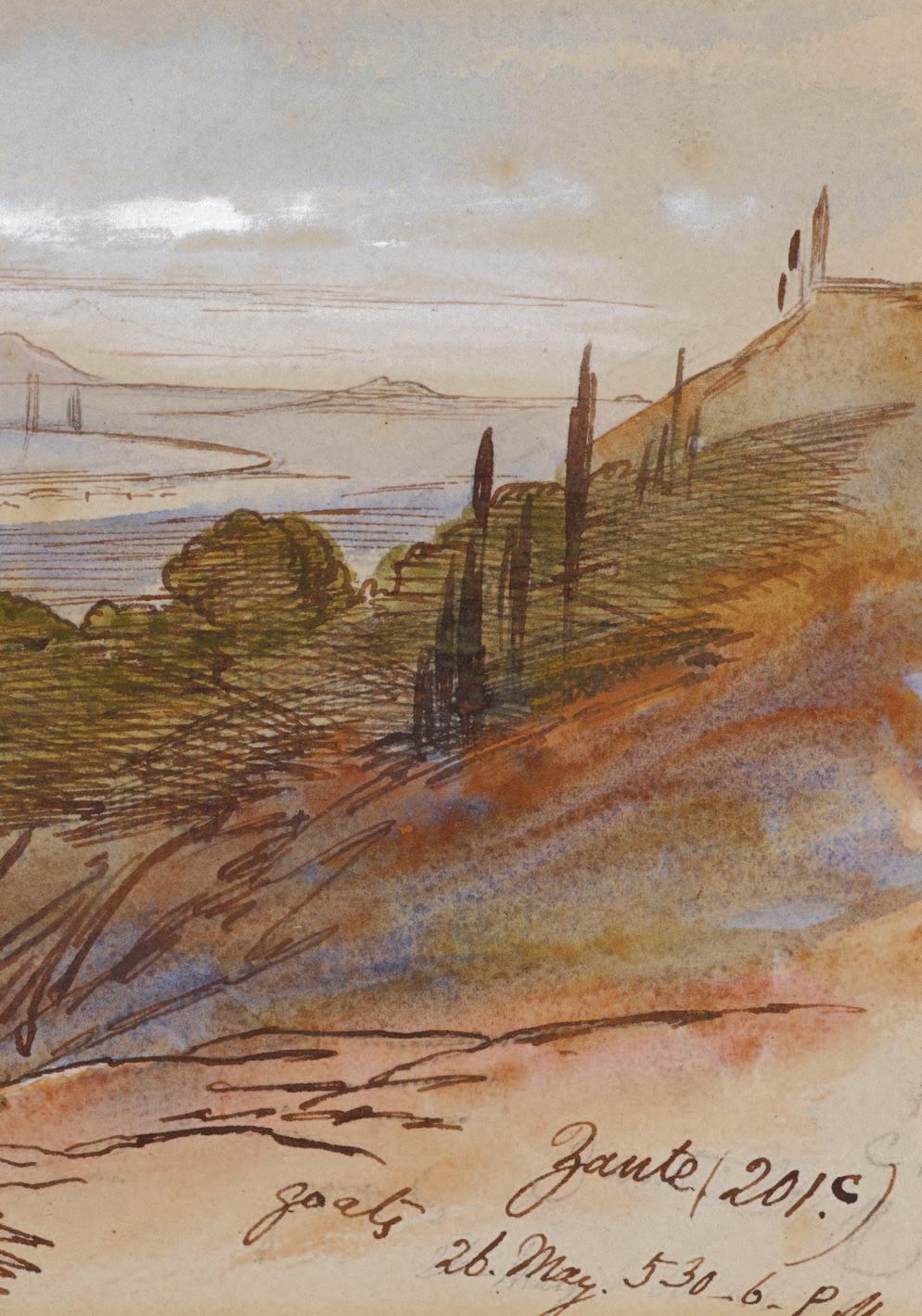

ONE HUNDRED DRAWINGS AND WATERCOLOURS
From the 18 th to the 21 st Centuries

ONE HUNDRED DRAWINGS AND WATERCOLOURS
To be exhibited at Ground Floor, 6 Mason’s Yard, Duke Street, St James’s, London SW1Y 6BU
GUY PEPPIATT FINE ART
Tel: +44 (0) 20 7930 3839 or +44 (0) 7956 968 284 guy@peppiattfineart.co.uk www.peppiattfineart.co.uk
Front cover: Edward Lear (1812-1888) Zante from the foothills of Mount Skopos, Greece [cat.31a]
Opposite page: Philip de László, PRBA (1869-1937) Julia James, 1917 [cat.40]
Back cover: Doris Hatt (1890-1969) Fish Market [cat.74]
HARRY MOORE-GWYN BRITISH ART
Tel: +44 (0)7765 966 256 harry@mooregwynfineart.co.uk www.mooregwynfineart.co.uk
FREYA MITTON
20 TH CENTURY BRITISH ART
Tel: +44 (0)7968 562 499 freya@freyamitton.com www.freyamitton.com
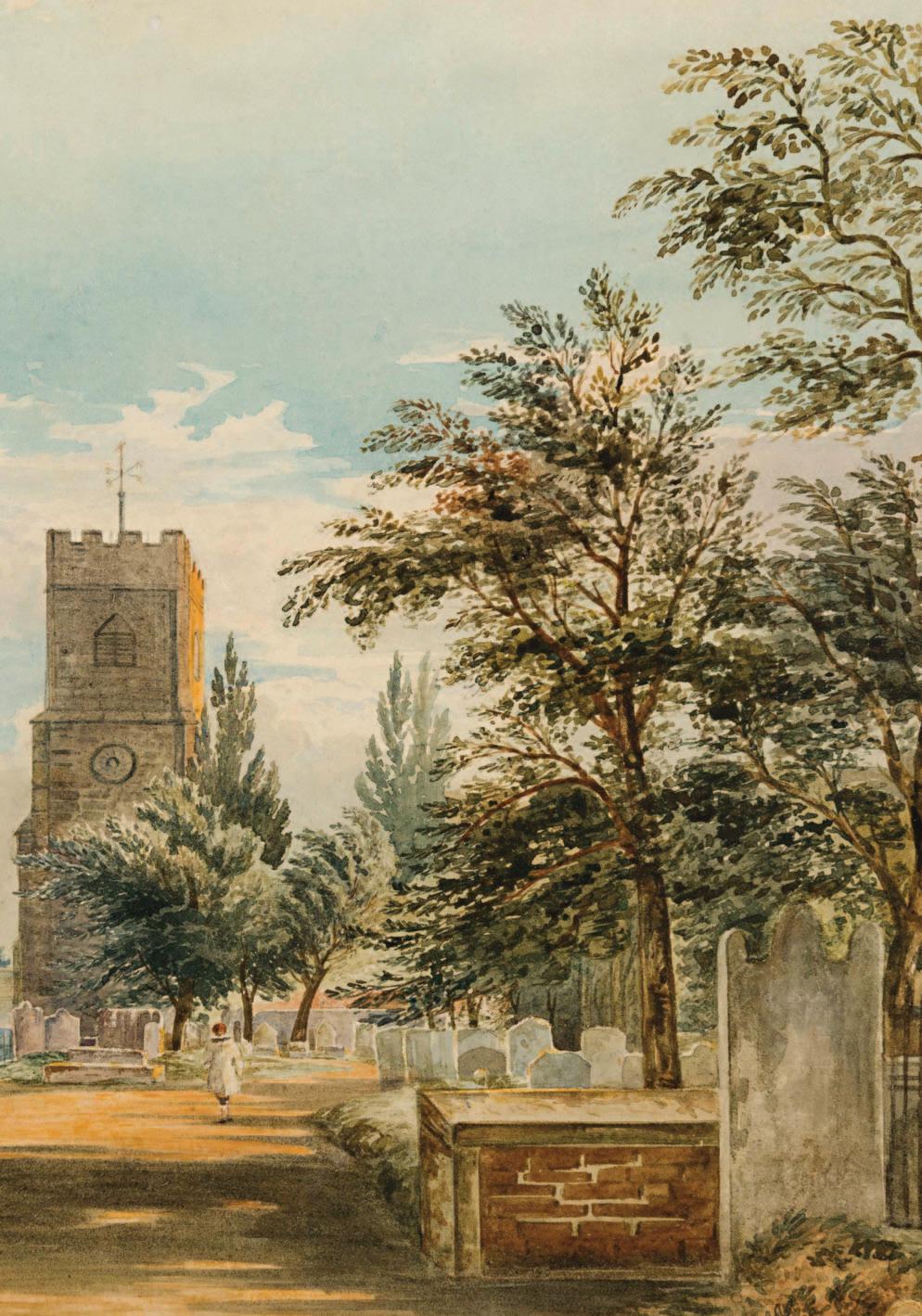
Introduction
Freya Mitton, Harry Moore-Gwyn and Guy Peppiatt are very pleased to present our third combined Winter catalogue of British Drawings and Watercolours at 6 Mason’s Yard. The exhibition will run from the end of November 2025 with remaining works being on show in the gallery until the middle of January 2026.
By focusing again on works on paper (and watercolour in particular), our exhibition attempts to highlight the depth and variety of this distinctively British of mediums, presenting a wide selection of pictures by artists from some four centuries.
With prices starting at only a few hundred pounds, our catalogue is, we also hope, a testament to the astonishing value for money that British drawings and watercolours still represent in today’s market. We very much hope there is something that appeals to you from the catalogue and we look forward to welcoming you at 6 Mason’s Yard over the next few months.
Freya Mitton
Harry Moore-Gwyn
Guy Peppiatt
Opposite page: John Varley (1778-1842)
The Old Church, Hackney, London [cat.28]
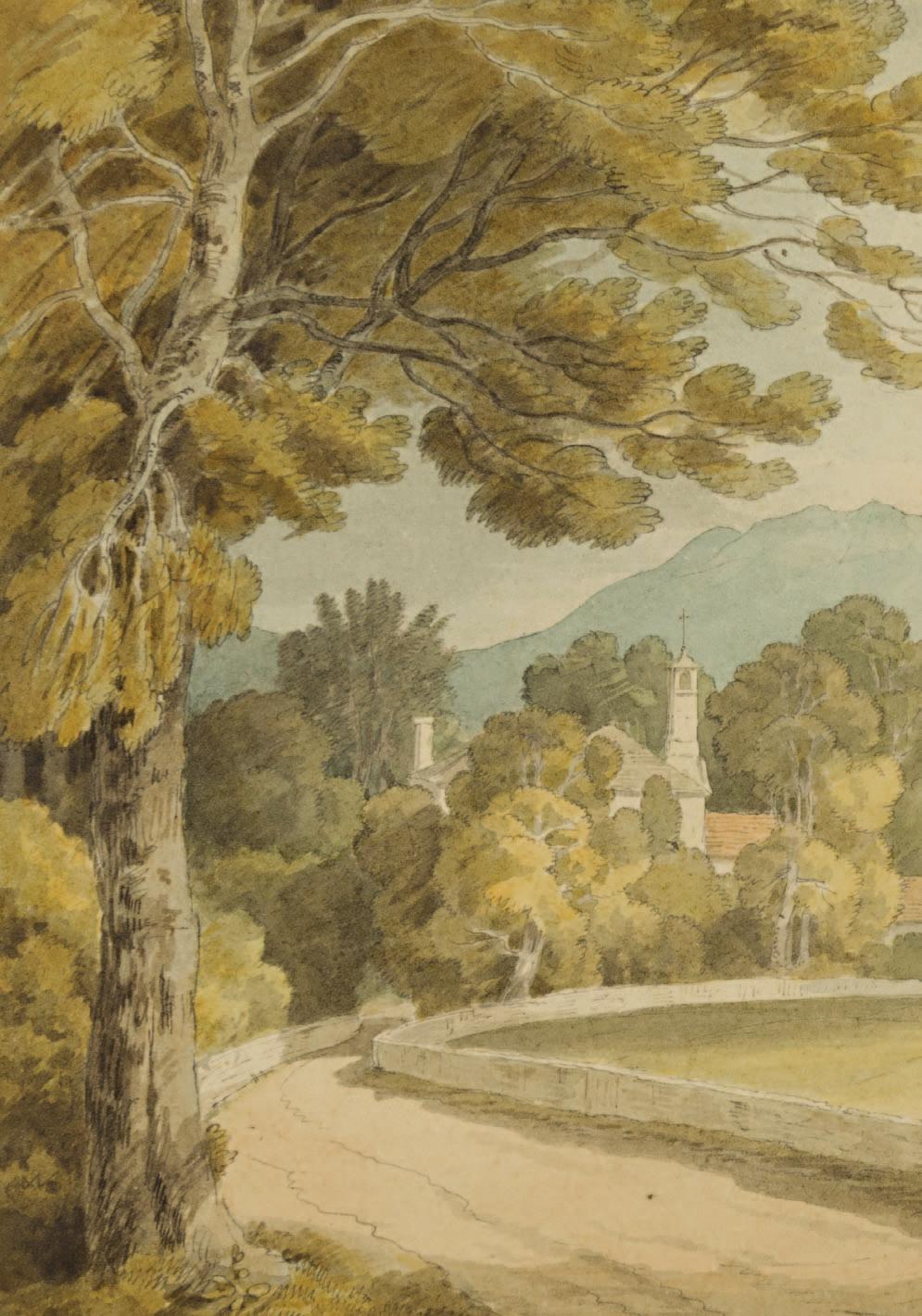

GUY PEPPIATT FINE ART
John White Abbott (1763-1851)
The Church at Luss on Loch Lomond, Scotland [cat.9b]
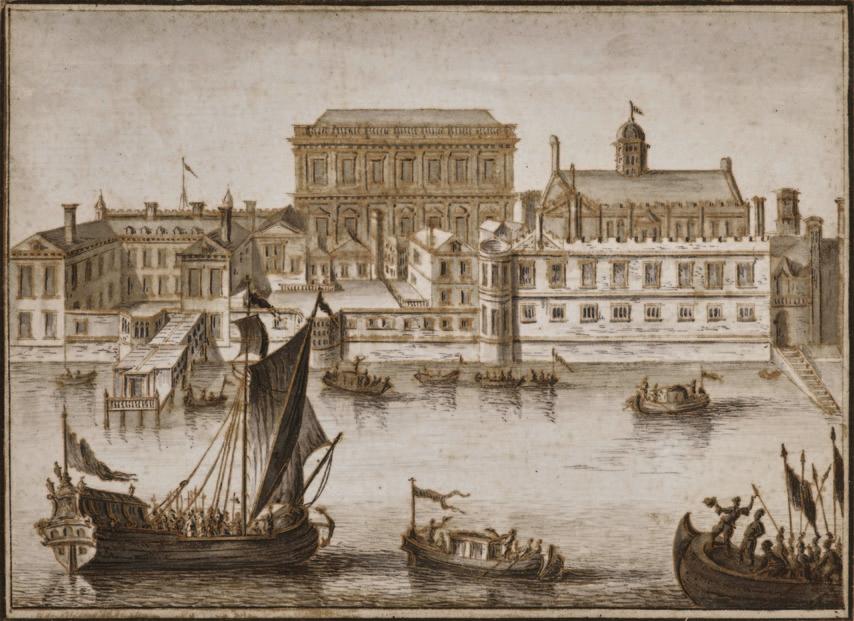
[cat.1]
English School, early 18th Century
A view of Whitehall from the Thames, London
Pen and grey and brown ink and watercolour within artist's pen and ink border 15.3 by 20.4 cm., 6 by 8 in.
Provenance: With Spink and Son, London; Private Collection until 2024
Whitehall Palace was the principal residence of the monarch between 1529 and the devastating fire of 1698. It was initially built by the Archbishop of York in the mid 13th Century and became the London residence of the Archbishops until Cardinal Wolsey’s fall from grace in 1529. Henry VIII took over the palace and extensively remodelled and rebuilt it. By the reign of Elizabeth I, it was the largest royal palace in Europe.
The present drawing is based on a print from 1707 by Pieter van der Aa (1659-1733) which depicts the palace from the Thames. It captures from left to right, the King’s or Volary Lodgings (built between 1666-8), the Privy Bridge extending into the River (begun under Wolsey, rebuilt under Henry VIII and remodelled between 1576-8). The Queen’s Lodgings (1666-8), sit next to the river and in front of the Banqueting House (built by Inigo Jones between 1619-22) and to the right lie the Privy Kitchen range with lodgings above (begun under Cardinal Wolsey). Just behind this is the Chapel Royal and with one of the towers of the Holbein Gate (built 1531-2) visible just behind. The Whitehall Stairs, the public landing place, is visible to the far right.
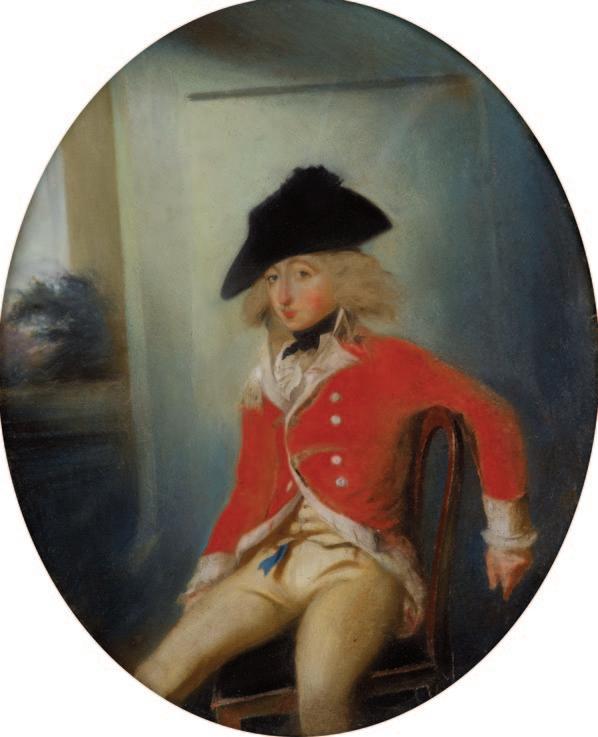
[cat.2]
Sir Thomas Lawrence, P.R.A. (1769-1830)
Portrait of an Officer
Three-quarter length, seated by a window, wearing a red coat and black tricorn hat
Signed, dated and inscribed verso on the original backing sheet: This Portrait/must be kept from/the sun and the Damp/T. Lawrence pinxt/10. Feby 1787
Pastel
Oval 32.4 by 26.5 cm., 12 ¾ by 10 ½ in.
Provenance:
Monsieur H. Winterfeld, Nice; Sotheby's London, 9 December 1936, lot 97, bt. Reitlinger
Literature:
Kenneth Garlick, ‘A Catalogue of the Paintings, Drawings and Pastels of Sir Thomas Lawrence’, Walpole Society, vol. XXXIX, 1964, p.266
This early work by Lawrence dates from the last few months of his time in Bath when he was aged eighteen. From the age of eleven, when his father was declared bankrupt, he was the main breadwinner of the family. He would produce three or four small pastel portraits a week, usually oval in shape, and sell them for three guineas a time. The present pastel is dated 10th February 1787 – later that year he moved to London and began to work in oil.
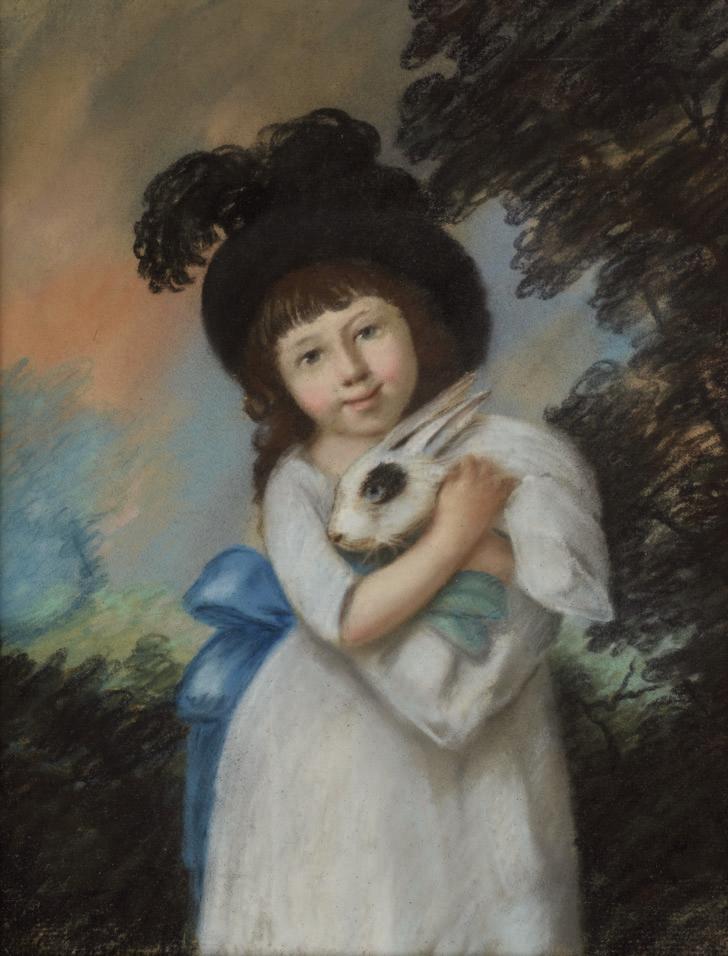
English School circa 1800
Portrait of a Girl holding a Rabbit
Three-quarter length in a wooded landscape
Pastel
28 by 21.8 cm., 11 by 8 ½ in.
[cat.3a]

[cat.3b]
English School circa 1795
Portrait of Marianne Sherman holding a Doll
Full-length, seated in a landscape
Inscribed on an old label attached to the backboard: Marianne Sherman/wife of J.B. Lawes/died 1875 aged 8...
Pastel
24.5 by 19.4 cm., 9 ½ by 7 ½ in.
The Sherman family lived at Drayton, Oxfordshire. Marianne (1791-1875), pictured here by an unknown hand at the age of about 4 or 5, married first the Rev. D.G. Knox in 1810, who died just a few months after their wedding. She then married John Bennet Lawes in 1812, who died in 1822, leaving Marianne to bring up their three children, Marianne (b. 1813), John (b.1814), later Sir John Lawes of Rothamsted and Emily (b.1820).
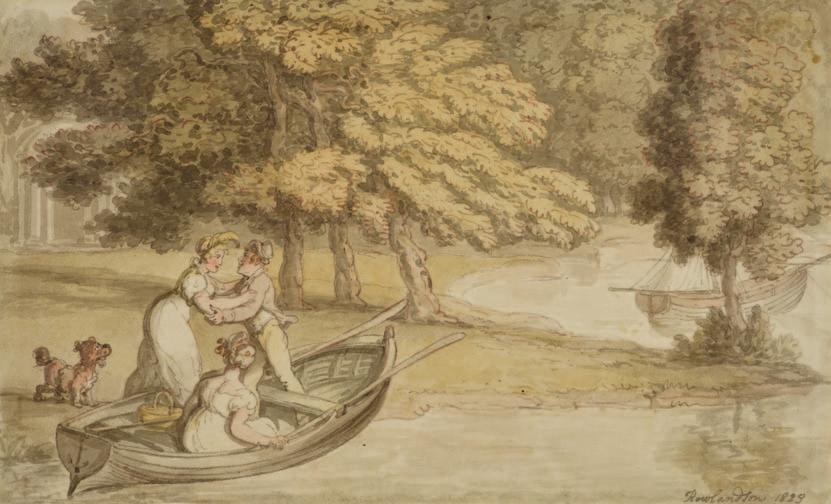
[cat.4a]
Thomas Rowlandson (1756-1827)
The Boating Party
Signed and dated lower right: Rowlandson 1823
Pen and grey ink and watercolour over touches of pencil
14.8 by 24cm., 5 ¾ by 9 ½ in.
Provenance:
With Richard Green and Frank Sabin Galleries, where bought by the present owner
Another version of this watercolour, recorded in the Nettlefold collection, is entitled: ‘Pope's Villa, Twickenham: The Outing’ (see C. Reginald Grundy, A Catalogue of the Pictures and Drawings in the collection of Frederick John Nettlefold, 1937, vol. III). This subject was published in reverse as plate 35 in ‘World in Miniature’ by R. Ackermann in 1817.

[cat.4b]
Thomas Rowlandson (1756-1827)
An Accident out Hunting
Pen and grey ink and watercolour over touches of pencil 11 by 18.4 cm., 4 ¼ by 7 ¼ in.
Provenance: Private Collection, London
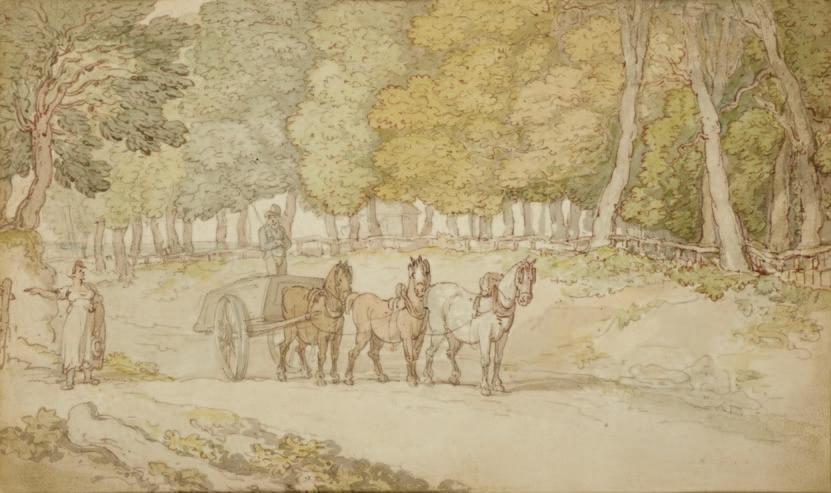
[cat.5]
Thomas Rowlandson (1756-1827)
Gentleman driving a Cart along a woodland Track
Pen and ink and watercolour
14.9 by 23.7 cm., 5 ¾ by 9 ¼ in.
Provenance:
Van Millingen family, Melville Hall, late 19th century; By descent until 2012; With Guy Peppiatt Fine Art, 2012; Private Collection, London

[cat.6]
Philip James de Loutherbourg, R.A. (1740-1812)
Beached boats
Pen and ink and grey wash
8 by 12.1 cm., 3 by 4 ¾ in.
Provenance:
Iolo A. Williams (1890-1962);
By descent until 2024
The son of a miniaturist, Strasbourg born de Loutherbourg initially established himself as a successful artist in France, appointed Peintre du Roi and a member of the French Academy. In 1771, he was persuaded by David Garrick to move to England and work as a scene designer for the Theatre Royal, Drury Lane, becoming the most successful theatre painter in Europe. However, he also continued to work as a landscape painter, exhibiting regularly at the Royal Academy and becoming elected a member in 1781.
De Loutherbourg became increasingly fascinated by maritime and especially naval subjects and during the 1790s he painted several works celebrating the prowess of the British navy, as well as great maritime disasters. He produced numerous on the spot sketches and studies of boats and ships, at all angles and positions and states of repair, such as the present work. There are several related studies in the British Museum, London, including a beached rowing boat and a study of two small boats with furled sails.

All proceeds from the sale of this picture will benefit Turner’s House, Twickenham
[cat.7]
John Alexander Gresse (1741-1794)
View near Framlingham, Suffolk
Signed lower right: JA Gresse 1781 and inscribed verso in a later hand: View near Framlingham
Pen and ink and watercolour over traces of pencil on laid paper
25.4 by 35.7 cm., 10 by 14 in.
Provenance:
With W/S Fine Art, 2005; Private Collection
Literature:
Huon Mallalieu, Dictionary of British Watercolour Artists up to 1920, 2002, vol. I, p.283, ill.; Andrew Wyld, W/S Fine Art, Watercolours and Drawings – The Annual Exhibition, 2005, no.16, ill.
Having trained as an engraver, Gresse took drawing lessons under Zuccarelli and was assistant to Cipriani. He was a drawing master at Harrow School in 1773 and taught Robert Hills among others. The writer and artist William Henry Pyne (1769-1843) recorded that Gresse ‘was appointed teacher to the princesses (the children of George III), which distinguished office he held from the year 1777 to the time of his death in 1794. Gresse taught landscape and figure: the style of his landscapes was in the early manner of Paul Sandby, correctly outlined in pen, an tinted with colours; his figures were in the style of his master [Cipriani], drawn in chalks, and tinted with powder colours. He was much esteemed by her Majesty and the princesses, and known to the King…’ (Royal Residences, 1819, I, p.12).
See entry to no.21 for more on Turner’s House.

[cat.8]
Anthony Devis (1729-1816)
St Martha-on-the-Hill near Albury, Surrey from the South
Signed and dated, lower right in the margin: Devis 1798, inscribed, lower left in the margin: Looking across Ride Lane to St Martha’s Chapel. Pen and ink and watercolour over touches of pencil
15.8 by 22.4 cm., 6 ¼ by 8 ¾ in.
Provenance: Iolo A. Williams (1890-1962); By descent until 2024
According to the inscription, this is a view taken from Ride Lane which is now in the hamlet of Farley Green south of Albury. Devis lived at Albury House from 1780 until his death in 1816 and drew extensively in the grounds of the house and the surrounding area.
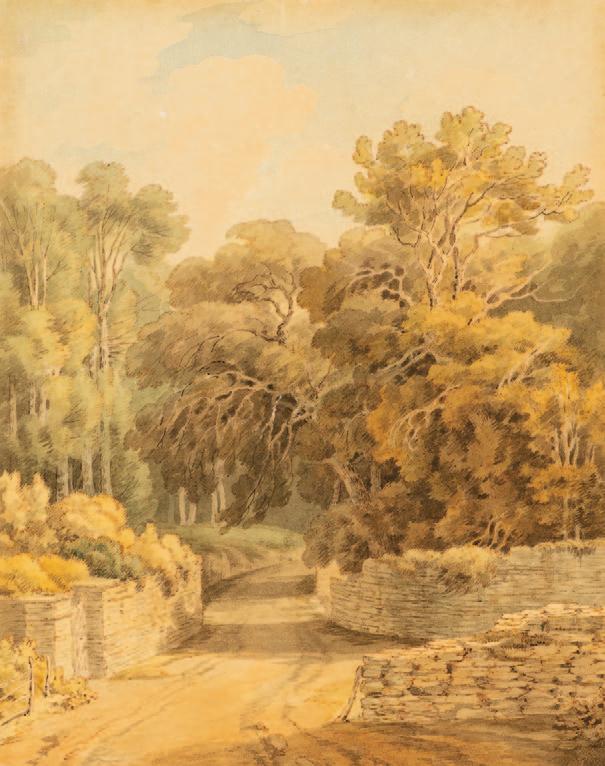
[cat.9a]
John White Abbott (1763-1851)
A Wooded Track, Widecombe in the Moor, Devon
Signed with initials, inscribed and dated, verso: Widdecombe - Devon/JWA. July 18. 1792.
Pen and brown ink and watercolour
23.2 by 18.6 cm., 9 by 7 ¼ in.
Provenance:
With The Fine Art Society, London, 1952; Harry Lawrence Bradfer-Lawrence F.S.A. (1887-1965); Private Collection
Exhibited:
London, Fine Art Society, May 1952, no. 10; The Arts Council of Great Britain touring exhibition, The Bradfer-Lawrence Collection, 1953, no. 4
A drawing of a slate quarry at Widecombe by White Abbott, also dated 18th July 1792, is in the Yale Center for British Art (B1975.3.1082). Widecombe in the Moor is a village on Dartmoor twelve miles west of Newton Abbot.

[cat.9b]
John White Abbott (1763-1851)
The Church at Luss on Loch Lomond, Scotland
Signed on reverse of original washline mount: N.o36/The Kirk at Lufs on Loch Lomond./JWA. July 1. 1791. Pen and grey ink and watercolour 19 by 24.2 cm., 7 ½ by 9 ½ in.
Provenance:
By descent to the great-grandson of the artist, Mr Douglas; Mrs G. Walmsley, her sale, Christie's, 14th March 1978, lot 151; With Leger Galleries, London, 1978
Literature:
A.P. Oppé, ‘John White Abbott of Exeter’, Walpole Society, Vol. XIII, 1924-5, p.75
Exhibited:
London, Leger Galleries, English Watercolours, 13th November to 22nd December 1978, no.2
Luss is a pretty village ten miles south of Tarbert on the west side of Loch Lomond. The current church dates from 1875. Kirk is the Scottish word for church.
This drawing dates from White Abbott’s six week tour of the north of England and Scotland in the summer of 1791. Most of his drawings from the tour are numbered, with no.1, dated 13th June, of York Minster and no. 80, dated 28th July of Glastonbury in Somerset. He was in Edinburgh by 19th June then continued north to Stirling and Dunkeld then west to loch Tay, Loch Awe, Loch Fyne and Loch Long. He continued south to Loch Lomond then on to Glasgow and the south. The current work is numbered 36 and dated 1st July. No. 37, dated 2nd July, is a view of Ben Lomond and was with Leger Galleries in 1982. A watercolour of Loch Long, drawn the same day, was with Guy Peppiatt Fine Art in 2017 and is now in Princeton University Art Museum.
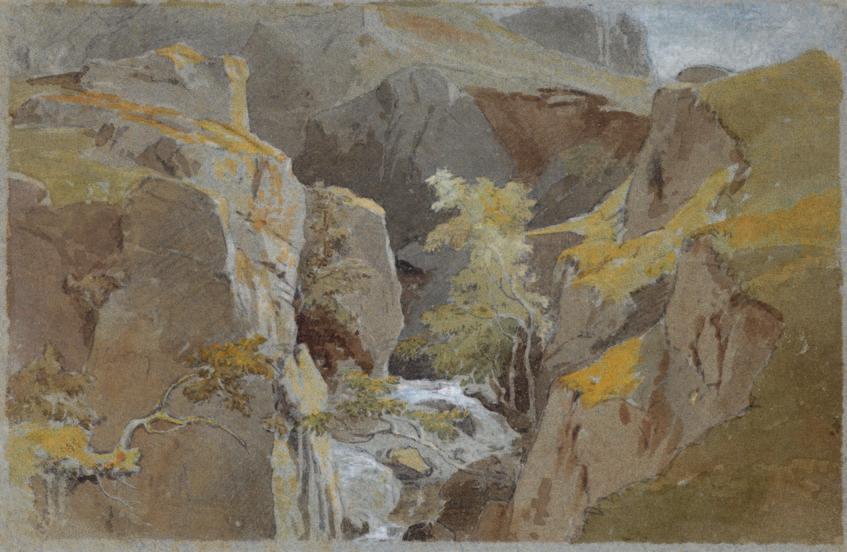
[cat.10]
Ramsay Richard Reinagle, R.A. (1775-1862)
Scene in the Mountains, descending to St John’s Vale, near Keswick
Signed and inscribed verso: Scene in the Mountains descending to St John’s Va…/5 miles from Keswick/RRReinagle R… Watercolour over pencil heightened with white on blue paper 17.6 by 27 cm., 7 by 10 ½ in.
Provenance:
Colnaghi, London;
Where bought by Iolo A. Williams (1890-1962), May 1954; By descent until 2024
The son of an artist, Ramsay Richard Reinagle first exhibited at the Royal Academy aged just thirteen. He subsequently trained in Holland before travelling to Italy in 1796-8. He was President of the Society of Painters in Water-colours in 1808-12 and elected a Royal Academician in 1823. Both he and his father were talented copyists and generated extra income by producing copies of Old Masters, particularly of the Dutch School and in carrying out restoration work.
Reinagle visited the Lake District in 1807 with William Havell (see cat. no.15) and the views he encountered provided the artist with inspiration for the rest of his career. He exhibited thirty-one watercolours of Lake District subjects between 1808 and 1823 at the Old Watercolour Society, including five in the first year, amongst which was a view of St John’s Vale, looking towards Saddleback, near Keswick, no 77, which was purchased by Lord Aylesford. St John in the Vale is a small valley to the east of Keswick. It is flanked by the steep slopes of the Helvellyn Range, with St John’s Beck tumbling through the valley.
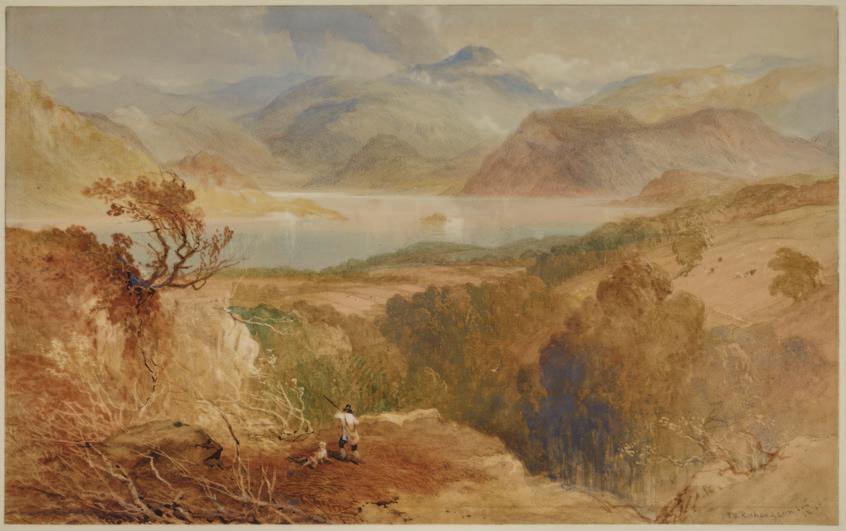
[cat.11]
Thomas Miles Richardson Junior, R.W.S. (1813-1890)
Ullswater from Gowbarrow
Signed lower right: T.M. Richardson Jun.r/1840Watercolour over pencil heightened with bodycolour 23.8 by 38.3 cm., 9 ¼ by 15 in.
Engraved:
For Black's ‘Picturesque Guide to the English Lakes’, published in Edinburgh 1841, pl.I as a steel engraving
Richardson found success early and regularly sent watercolours to both the British Institution and the Royal Academy, while still based in his native Newcastle. He moved to London in 1846 and by the time of his death had exhibited over seven hundred watercolours at the Society of Painters in Water-colours.
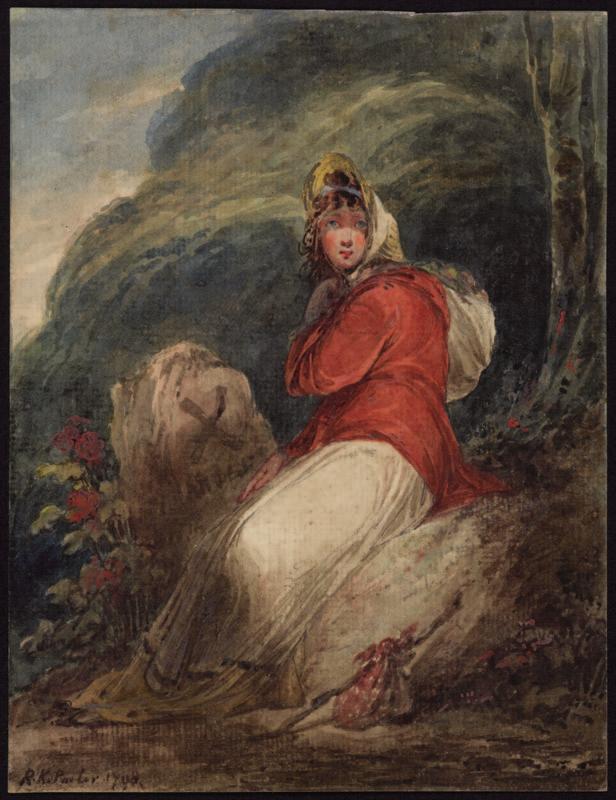
[cat.12]
Sir Robert Ker Porter (1777-1842)
Woman seated by a Milestone
Signed and dated, lower left: R. K. Porter 1798
Watercolour over pencil on laid paper
15.8 by 12.2 cm., 6 ¼ by 4 ¾ in.
Provenance:
Iolo A. Williams (1890-1962); By descent until 2024
Literature:
Iolo A. Williams, Early English Watercolours, 1970, ill. plate LXXXV, no.175
Sir Robert Ker Porter had a distinguished career as a painter, writer and diplomat and was knighted by the Prince Regent in 1812. In 1800 Porter was invited to Russia by Tsar Alexander I to decorate the Admiralty in St Petersburg. He fell in love with the country, and a Russian princess whom he married, and returned to the country frequently. In 1825 he was appointed British Consul to Venezuela and spent fifteen years in Caracas. He died while in Russia visiting his daughter who was married to a Russian army officer.

[cat.13]
Robert Hills (1769-1844)
Cowherd on a Country Track
Signed lower right: RHills. 1811. Watercolour over pencil 43 by 31.6 cm., 16 ¾ by 12 ½ in.
Hills entered the Royal Academy Schools in 1788 and first exhibited there in 1791. In 1804 he was one of the six founding member of the Society of Painters in Watercolours and exhibited almost six hundred drawings there during his lifetime. He specialised in studies of animals and farmyards in a distinctive ‘fuzzy’ technique.
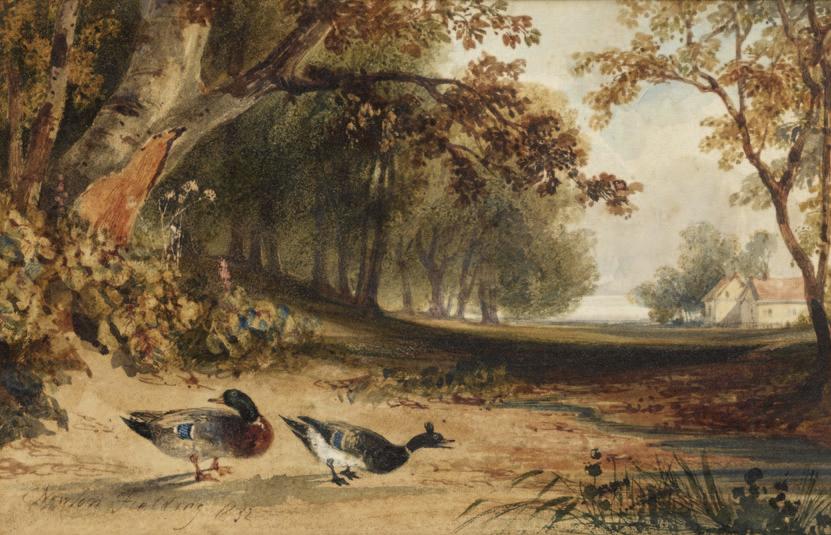
[cat.14a]
Newton Smith Limbird Fielding (1799-1856)
Mallard in a Country Landscape
Signed lower right: Newton Fielding 1832
Watercolour heightened with bodycolour, scratching out and gum arabic 14.3 by 22.1 cm.,5 ½ by 8 ½ in.
Provenance:
Bought at the Marche des Puces, Paris, 27th January 1972 for 180 frs; Private collection, London
Newton Fielding came from a family of artists: his four brothers and a sister, all became painters and trained under their father Nathan Theodore. Several members of the family worked in Paris at some stage, although Newton, whose wife was French, divided his time between Paris and London. He established a reputation on both sides of the Channel for producing smallscale watercolours of animals and birds in landscape settings, delicately worked with a bold palette.
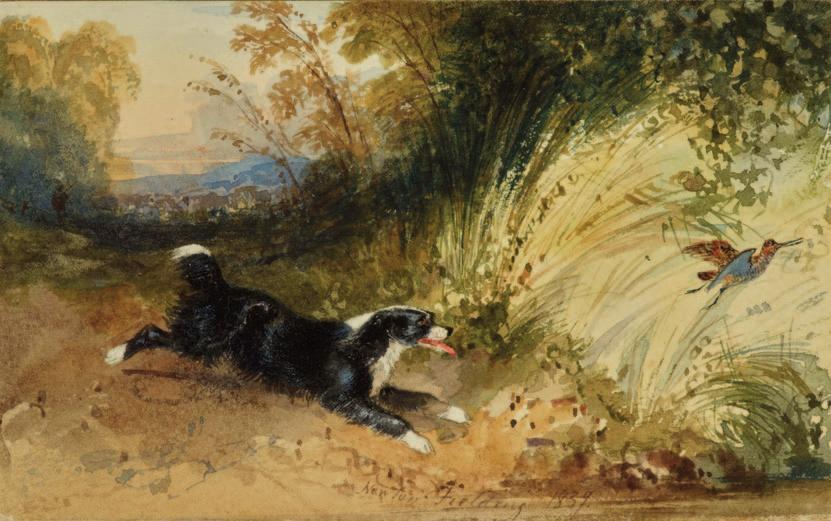
[cat.14b]
Newton Smith Limbird Fielding (1799-1856)
A Dog chasing a Snipe
Inscribed lower centre: Newton Fielding 1839. Watercolour over pencil heightened with bodycolour 10.1 by 16 cm., 4 by 6 ¼ in.
Provenance: With Lowell Libson Ltd; Private collection, UK
Literature: Lowell Libson Ltd, Watercolours and Drawings, London, 2006, cat. no. 41, ill.
Exhibited: London, Lowell Libson Ltd, Watercolours and Drawings, 15th November - 8th December 2006, no 41
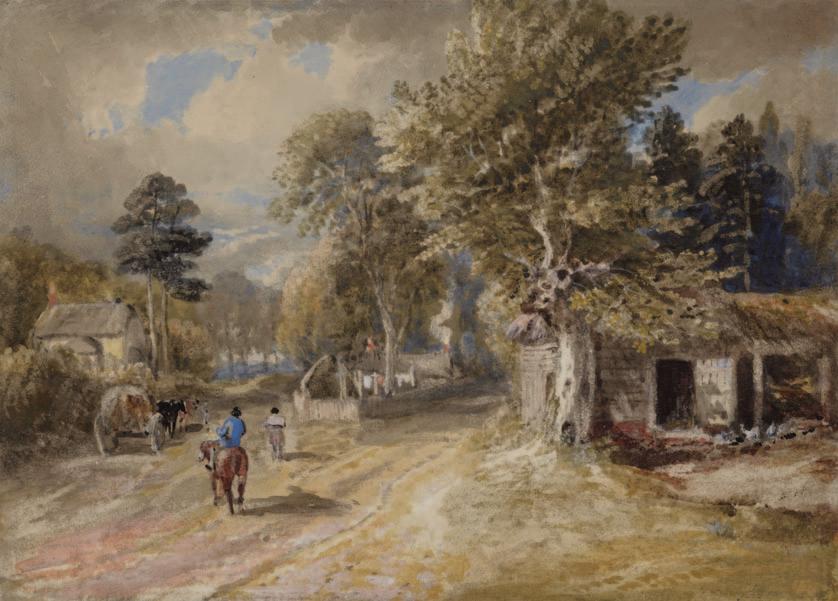
[cat.15]
William Havell O.W.S. (1782-1857)
Farmyard Scene
Watercolour heightened with bodycolour and stopping out 24.5 by 34.4 cm., 9 ½ by 13 ½ in.
Provenance:
With Spink & Son, London, 1981
Literature:
Felicity Owen and Eric Stanford, William Havell 1782-1857, p.35, no.103, ill.
Exhibited:
London Spink & Son, William Havell 1782-1857, 24th November to 18th December 1981, no.103; Reading Museum and Art Gallery, William Havell 1782-1857, 9th January to 20th February 1982, no.103; Kendal, Abbot Museum and Art Gallery, William Havell 1782-1857, 6th March to 10th April 1982, no.103
Havell came from an artistic family - his father, uncle and some of his siblings were all artists. In 1802 and 1803 he toured Wales, meeting up with Joshua Cristall, Thomas Webster and Cornelius Varley. He first exhibited at the Royal Academy in 1804, and the same year was a founder member of the Old Watercolour Society. In 1816, Havell accepted the post of official artist to Lord Amherst’s embassy to China, before settling for a time in India, only returning to Britain a decade later after a bout of ill health.
Felicity Owen and Eric Stanford dated the present watercolour to circa 1853/4.

[cat.16]
George Barret Junior O.W.S. (1767-1842)
Cattle watering in a Wooded Glade
Watercolour over pencil heightened with stopping out 18.3 by 25.6 cm., 7 ¼ by 10 ¼ in.
Provenance:
John Bibby; Holbrook Gaskell (1813-1909); James Orrock (1829-1913), 1904; With Messrs Dunthorne & Brown, Liverpool; With Spink Leger, London, 1997; Private Collection, London
Exhibited:
London, Spink-Leger Pictures, Annual Exhibition of British Watercolours and Drawings, 1997, no. 42;
Literature: Spink-Leger Pictures, Annual Exhibition of British Watercolours and Drawings, 1997, no. 42, ill.
The present watercolour with its atmospheric depiction of the effects of dappled light and shade is characteristic of Barret’s work. The artist was fascinated from an early age by the differing play of light on a scene. Many of his watercolours are evocatively titled, noting the time of day or weather effects, rather than recording the precise locations of his views. Roget noted that Barret would ‘go to the same spot and watch the sunrise morning after morning… He used to wait until the effect appeared that suited him and go to the same sketch over and over again at the same hour on different days, working only as long as the particular effect lasted’ (John Lewis Roget, A History of the Old Water-Colour Society, 1981, vol. I, p. 177).
Barret was the son of Dublin born artist George Barret Senior (1728/32-1784), a founder member of the Royal Academy and successful landscape painter. Barret Junior in turn was one of the founder members of the Old Watercolour Society in 1804.
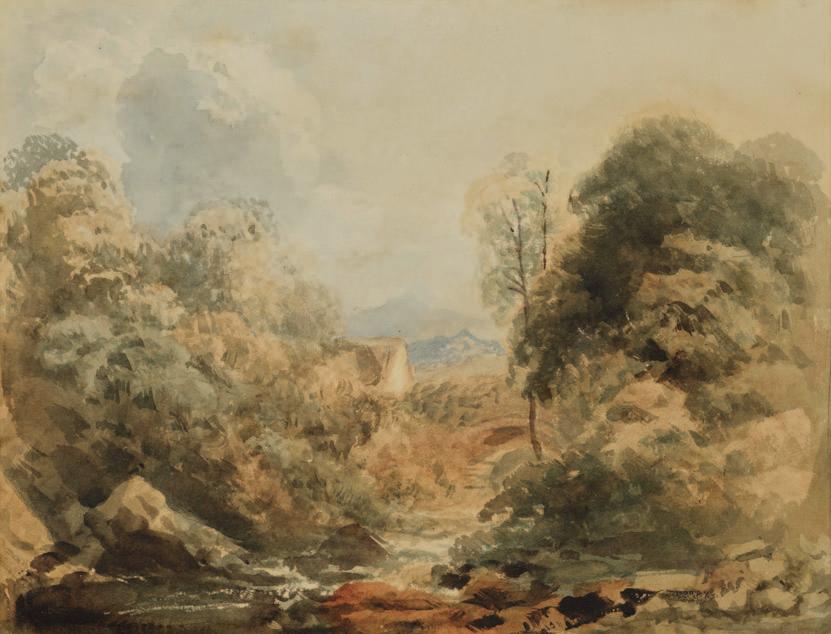
[cat.17]
Peter de Wint (1783-1849)
A Mill on a River in a Wooded Landscape
Watercolour over traces of pencil heightened with scratching out 22.7 by 29.8 cm., 8 ¾ by 11 ¾ in.
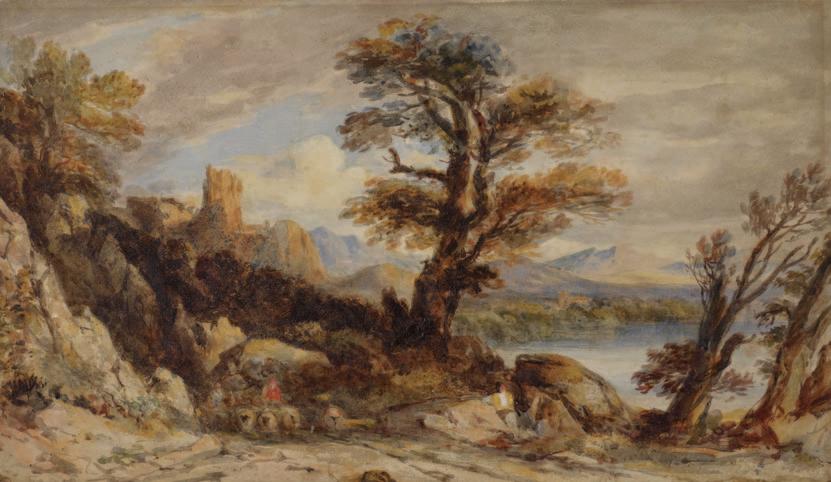
[cat.18]
John Varley (1778-1842)
A Shepherd and Sheep on a Country Road near a ruined Castle
Watercolour over pencil heightened with bodycolour and gum arabic
25.3 by 44 cm., 10 by 17 ¼ in.
Provenance:
Anonymous sale, Christie's, 9th June 1970, lot 85; With Stanley W. Fisher, Bewdley, Worcestershire, 1970s; By descent to the present owner
This late work dates from circa 1840.

[cat.19a]
John Varley (1778-1842)
Children playing outside a House
Signed lower left: J. Varley
Black and white chalk on blue paper heightened with pink chalk
27.8 by 36.5 cm., 10 ¾ by 14 ¼ in.
Provenance: Angela Hornyold-Strickland, Sizergh Castle, Cumbria; With Guy Peppiatt Fine Art, 2013; Private Collection, UK
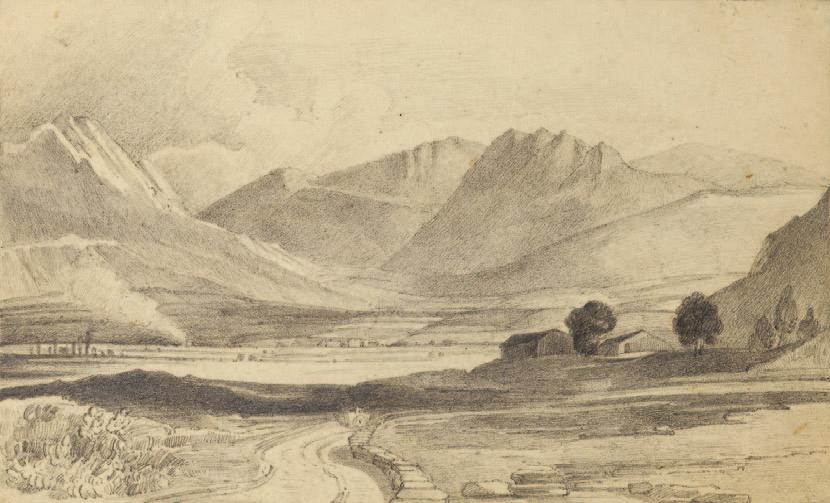
[cat.19b] John Varley (1778-1842) Mountains, North Wales
Inscribed on border, under the mount: by J. Varley Pencil on Whatman paper dated 1816
Sheet 16 by 25.4 cm., 6 ¼ by 10 in.
Provenance: With Guy Peppiatt Fine Art, 2013; Private Collection, UK

[cat.20]
Cornelius Varley (1781-1873)
A‘Peter boat’ drawn up on the Shore, with a House on the far Shore
Signed and inscribed, lower left: Peter Boat C. Varley, further inscribed on the boat: Tryall and W Tappy Pen and ink and watercolour over pencil, squared for transfer 23.2 by 36.2 cm., 9 by 14 ¼ in.
Provenance:
With Sabin Galleries Ltd, Cork St, London; Anonymous sale, Christie’s, 9th July 1985, lot 56; Exhibited:
London Sabin Galleries Ltd, no 145
Engraved:
By W. Boosey and published by Cornelius Varley, Varley’s Drawing Book of Boats, shipping etc., also picturesque implements of Husbandry and other rustic subjects, 1847
A Peter Boat was a small double-ended fishing boat that was popular around the Thames Estuary and East Anglia. These fishing boats often went out for several days or even a week at a time and consequently had a water tight compartment in the middle of the boat, to keep the catch alive until it was brought to shore. This compartment was kept flooded by small holes in the hull. The boat in the present watercolour was called Tryall, owned by a W. Tappy.
The present highly finished watercolour was engraved as part of a series of engravings of different boats from drawings produced throughout Varley’s career and published together in 1847. Although one of the reasons for the publication of this work was to promote the artist’s Patent Graphic Telescope, as evidenced by the paragraph below the title, extolling the virtues of the drawing aid. Varley’s fascination with boats was lifelong - in 1809 he had produced a small series of etchings intended for publication by subscription under the title of Etchings of Shipping, Barges, Fishing Boats, and other Vessels, commonly met with on the British Coasts, Rivers and Canals., The whole will be drawn from Nature, and etch'd by Cornelius Varley.

[cat.21]
William Turner of Oxford (1789-1862)
Study from Nature at Bullingdon Green near Oxford
Signed verso: Study from nature, Bullingdon near Oxford/W.T. Watercolour over pencil heightened with bodycolour
23.5 by 45 cm., 9 ¼ by 17 ¾ in.
Provenance:
With Agnew’s, 1996; Private Collection
Literature:
Thos. Agnew, English Watercolours and Drawings – 123rd Annual Exhibition, 1996, no.77, ill. Exhibited;
London, Thos. Agnew, English Watercolours and Drawings – 123rd Annual Exhibition, 4th to 29th March 1996, no.77
Bullingdon Green was a large area of pasture of around a hundred acres stretching from Headington to Horspath and Cowley and now subsumed as part of Oxford. In the eighteenth century it was a popular area of horse-riding and cricket. The notorious Oxford Bullingdon Club started out, in 1780, as a cricket club on Bullingdon Green. G.V. Cox records in 1805: ‘The game of cricket was kept up chiefly by the young men from Winchester and Eton, and was confined to the Old Bullingdon Club, which was expensive and exclusive’ (Reminiscences of Oxford). The first recorded cricket match on the Bullingdon Green cricket match took place in 1843 between the University of Oxford and the MCC. Cricket fixtures continued there until 1879.
Sandycombe Lodge was the home of J.M.W. Turner between 1813 and 1826. Now a registered charity, it is open to the public but receives no public funding. For more information or to support their fundraising campaign see www.turnerhouse.org
All proceeds from the sale of this picture will benefit Turner’s House, Twickenham
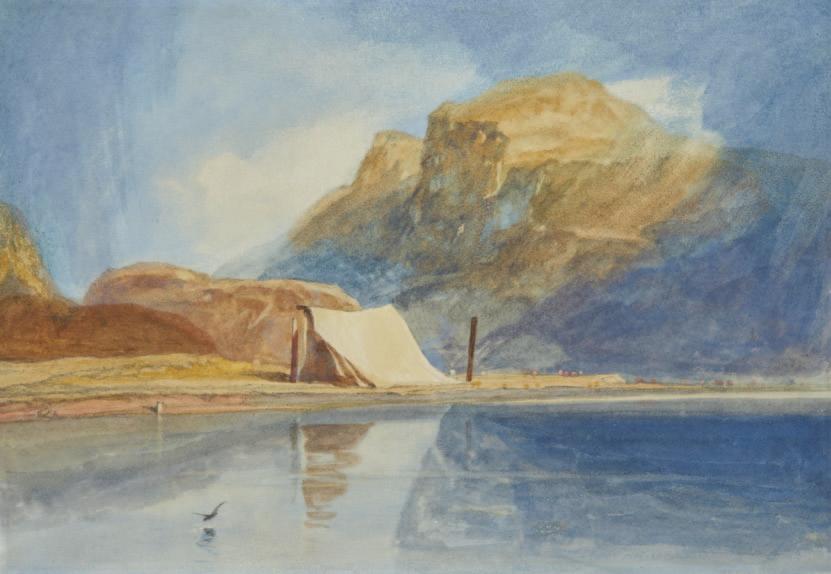
[cat.22]
Miles Edmund Cotman (1810-1858)
A Tent pitched by a Lake in a Mountainous Landscape
Watercolour over pencil
20.7 by 29.8 cm., 8 by 11 ¾ in.
Provenance: With Anthony Reed, Cork Street, London, where bought, 1970s; By descent to the present owner
Miles Edmund Cotman was the son of the Norwich School artist John Sell Cotman and worked in a similar style.
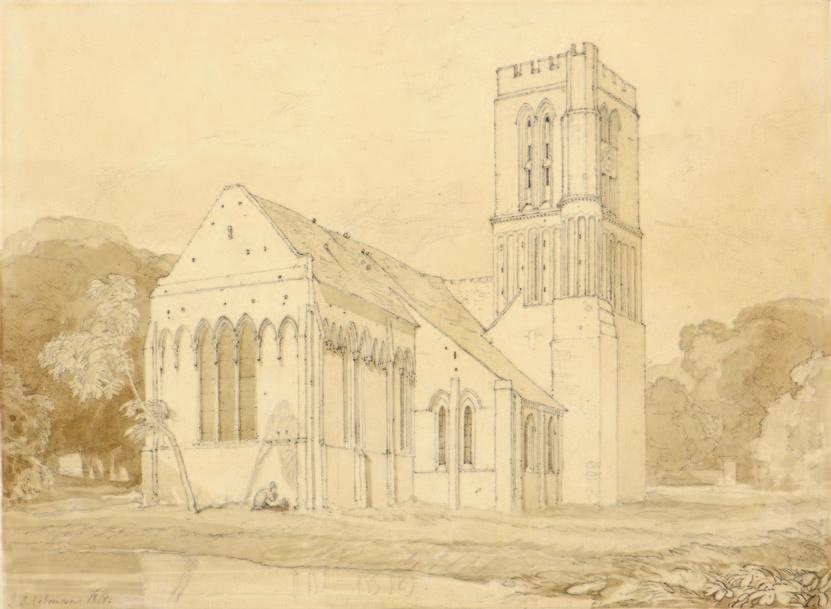
[cat.23]
John Sell Cotman (1782-1842)
The Church of St Pierre at Hermanville-sur-Mer, Normandy
Signed lower left: J.S. Cotman 1818 and inscribed on border under mount: North east View of the Church of Hermonville near Caen
Brown washes and pencil
Image 24.8 by 34.2 cm., 9 ¾ by 13 ½ in.
Provenance:
The Rev. F.N. Vavassour; With P. & D. Colnaghi, London
Cotman visited Normandy three times to find subject matter for a planned series of etchings entitled Architectural Antiquities of Normandy with the help of his patron Dawson Turner. His first trip lasted from 20th June to 10th August 1817 with a second from 20th June to 7th September 1818 with the final one from 26th July to 10th October 1820. The first of the four instalments was published in early 1820 with the final one issued in the middle of 1822. For more on Cotman's Normandy tours, see Timothy Wilcox, Cotman in Normandy, exhibition catalogue, 2012 and Miklos Rajnai, John Sell Cotman - Drawings of Normandy in Norwich Castle Museum, 1975.
Hermanville-sur-Mer is several miles north of Caen on the Normandy coast. Cotman must have visited the town during his stay in Caen between 24th July and 14th August 1818. This drawing was not engraved for Cotman's Antiquities series.
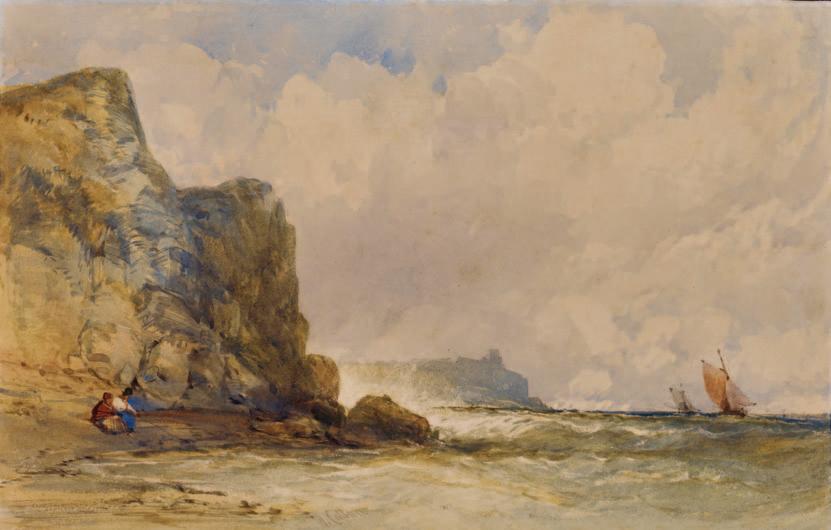
[cat.24a]
William Callow, R.W.S. (1812-1908)
Teignmouth, Devon
Signed lower centre: W. Callow
Watercolour over pencil heightened with bodycolour and scratching out on Whatman paper 22 by 34 cm., 8 ½ by 13 ¼ in.
Callow records visiting Teignmouth in the summer of 1842 when he made a tour of the west whilst recuperating from a severe cold. Callow recorded a ‘tedious journey by coach, passing through Bristol and Exeter to Plymouth, whence [he] made a short sketching tour to Barmouth, Torquay, Teignmouth, Lyme Regis and Corfe Castle’ (William Callow, An Autobiography, 1908, p. 88).

[cat.24b]
William Callow, R.W.S. (1812-1908)
The Harbour, Marseille, France
Signed with initials lower left and inscribed lower right: Marseille Juil 28
Watercolour over pencil heightened with touches of bodycolour on grey-blue paper
13.4 by 23.2 cm., 5 ¼ by 9 in.
Provenance:
With the Fine Art Society, London, 1972
This dates from Callow's first walking tour, from Paris to the south of France, in the summer of 1836. His diary entry for 28th July is as follows: ‘My twenty-fourth birthday. On arrival at Marseilles went to bed till 8 A.M. Visited the quays and made a number of sketches of merchantmen coming into harbour’ (see William Callow - an Autobiography, 1908, p. 55).
Two other watercolours of Marseille, also dated 28th July 1836, were sold at Sotheby's on 24th November 2005, lots 159 and 160 and a large watercolour ‘Entrance to the Port of Marseilles’, which was exhibited at the Society of Painters in Water-colours in 1838, sold at Christie's on 2nd December 2014, lot 194.

[cat.25]
William Callow, R.W.S. (1812-1908)
View of Melrose Abbey from the banks of the river Tweed
Signed lower left and indistinctly dated Watercolour over pencil heightened with touches of bodycolour and scratching out 36.5 by 54.9 cm., 14 ¼ by 21 ½ in.
Callow visited Melrose in the summer of 1843 on his way home from Edinburgh. This watercolour is likely to be one of two Melrose views exhibited at the Society of Painters in Water-colours, either ‘Melrose Abbey from the Banks of the Tweed’ (1847) or ‘Distant View of Melrose Abbey’ (1849).
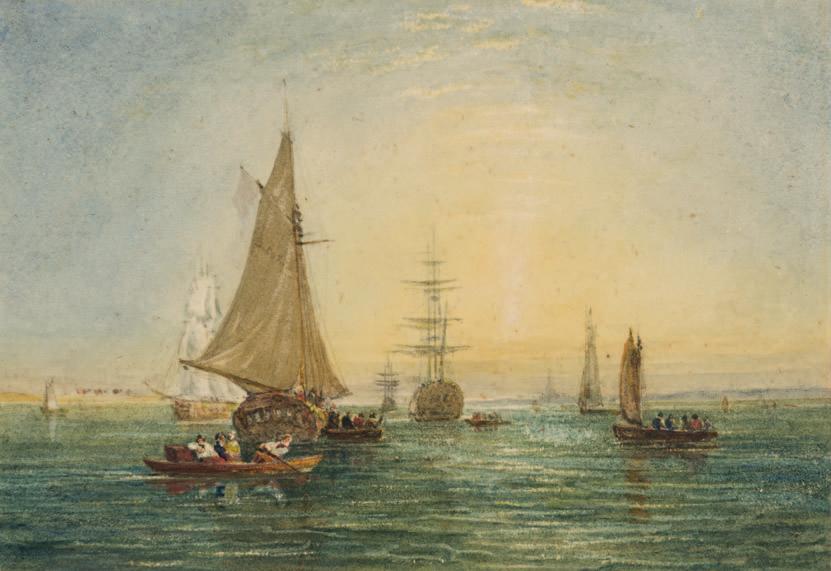
[cat.26]
David Cox (1783-1859)
Shipping off Greenwich
Signed on sail: D. Cox
Watercolour over traces of pencil heightened with bodycolour and scratching out
15.6 by 22.6 cm., 6 by 8 ¾ in.
Provenance:
Bought at the Fine Art Society, London, by 1962; By descent until 2019
This dates from circa 1830 when Cox drew a number of watercolours of boats on the Thames estuary.

[cat.27a]
David Cox (1783-1859)
Trees at Maxstoke Park, Warwickshire
Inscribed lower left: Maxstoke
Black chalk
17.8 by 25.6 cm., 7 by 10 in.
Provenance: With The Fine Art Society, London, 1946; John Marshall;
And by descent to the present private collector, Wiltshire
Exhibited: London, Leicester Galleries, Artists as Collectors, July-August 1963, no.126
The castle of Maxstoke was completed in 1345, is one of the oldest privately owned and continuously inhabited castles in England. It was commissioned by Sir William Clinton, 1st Earl of Huntindon. It was purchased by the Dilke (later Fetherston-Dilke) family in 1599, whose descendants remain in the castle. It lies about 15 miles East of Birmingham and is now the home of Maxstoke Park Golf Club.
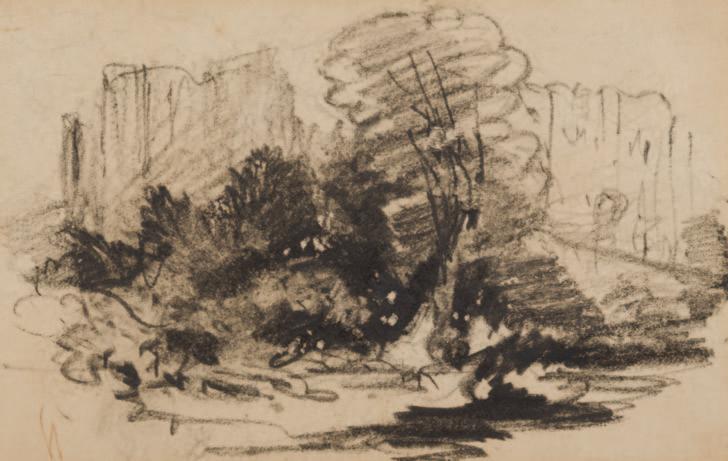
[cat.27b]
David Cox (1783-1859)
Kenilworth Castle, Warwickshire
Black chalk
8.6 by 13.7 cm., 3 ¼ by 5 ¼ in.
Provenance: With The Fine Art Society, London; Private Collection, Wiltshire
David Cox drew and painted Kenilworth Castle throughout his life. Perhaps his earliest known drawing of Kenilworth was from 1804, whilst a watercolour of the castle was amongst his last exhibited works in 1859. The present drawing is likely to date from the 1830s.
The present view was amongst the artist’s favourite viewpoints for capturing the castle, with the majestic trees framing or as in this instance, almost hiding the ruins. The artist produced several finished watercolours of Kenilworth from a similar vantage point.

[cat.28]
John Varley (1778-1842)
The Old Church, Hackney, London
Watercolour over pencil heightened with touches of bodycolour 27.8 by 37.7 cm., 10 ¾ by 14 ¾ in.
Provenance: With Spink, London; Anonymous sale, Sotheby's, 11th July 1990, lot 97; By descent until 2018
This depicts the sixteenth century church of St Augustine in Hackney, east London, which was demolished in 1798 to make way for a new church on the site dedicated to St John. The large funerary monument to the left survives. Varley was born in a house adjoining Hackney churchyard in 1778. Another version of this watercolour, dated 1830, is in the British Museum (see Lindsay Stainton, British Landscape Watercolours 1600-1860, 1985, no.110, pl.83).
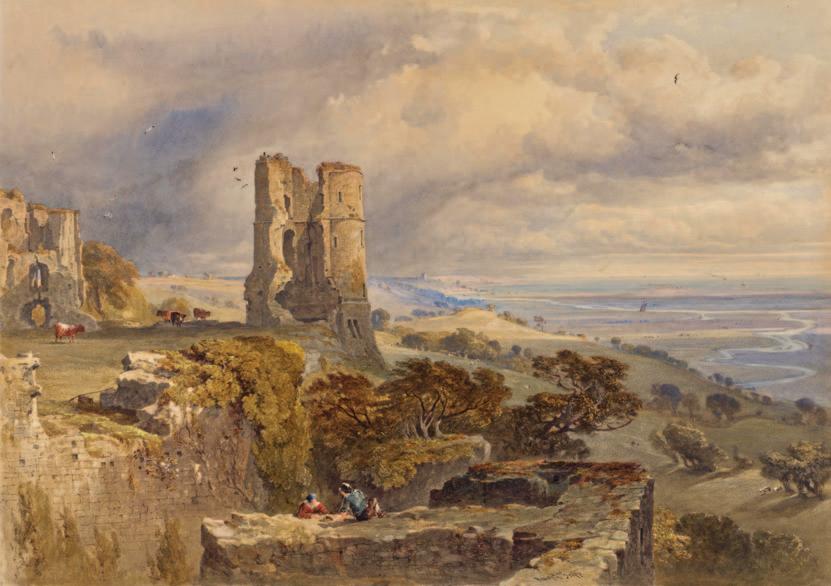
[cat.29]
George Arthur Fripp, R.W.S. (1813-1896)
Hadleigh Castle on the Coast of Essex
Signed lower right: George A. Fripp and signed on label attached to the backboard: 3/Hadley Castle/coast of Epsom/George Fripp
Watercolour over pencil heightened with bodycolour and scratching out 50.5 by 71.6 cm., 19 ¾ by 28 in.
Provenance:
William Balston, Springfield, Maidstone, 1855
Exhibited:
London, Society of Painters in Water-colours, 1855, no.58, bt. Balston for 40 gns as ‘Hadley Castle, Coast of Essex’
Fripp is likely to have been inspired by John Constable’s famous painting of Hadleigh Castle which has the same viewpoint. Constable’s painting, now in the Yale Center for British Art, was exhibited at the Royal Academy in 1829 but Fripp may have seen it when it was sold at Christie’s on 13th June 1851, lot 46.
Bristol-born Fripp travelled extensively throughout Britain, as well as spending seven months with William James Müller in Europe in 1834. He exhibited intermittently at the Royal Academy between 1838 and 1854 and regularly at the Old Watercolour Society from 1841. He became a member of the Society in 1845 and served as Secretary between 1848 and 1854.
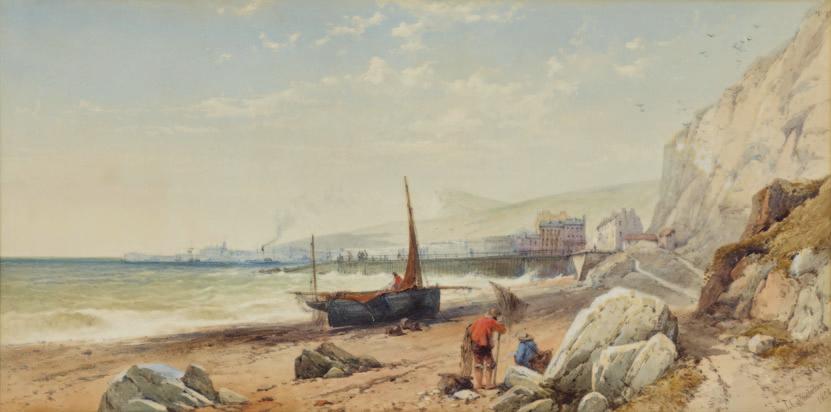
[cat.30a]
Thomas Charles Leeson Rowbotham (1823-1875)
Dover from the East Cliff
Signed lower right: T.L. Rowbotham/1854
Watercolour over pencil heightened with bodycolour 26.3 by 52.9cm., 10 ¼ by 21 in.
Provenance:
Bought by the present owner’s grandfather at the New Watercolour Society, 1854
Exhibited:
London, New Watercolour Society, 1854
This is an exceptional early examples of Rowbotham’s work. His father Thomas Leeson Rowbotham (1782-1853) was a well-known Bristol artist who taught his son to draw at an early age. He made his first sketching tour, to Wales, in 1847 and he exhibited at the New Watercolour Society from 1848. He succeeded his father as drawing master at the Royal Naval School, Greenwich. His later works are mainly of Italian Lake views and lack originality.

[cat.30b]
Thomas Charles Leeson Rowbotham (1823-1875)
Shipwreck by St Michael’s Mount, Cornwall
Signed lower right: T.L. Rowbotham Jnr
Watercolour over pencil heightened with bodycolour and scratching out 40.9 by 63.1 cm., 16 by 24 ¾ in.

[cat.31a]
Edward Lear (1812-1888)
Zante from the foothills of Mount Skopos, Greece
Inscribed and dated lower right: Zante (201.c)/goats 26. May. 5.30_6.P.M. Pen and ink and watercolour over pencil heightened with white 18.5 by 28.7 cm., 7 ¼ by 11 ¼ in.
In the foreground is the town of Zante or Zakynthos, the main town on the island of Zante, one of the Ionian Islands. Lear spent the winter of 1862-3 on Corfu and travelled round the Ionian Islands in April and May, In June he returned to England via Italy.
This sketch dates from 26th May 1863 and is numbered 201c. No. 210 from this trip, drawn at 5pm on 28th May, was with Guy Peppiatt Fine Art in 2017. Lear’s diary records that he arrived in Zante harbour on board the Europa at 6am on 26th May and wrote: ‘Zante looked gayer & more beautiful than ever: - brilliance & elegance are its chief characteristics’ and later in the day: ‘At 2 – out with G[iorgio] to a hill, where I drew Zante till 4: a fatiguing sketch: - then walked – examining other places till 6.30….’. Giorgio was Lear’s long term travelling companion and servant.
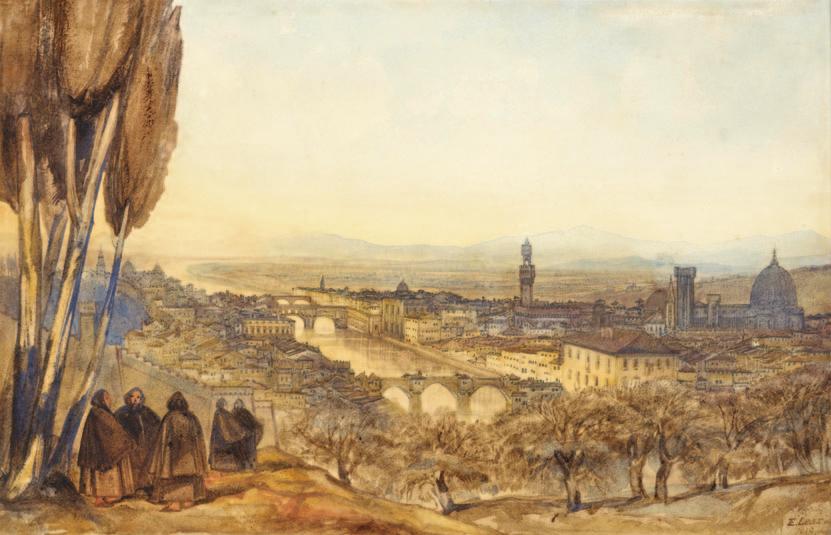
[cat.31b]
Edward Lear (1812-1888)
Florence from San Miniato
Signed lower right: E. Lear/1838
Watercolour over pencil heightened with bodycolour and gum arabic 19.3 by 30.2 cm., 7 ½ by 11 ¾ in.
Provenance:
With Davis Galleries, New York; Deane F. Johnson, his sale, Christie's, 18th November 2004, lot 70; By descent to the present owner
This dates from Lear's first European trip. He left England in the summer of 1837 and did not return permanently to London until the late 1840s. He reached Florence in November and recalled ‘the clear lilac mountains all round it - the exquisite walks on every side to hills covered with villages, convents and cypresses, where you have the whole city beneath youthe bustle of the Grand Duke's court and the fine shops - the endless churches - the Zebra Cathedral of black and white marble - the crowds of towers and steeples - all these make Florence a little Paradise in its way - if it were but hotter. - Oh! How I used to go shivering about!' (quoted in Jenny Uglow, Mr Lear - A Life of Art and Nonsense, 2017, pp.110-111). He left the city with some regret but the cold urged him southwards and he was in Rome in mid December.
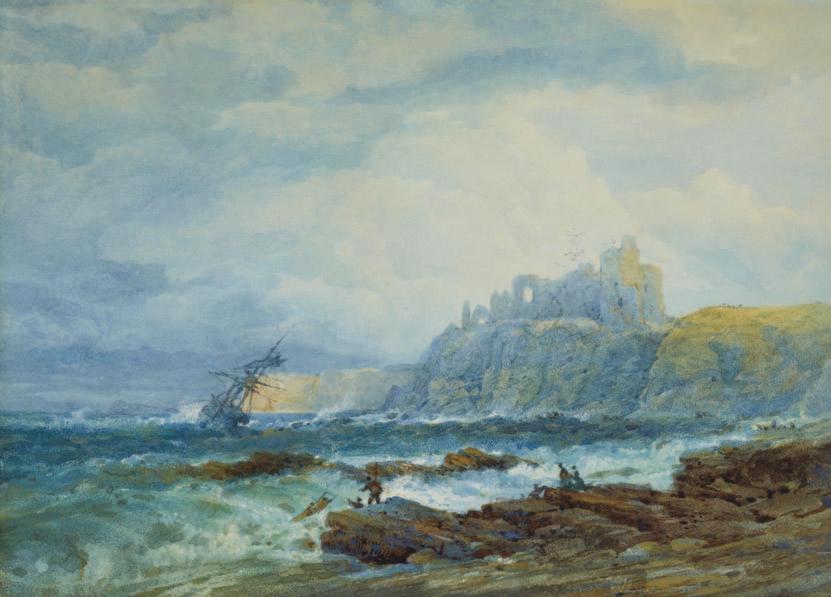
[cat.32]
Edward Duncan, R.W.S. (1803-1882)
Shipwreck off Tantallon Castle, Scotland
Signed lower left: EDuncan 1848
Watercolour over pencil heightened with bodycolour and scratching out 22.3 by 31 cm., 8 ¾ by 12 in.
Provenance:
Anonymous sale, Bonham’s Oxford, 28th November 2012, lot 126
Tantallon castle was one of the last great castles of Scotland built in the mid 14th Century by William Douglas, 1st Earl of Douglas. It was besieged several times in its history but after the damage caused by Oliver Cromwell’s army, it was abandoned.
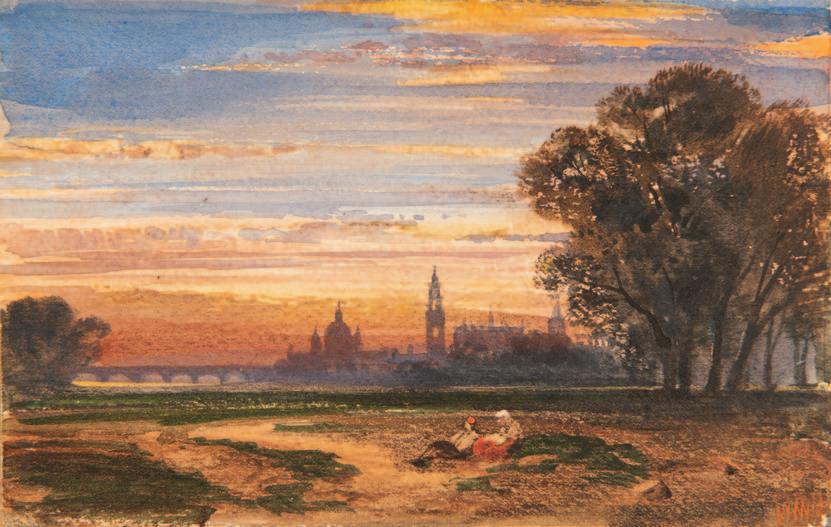
[cat.33]
William Wyld (1806-1889)
Dresden at Sunset
Signed in red lower right: WWyld
Watercolour heightened with bodycolour 12 by 19 cm., 4 ¾ by 7 ½ in.
This is a view of the left bank of the Elbe looking upstream with the Augustus Bridge to the left. The three visible monuments are, from left to right, the Frauenkirche (destroyed in World War II), the tower and nave of the Catholic Palace Church and the tower of the Dresden Schloss.
Another version of this view by Wyld is in the Victoria and Albert Museum (see Marcia Pointon, Bonington, Francia and Wyld, 1985, no. 29, ill. A smaller version was sold as part of the collection of Gerald Bauer at Christie’s on 22nd January 2003, lot 57 for a hammer price of £6,500.
A diplomat and later wine-merchant who spent most of his life in France, Wyld began his career in 1826 as Secretary to the British Consul in Calais, where he was a pupil of Francia. Strongly influenced by Bonington whose work he knew, Wyld visited Algeria in 1833 in the company of the French artist Horace Vernet.
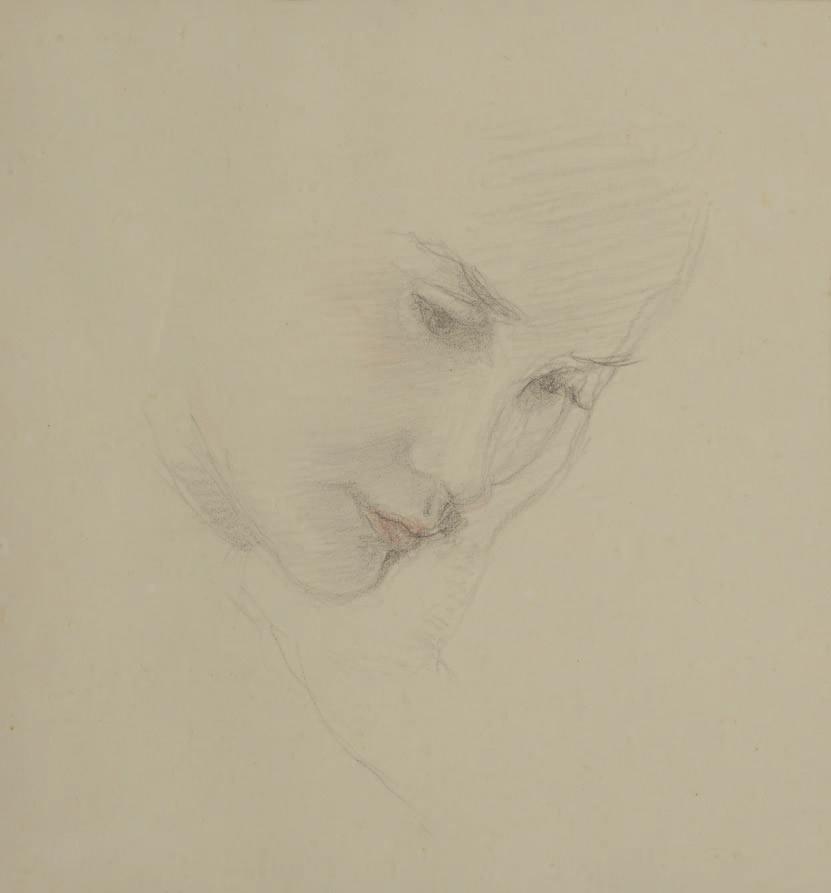
Kate Elizabeth Olver (1881-1960)
Portrait study of the Head of a Woman
Signed, inscribed and dated lower left: Perugia J Fullylove 1880
Watercolour over pencil heightened with scratching out 32 by 25.5 cm, 12 ½ by 10 in.
Provenance: Anonymous sale, Phillips 9th June 1986, lot 16, where bought by the present owner
This is a study for a portrait titled ‘Woman and Child reading’ sold at Christie’s on 9th November 1989, lot 67 for £15,400.
[cat.34a]
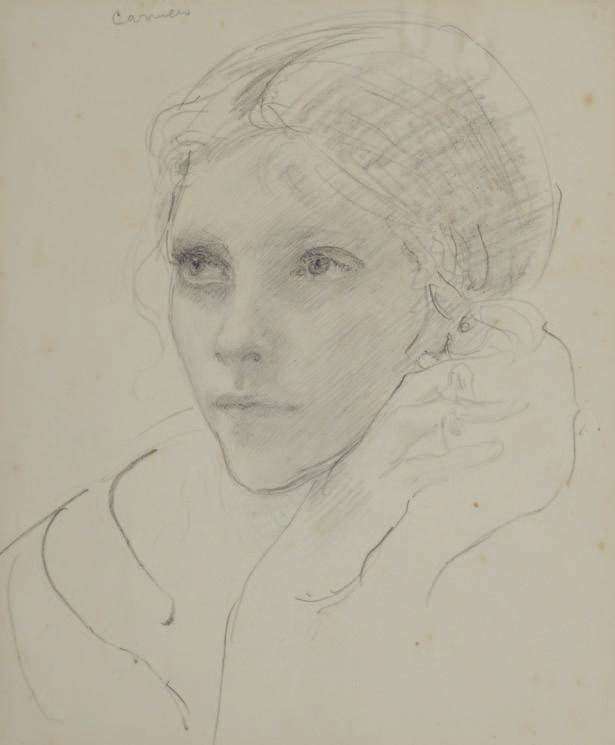
[cat.34b]
Kate Elizabeth Olver (1881-1960)
Study of the Artist’s Model Carmen
Inscribed upper left: Carmen Pencil
23 by 19 cm., 9 by 7 ½ in.
Olver used a model known as ‘Carmen’ in a number of paintings, most notably in a portrait in the Russell-Cotes Art Gallery, Bournemouth entitled ‘Casque d’or’ which translates as ‘Golden Helmet’, a reference to her golden hair. The portrait, and presumably this drawing, are datable to circa 1930. Olver exhibited a red chalk titled ‘Carmen’ at the Society of Women Artists in 1937, no.544.
Kate Olver was born in London and was the daughter of a Harley Street dentist. She studied at the Royal Academy from January 1901 and exhibited at the R.A., Society of Women Artists, the Royal Glasgow Institute and the Paris Salon. She was married to the artist and author Charles Samson Higgins (1893-1980).
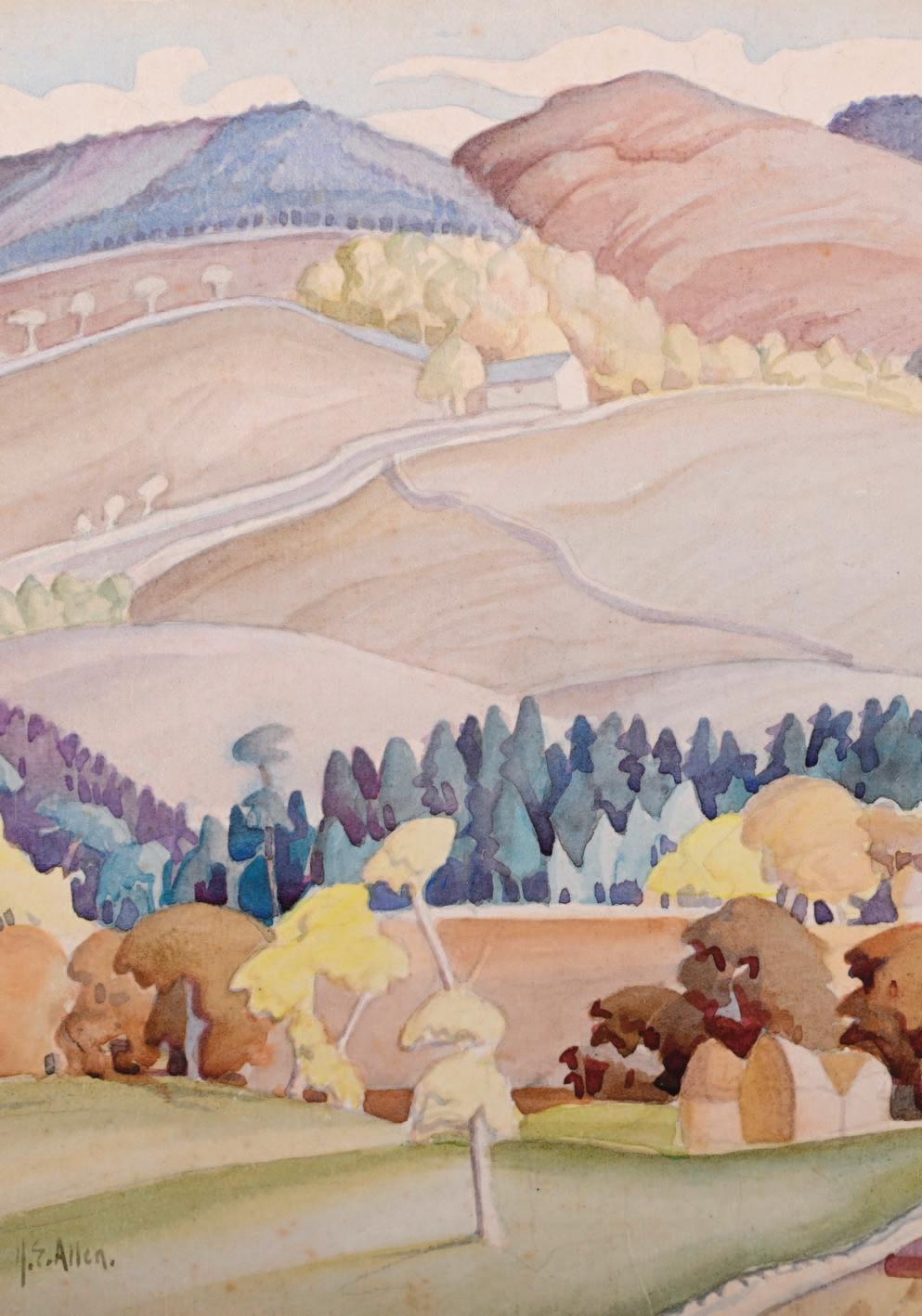
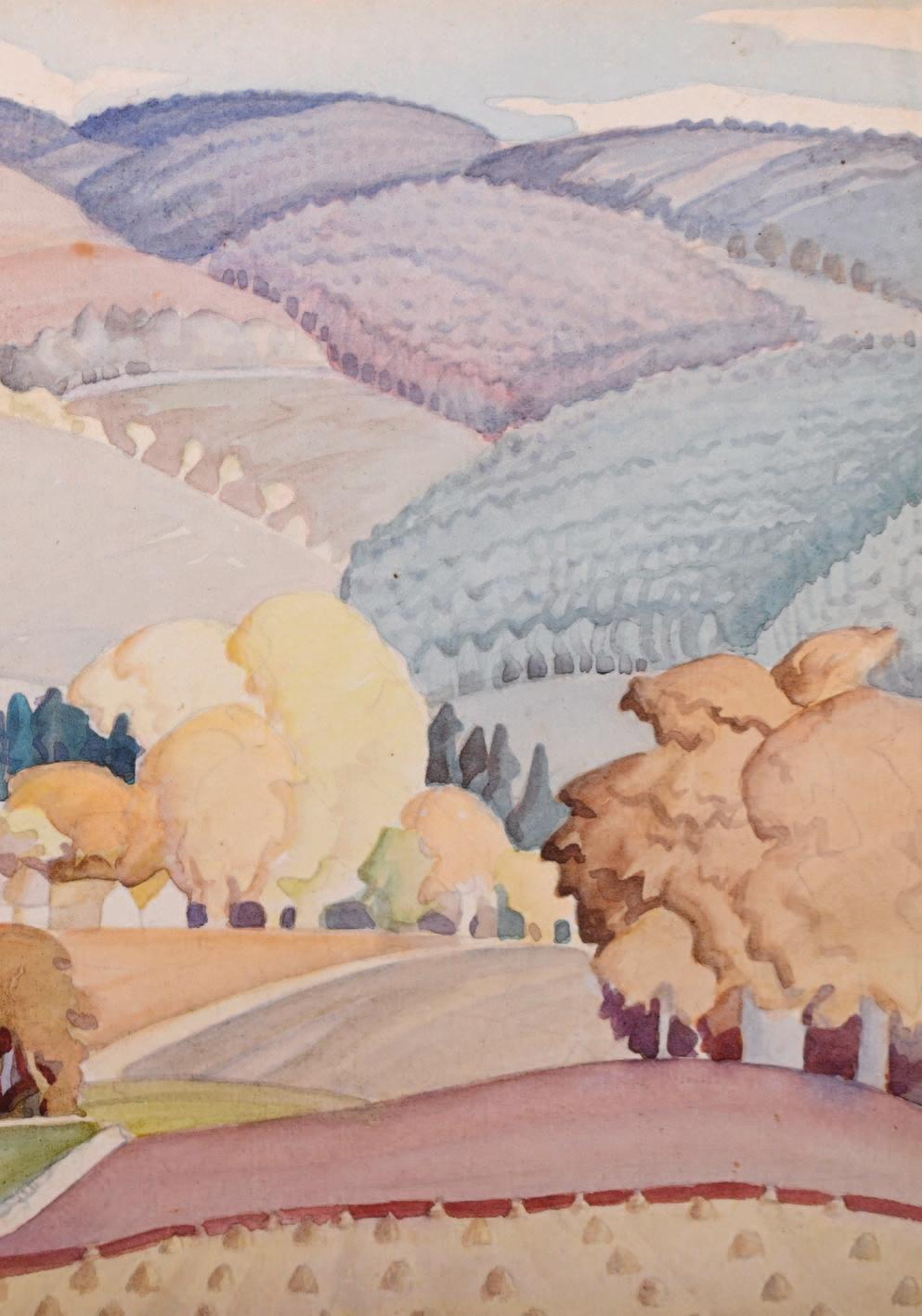
Harry Epworth Allen (1894-1958)
The Rolling Hills of Derbyshire, c.1936 [cat.56a]

[cat.35a]
Edward Lear (1812-1888)
A Panorama of the Italian Campagna
Pen and sepia ink, 14 by 36 cm, 5 ½ by 14 ins

[cat.35b]
Edward Lear (1812-1888)
Monte Cima from Lake Lugano
Inscribed and dated: 11.15 am/Lake Lugano/18 August 1878/Monte Cima
Pen and ink with light wash, 16.5 by 26 cm, 6 ½ by 10 ¼ ins
Lear recorded the following entry in his diary for 18th August 1878: “Perfectly clear sunrise…off with G by rail to Lugano…on board the “Generoso” steamer & started at 11.15. Pretty crowded. Sat at the end. Sun was very hot –continually drew…” (Edward Lear Diary for 18 August 1878, held by Houghton Library, Harvard University (MS Eng 797.3) (transcribed from microfiche of original manuscript). The Morgan Library and Museum hold another drawing drawn on Lake Lugano at 2.10 pm on the same day View of San Salvador from Caprino on Lake Lugano (inv. 1972.20:2).

[cat.36a]
Charles Heming Mason, ARA (1818-1872) Study for “Children Playing”
Oil on board
16.5cm by 25.4cm, 6 ½ by 10 ins
Provenance:With Thomas Agnew & Sons, Liverpool; A. T. Squarey; The Fine Art Society, December 1976.
Exhibited: Liverpool, Walker Art Gallery, Grand Loan Exhibition, 1886; London, The Fine Art Society, Etruscan School Exhibition, 1976, no. 41.
The following two oil sketches are the work of painters who are closely connected to the Etruscan School – a group of English painters, inspired by Italy who grouped themselves around the Italian painter Giovanni Costa in the early 1880s. As well as Heming Mason and Blake Richmond, other painters associated with the group included Frederic, Lord Leighton and George Howard. In contrast to the minute attention to detail associated with the PreRaphaelites, Etruscan painting was characterised by subtle tonality and with the creation of a more “emotional” impression of the subject. Costa himself expressed it as follows: “A picture should not be
painted from nature. The study which contains the sentiment, the divine inspiration, should be done from nature… The difference between the Impressionist, and the followers of the Etruscan School consists in this: Impressionists do what they see without reasoning or really feeling it; the Etruscan gets his impression, and works upon it, and develops it at home, adding to the skill of his hands and the exactness of his eye judgment and feeling as to form, and the direction of colour and lines…”. (quoted in Agresti, Olivia Rossetti. Giovanni Costa, his life, work, and times. London: Gay, 1907, p.213-16).
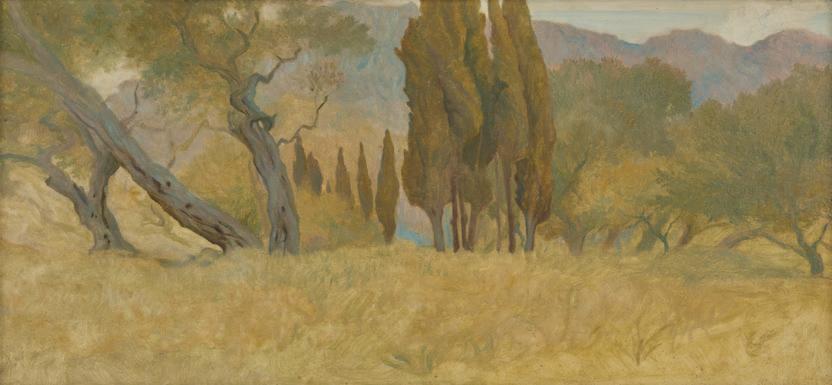
[cat.36b]
Sir William Blake Richmond, RA (1842-1921)
Olive Groves, Corfu
Inscribed in the artist’s hand on original label to reverse of board: Olives and Cypresses, Corfu/painted by Sir W.B.Richmond KCB RA/and given by him to Laura Pesel 1898 Oil on board, 18 by 38.5 cm, 7 by 15 ¼ ins
Provenance: Laura Pesel in 1898; by descent; part of a bequest to the McIntosh Gallery, University of Western Ontario, Canada from where de-accessioned
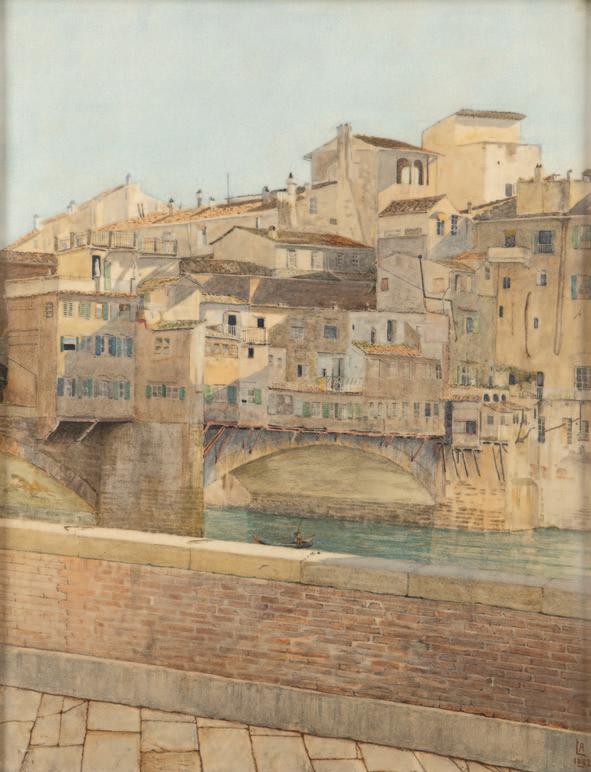
[cat.37]
Arthur Lucas (1845-1922)
The Ponte Vecchio, Florence
Signed with monogram and dated l.r.: AL/1882
Watercolour, 41.5 by 33 cm, 16 ¼ by 13 ins
Provenance: Chris Beetles
From the 1860s Florence would become the principal destination for artists who identified with the PreRaphaelite movement, painting the city’s architecture and monuments with same intensity of colour and detail that characterised much of the city’s great Quattrocento art (which such painters would of course be closely studying at the same time). A number of British artists settled in the city, amongst them John Wharlton Bunney, Henry Roderick Newman and Roddam Spencer Stanhope
(for a further discussion on this subject see Allan Staley’s essay Holy Lands in Allan Staley and Christopher Newall, Pre-Raphaelite Vision, Truth to Nature, Tate Publishing, 2004 (pp.100-103). Lucas’s view of the Ponte Vecchio from 1882 follows closely in the tradition of these artists and of course of John Ruskin whose painstaking watercolours of the city’s architecture from early in the previous decade bear some comparison with this fine work.
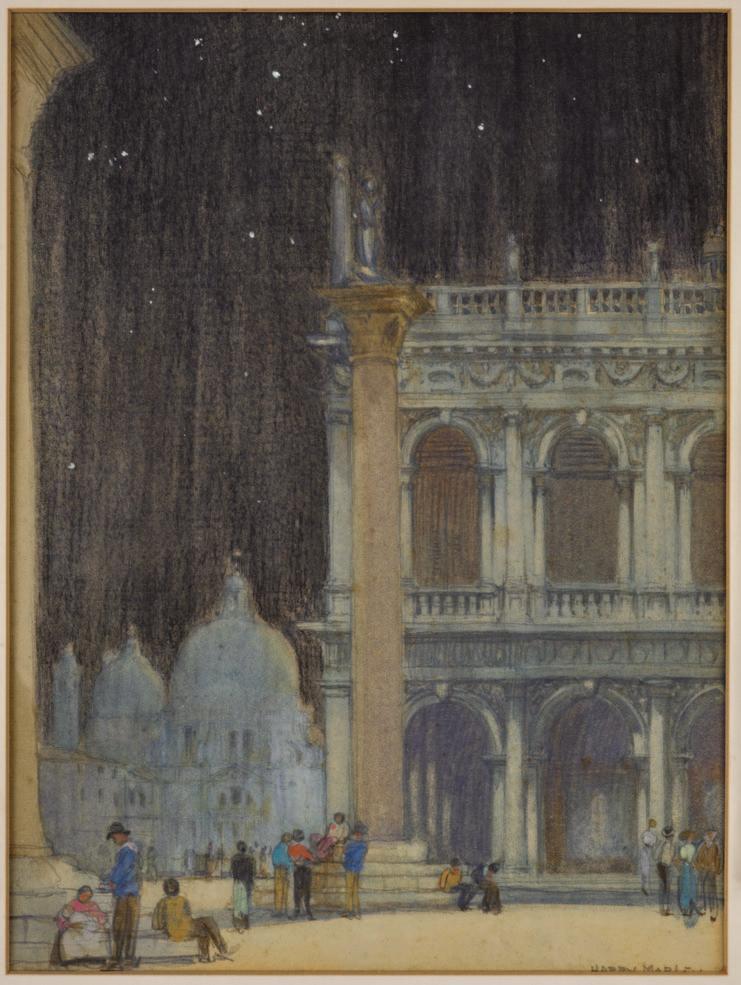
[cat.38]
Harry Morley, ARA (1881-1943)
St Mark’s Square, Venice, by Night
Signed l.r.: Harry Morley
Watercolour over pencil, 25 by 20 cm, 9 ¾ by 8 ins
Most of Morley’s watercolours of Venice date from the 1910s when he was given the commission to paint a significant quantity of illustrations for the essayist E.V.Lucas’s travel narrative of the city A Wanderer in Venice, published just before the outbreak of war in 1914.

[cat.39]
Andrew Gamley, RSW (1869-1949)
Washing the Dishes
Signed l.r.: Andrew Gamley
Watercolour with bodycolour, 50 by 60 cm, 19 ¾ by 23 ½ ins
Gamley, the younger brother of the sculptor Henry Snell Gamley RSA, became the first recipient of the prestigious Royal Scottish Academy Carnegie Scholarship in 1903. The result of this award was a trip to France, where he took afternoon classes at the Academie Julien under Jean-Paul Laurent. Whilst here, Gamley also took time to assimilate international modern art of the period including at the Pantheon where he noted “the great decorations by Puvis de Chavannes”. Gamley’s copy of one of
Puvis de Chavannes’s paintings there is now in the collection of the Royal Scottish Academy (acc.1992.224). Much of Gamley’s other work touches on European art of his period, including this fine domestic scene which has something of the character of Scandinavian art and painters like Vilhelm Hammershøi. Gamley later established himself as a portrait and landscape painter and was vice president of the Royal Scottish Watercolour Society.
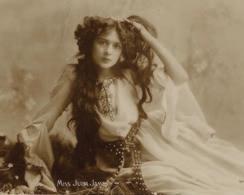

[cat.40]
Philip de László, PRBA (1869-1937)
Julia James, 1917
Charcoal, 75.6 by 55.3 cm, 29 ½ by 21 ¾ ins
Provenance: In the possession of the artist on his death; Thence by descent; Christie’s South Kensington, 13 June 1997, lot 68; Private Collection, UK.
Literature: Studio Inventory, p.144 (12): Study of a Girl. The de László Archive Trust, ‘The Catalogue Raisonné of Works by Philip de László (1869-1937) [online]’, no.2952.
Julia James (1890–1964) was a celebrated English actress of the Edwardian era, appearing at the Gaiety Theatre in The Girls of Gottenburg, Havana and Our Miss Gibbs as well as in several productions at L'Olympia theatre in Paris (see fig.1). She was painted by de László following a commission from St Dunstan’s charity in 1916. He later executed three
further more informal portraits of her in May 2017 for his own pleasure. The present portrait drawing is one of these and remained in the artist’s studio until his death. Another (studio inv.no.5817) was given to James by the artist for agreeing to sit for him.
Fig.1
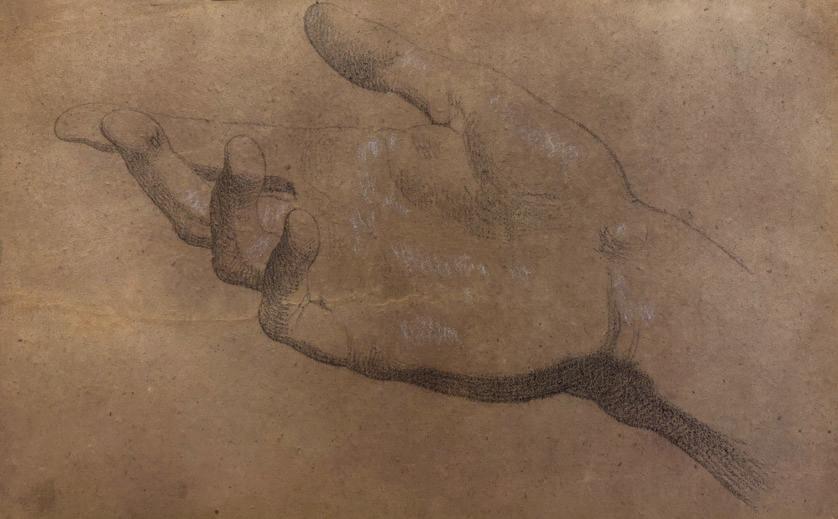
[cat.41]
George Frederic Watts, OM, RA (1817-1904)
Study of a Hand
Black and white chalk on brown paper, 18.5 by 29.5 cm, 7 ¼ by 11 ½ ins
A fine example of one of Watts’s Michelangelesque anatomical studies. The attribution to Watts was confirmed by Richard Jefferies in 2003.
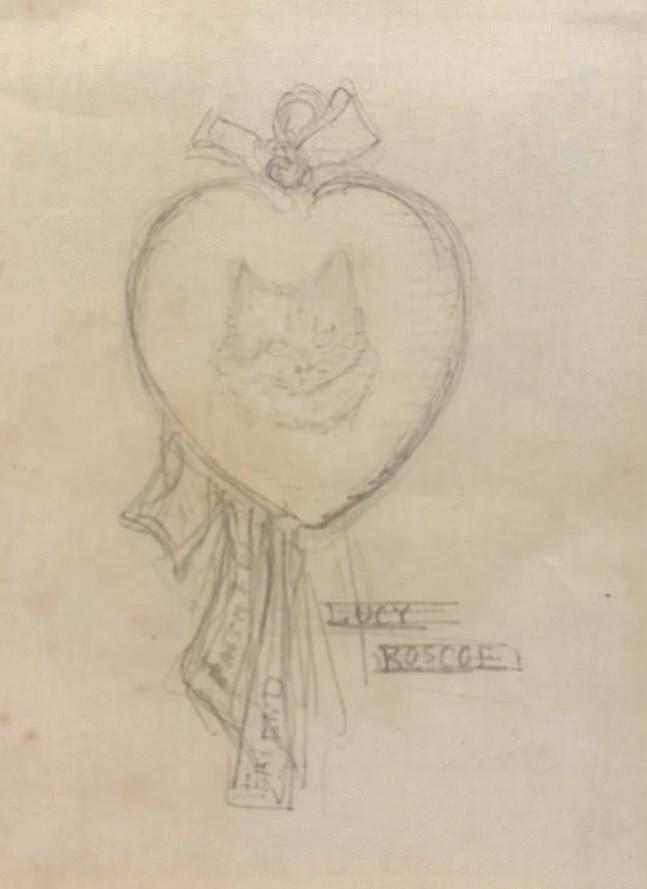
[cat.42]
Beatrix Potter (1866-1943)
Vignette with a study of a Kitten for Lucy Roscoe
Inscribed: Lucy Roscoe and Friend (on a ribbon)
Pencil, 8.5 by 6.5 cm, 3 ¼ by 2 ½ ins
This charming vignette, possibly a design for a bookplate, was made for Potter’s aunt Lucy, Lady Roscoe. Lucy was the sister of Potter’s father Rupert and later married the distinguished British chemist Sir Henry Roscoe. Original drawings by Beatrix Potter are very rare and although small in scale, the
present work is full of the subtle whimsical detail so central to Potter’s work as an illustrator. To the centre of a heart broach is a sketch of a kitten’s head, which is strongly reminiscent of her much-loved feline characters, Tom Kitten and his sisters Mitten and Moppet.

[cat.43a]
Arthur Wragg (1903-1976)
Venetian Carnival
Watercolour with gouache and Indian ink on board, 38 by 49.5 cm, 15 by 19 ½ ins
In the early 1920s, following his move to London, Wragg established a practice as a busy magazine illustrator. His was a regular contributor to such titles as Nash’s Magazine, Sunday Magazine and women’s magazines including Woman’s Journal and Woman’s Pictorial – his decorative, almost Aubrey Beardsley-like late Art Nouveau style greatly
appealing to his readers. By the early 1930s he had become one of the country’s leading Political illustrators, his work The Psalms of Modern Life (published in 1933) running to ten reprints within the first three years of its publication and being sold across the world.
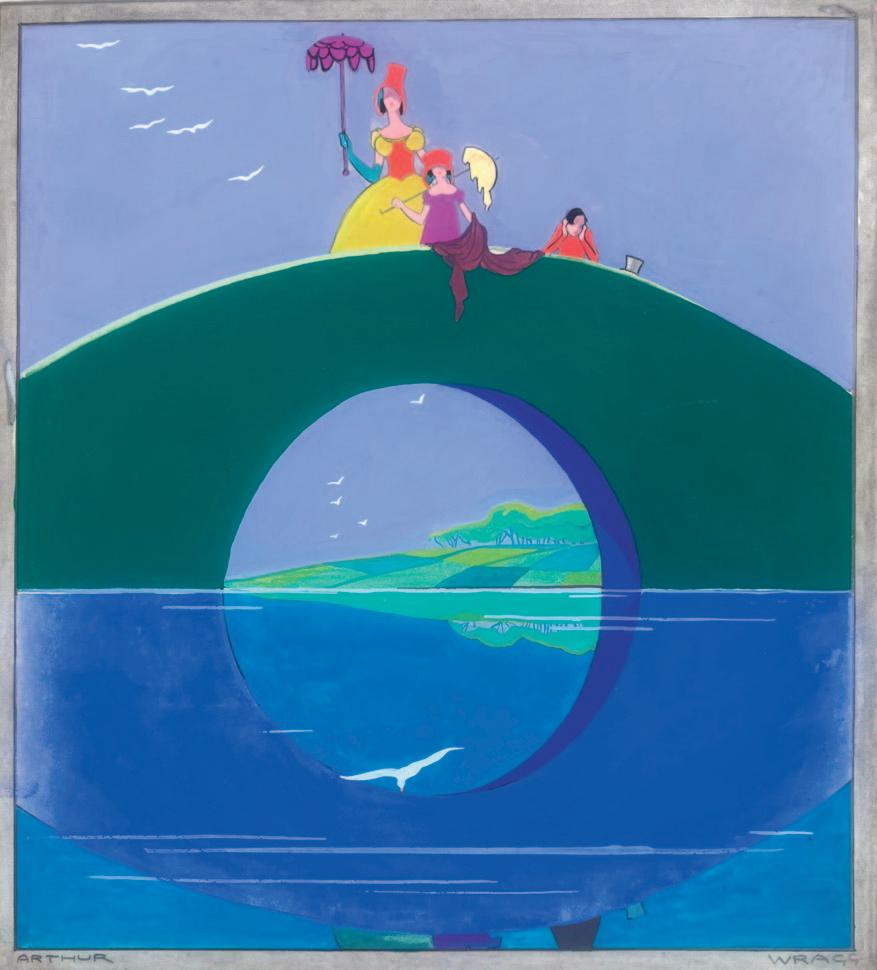
[cat.43b]
Arthur Wragg (1903-1976)
The Bridge
Signed l.l. and l.r.: Arthur/Wragg
Watercolour with gouache over ink on board, 36 by 32.5 cm, 14 ¼ by 12 ¾ ins

[cat.44a]
Winifred Nicholson (1893-1981)
Cows Ambling Through a French Hill Town
Watercolour over traces of pencil, 44.5 by 64 cm, 17 ½ by 25 ¼ ins
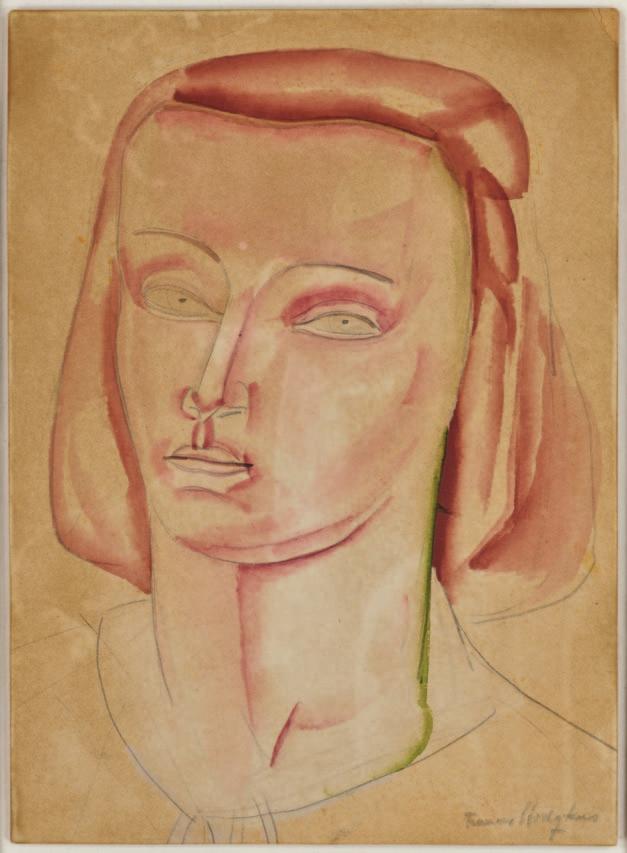
[cat.44b]
Frances Hodgkins (1869-1947)
Portrait of a Woman
Signed l.r.: Frances Hodgkins
Watercolour and wash over pencil, 23 by 16 cm, 8 ½ by 6 ¼ ins
Provenance: acquired by the previous owner from the Gillian Jason Gallery c.1980
In the immediate aftermath of the First World War, Frances Hodgkins’s style would undergo a radical change that would establish her in the following decade as one of the key figures in British modernism. Born in New Zealand, her early work reflects the more Edwardian art of her contemporaries and it was through working with Sir Cedric Morris during the War, before later travelling
to the France, that would help introduce this new approach to painting. This strong portrait is typical of the more abstracted, simplified style associated with her modernist phase. In 1929 she joined the highly exclusive Seven and Five Society working alongside artists such as Henry Moore, Barbara Hepworth and Ben Nicholson.

[cat.45a]
Augustus John, OM, RA (1878-1961)
Lyndra Standing, playing a Lute c.1910
Signed l.r.: John
Pencil, 43 by 25 cm, 17 by 9 ¾ ins
Provenance: Christie’s King Street, British Art on Paper, 5 June 2007, lot 111
The drawings of standing women that John executed between about 1907 and 1910 are some of the most impressive works he ever completed on paper. His sitters were generally members of the bohemian circle he mixed with at the time – above all his muse and partner Dorelia and Euphemia Lamb (the wife of his close friend Henry Lamb). Another figure from the same circle was Edith Lees, the wife of the Australian-born painter Derwent Lees, who was also known as “Lyndra”. Her strong, sometimes androgenous, features (as depicted in this fine picture) greatly appealed to John who depicted her in life drawings as well as allegorical subjects.
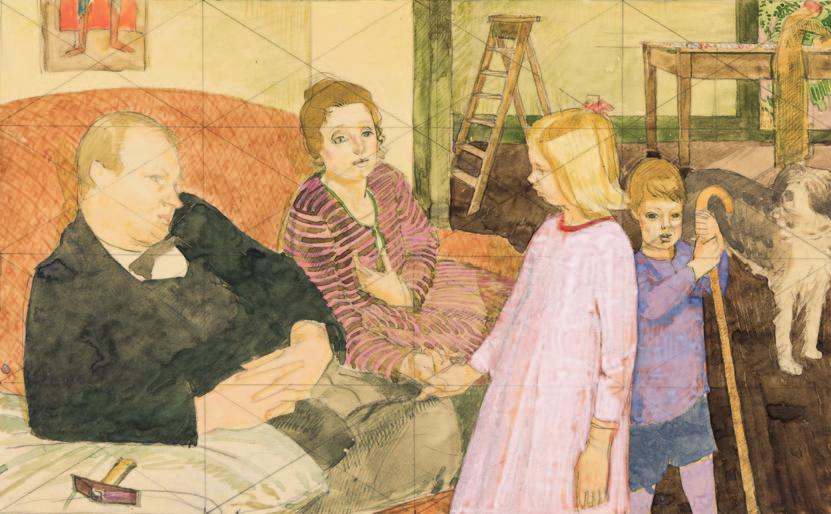
[cat.45b]
Henry Lamb, RA (1883-1960)
Study for “The Anrep Family”, c.1920
Watercolour and gouache over pencil, 26 by 37.5 cm, 10 ¼ by 14 ¾ ins
Lamb met the Russian-born mosaicist Boris Anrep when the two artists were students at the Academie Julien in Paris in 1908. The portrait he painted of Anrep and his family in 1920 would be the first in a series of ambitious group portraits that would define much of his work in the early 1920s. They are arguably amongst his finest and most individual works. The highly unconventional composition of Lamb’s portrait hints at the intrinsic awkwardness of the Anrep’s marriage (Helen Anrep would leave Boris in 1925 to live with Roger Fry, partly on account of Anrep’s mistress Marouska Volkova whose figure appears in the distance to the right of this study). This is one of at least three finished colour studies for the final painting which Lamb sold to the Museum of Fine Art in Boston in 1932. The family dog appears to the right of the picture (although it was omitted from the final painting) as does Anrep’s mosaicist’s hammer (on the chair to his right). Anrep would later go on to complete fine work in mosaic in the National Gallery, the Bank of England and Westminster Cathedral.
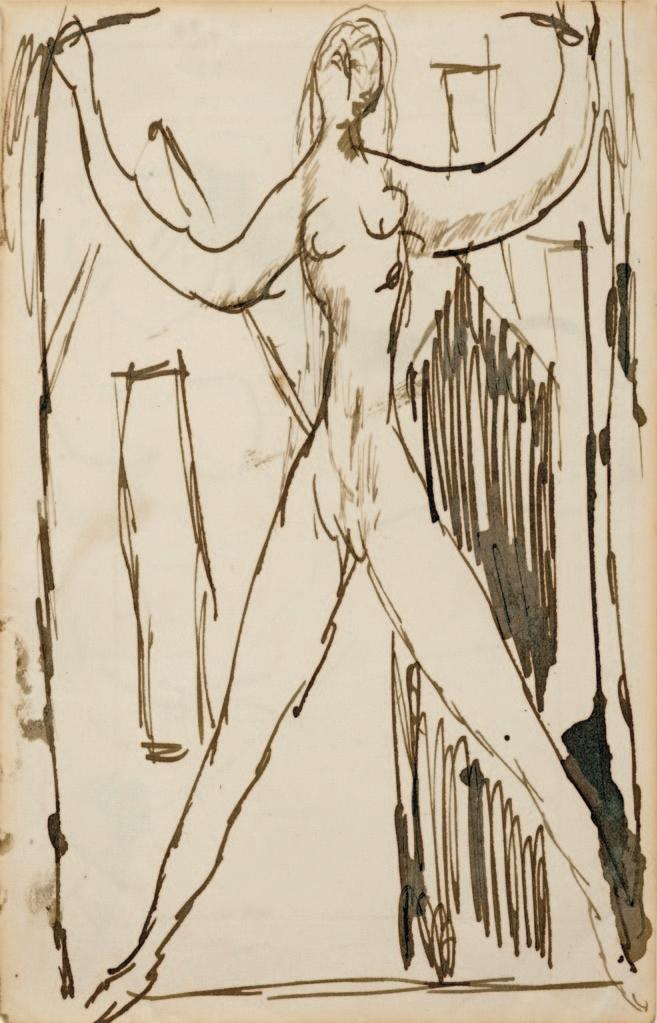
Duncan Grant (1885-1978)
Standing Female Nude with Raised Arms, c.1916
Pen and sepia ink, 17.5 by 11 cm, 6 ¾ by 4 ¼ ins
Provenance: The Estate of David ‘Bunny’ Garnett (1892-1981) (the artist's son-in-law); with The Bloomsbury Workshop, London
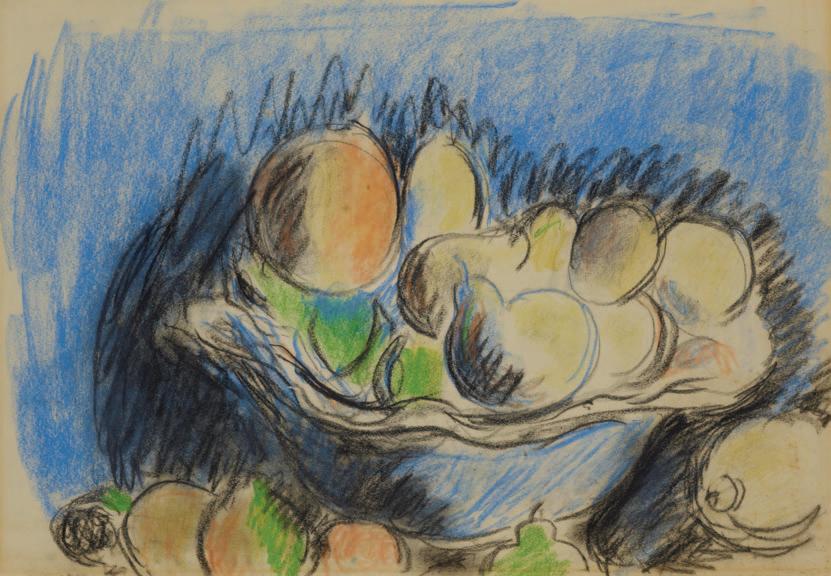
[cat.47]
Sir Matthew Smith (1879-1959)
Still Life with Fruit in a Bowl
Coloured chalks, 34 by 49cm, 13 ¼ by 19 ¼ ins
Provenance: Browse & Darby, Cork Street, London

[cat.48a]
Christopher Richard Wynne Nevinson, ARA (1889-1946)
View across an exotic river valley, for Cadbury’s
Signed l.r.: C.R.W. Nevinson
Wash over pen and pink ink, 17.5 by 27 cm, 6 ¾ by 10 ½ ins
Provenance: executed as a design for Cadbury’s, 1932, from whom presented to a former employee on their retirement Exhibited: The Leicester Galleries, London
In 1932, as a response to the Gorell Commission on Art and Industry, Cadbury’s embarked on an ambitious project to commission designs for their latest chocolate boxes from leading artists of the period. The result was a range of chocolates which employed designs from ten leading artists: Laura
Knight, Arthur Rackham, George Sheringham, Edmund Dulac, Dod Procter, Ernest Procter, Arthur Watts, Mark Gertler and Nevinson. The present work is Nevinson’s original design for what was to illustrate the company’s exotic collection later that year, the composition eventually being worked up into a finished painting of the same subject.

[cat.48b]
David Bomberg (1890-1957)
Sappers at Work under Hill 60, 1919
Signed l.r.: Bomberg/19
Pen and black ink with brown wash, 26.5 by 20.5 cm, 10 ½ by 8 ins
Towards the end of the First World War, Bomberg was commissioned by the Canadian War Memorials committee to paint a tribute to a Canadian company of sappers from the Royal Engineers who died tunnelling under St Eloi on the Western Front in 1916. An initial more futurist version of the event was rejected, but the final painting (a study of which is in the Imperial War Museum (acc. ART 2078)) is full of the energy and geometric form that characterises the best of his futurist and vorticist-inspired work of the 1910s. The present work is a strong example of one of the artist’s studies for this commission.

[cat.49a]
John Minton (1917-1957)
Jazz Session – possibly for “Our Time”, c.1949
Pencil, 18 by 27 cm, 7 by 10 ½ ins
Provenance: the estate of Elinor Bellingham Smith (the artist’s executor)
Minton was a frequenter of jazz bars in Soho and a flamboyant figure in the neighbourhood’s night life. This swift sketch, probably made on the spot, may relate to a design Minton created for the left-leaning arts magazine
Our Time in the summer of 1949 (see fig.2).
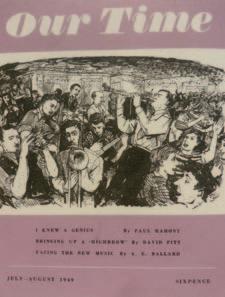
Fig.2

[cat.49b]
John Minton (1917-1957)
The Desolate Stage
Signed and dated l.r.: Minton 1939
Pen, ink and wash, 30 by 47 cm,12 by 18 ½ ins
Provenance: the John Constable Collection
Exhibited: John Minton – A Centenary, Pallant House Gallery, Chichester, July 1 – October 1 2017, cat.14, Fig. 7 page 15, illustrated in colour
Literature: Frances Spalding, The Real and the Romantic, English Art Between the Two World Wars, Thames & Hudson, 2022, p.356-57 (illustrated in colour)
Frances Spalding writes of the present work: “… a scatter of ingredients create a tense, theatrical scene under a darkening sky, evoking uncertainty and fear. The precise narrative is unclear, although the decision to subvert the norm and portray the isolated reclining male nude ...almost certainly relates to Minton’s exploration of his hidden homosexuality. But personal content, dreams or fantasies do not occlude the way this drawing also catches the mood of the day fostered by the imminence of war.” Frances Spalding, The Real and the Romantic, British Art Between the Wars, Thames & Hudson, 2022, p.356
This major early Minton drawing is one of the first that explores the themes of Neo-Romanticism that he adopted from the example the French artist Christian Berard and the Paris-based Russian painters Eugene Berman and Pavel Tchelitchew. Berman in particular, his work incorporating imaginative sometimes surreal scenes into theatrically architectural settings, had the strongest influence on Minton. In 1939 he visited the Provençal town of Les Baux where Berman had painted, this scene providing evidence of Minton’s own individual take on this very particular strain of NeoRomanticism.

[cat.50]
Reginald Hallward (1858-1948)
A Burial by Moonlight
Chalks on blue paper, 21.5 by 28 cm, 8 ½ by 11 ins
Exhibited: the Barbican Art Gallery, London, The Last Romantics, 1989, no.216
Dated by John Christian to c.1930 in his catalogue The Last Romantics, it has been suggested that the present work shows the influence of Blake’s Procession from Calvary which had been in the Tate collection since 1884 and which was a work that was doubtless known to Hallward.
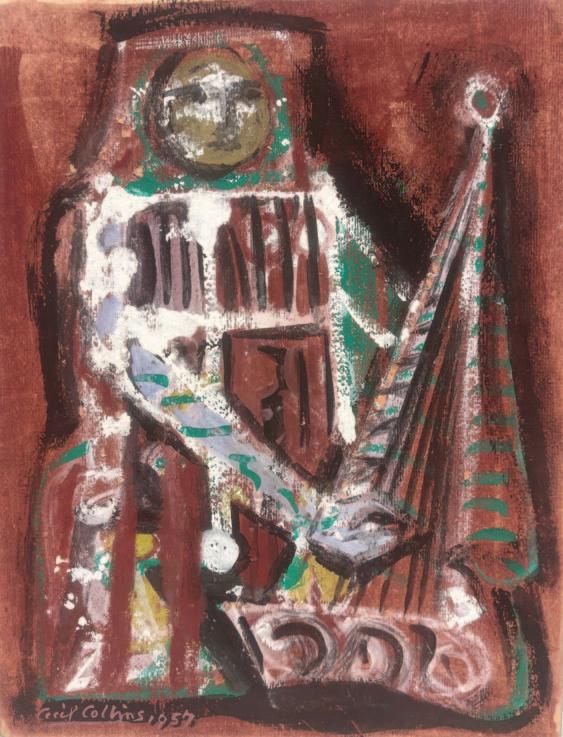
[cat.51]
Cecil Collins (1908-1989)
Standing Musician
Signed l.l.: Cecil Collins/1957 with further inscription (verso) “Musician” (1957) Gouache/ by Cecil Collins/ 15 Selwyn Gardens Cambridge England/ Feb 1957
Gouache with watercolour over brush and ink, 28.5 by 22 cm, 11 ¼ by 8 ½ ins
Provenance: acquired by the family of the present owners from Crane Calman Gallery in January 1968
Exhibited: Gouaches and Watercolours by Cecil Collins, Crane Calman Gallery, 1967, illustrated in colour on the cover of the catalogue
The visionary Neo-Romantic painter Cecil Collins was one of the most original figures in mid twentieth century British art. Claimed as a surrealist soon after leaving the Royal College of Art, his work was included in the International Surrealist exhibition in London in 1936. His influences ranged from Paul Klee who he had encountered in Paris to Eric Gill and David Jones. Like the latter, he completed a number of significant religious
commissions, including an altar front for the St Clement Chapel at Chichester Cathedral in 1972. This fine example of Collins’s 1950s work has been in the same collection since it was acquired in a oneman show of the artist’s work held at the Crane Calman Gallery in 1967. It was painted two years before Collins’s major retrospective at the Whitechapel Gallery in 1959.

[cat.52a]
Sir Cecil Beaton (1903-1980)
Elegant Lady in a Ballgown for “Adriana Lecouvreur”
Monochrome watercolour over ink, 26.5 by 17 cm, 10 ½ by 6 ¾ ins
Provenance: Christie’s, The Cecil Beaton Studio Sale, 21st June 1988, lot 164 (part)
Beaton’s designs for the 1962 Metropolitan Opera Production of Francesco Cilea’s opera Adriana Lecouvreur are amongst his most exuberantly rococo in style. The opera is a largely fictionalised account of the life of the celebrated French actress Adrienne Lecouvreur (1692–1730). First performed in 1902, the work is often cited as having amongst the most confusing texts in opera, although it still remains in
the mainstream repertoire, its titular lead being played by many of the leading sopranos of the last century. Labour strikes caused the Metropolitan Opera’s 1961-62 season to be cancelled but Beaton was still paid for his design work on the production. It was staged in the following season with a scaled back set design.
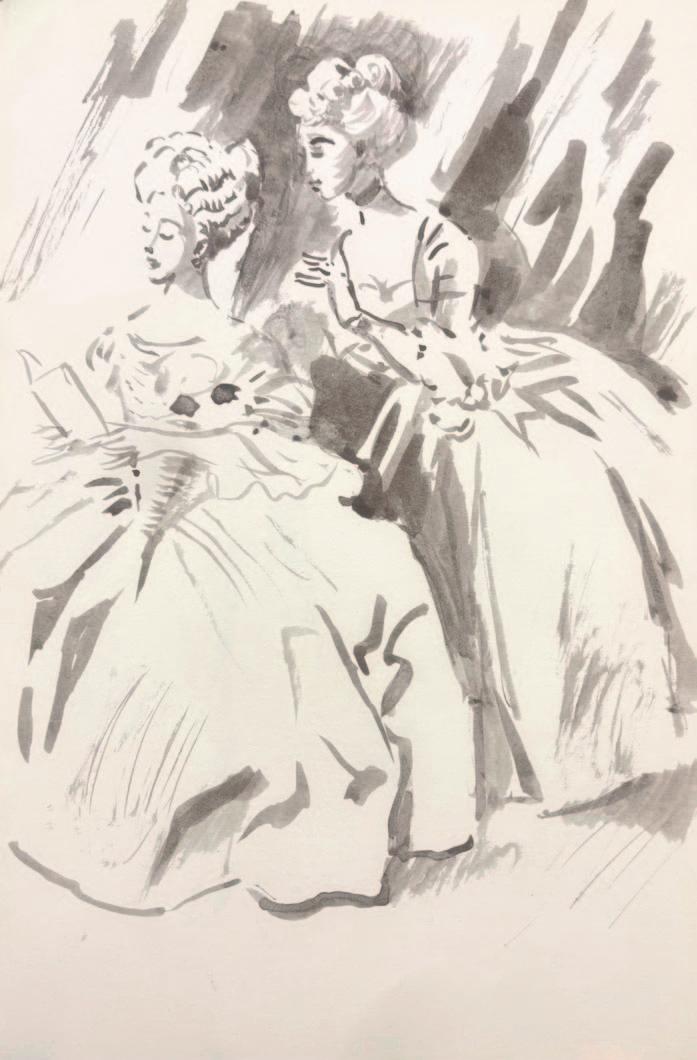
[cat.52b]
Sir Cecil Beaton (1903-1980)
In the Boudoir for “Adriana Lecouvreur”
Monochrome watercolour over ink, 26.5 by 17 cm, 10 ½ by 6 ¾ ins
Provenance: Christie’s, The Cecil Beaton Studio Sale, 21st June 1988, lot 164 (part)
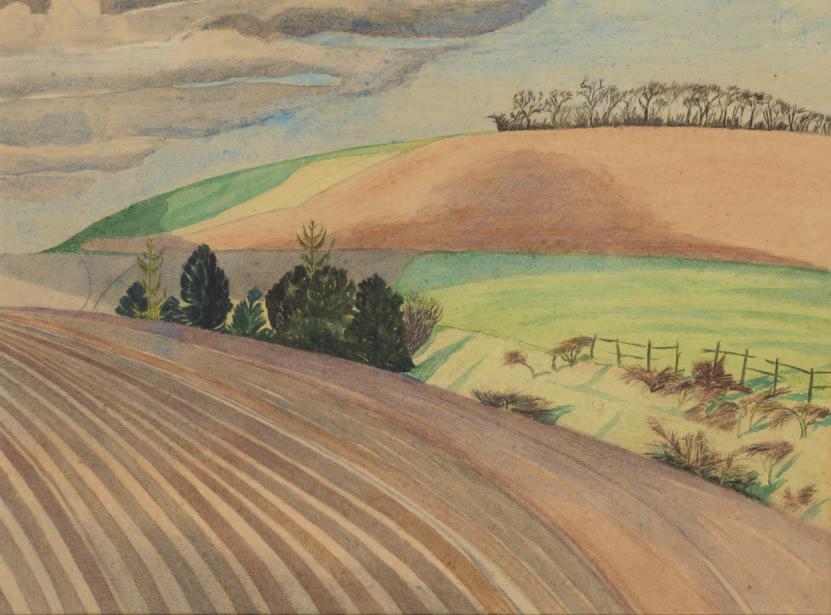
[cat.53a]
John Nash, RA (1893-1977)
Ploughed Fields on the Downs
, c.1912
Watercolour and wash over pencil, 36.5 by 50 cm, 14 ¼ by 19 ¾ ins
Provenance: from the artist to his friend, the painter Claughton Pellew
This fine example of John Nash’s early work was executed under the influence of his friend and fellow painter Claughton Pellew (who also owned this watercolour). Nash and Pellew had gone on a walking tour to Norfolk in 1912, a trip that helped to mould Nash as an artist – teaching him to focus on training the memory to record his subject and on the making of methodical notes of what he could see. Such works have a remarkable clarity that contrasts with his (sometimes) softer, later work. The style of his early work proved popular and at a landmark
joint show at the Dorien Leigh Gallery in 1913 with his brother Paul Nash, it would be John who went on to sell the most work. Subsequent recognition would lead him to become a founder member of the London Group in 1913 and the Cumberland Market Group (alongside Robert Bevan, Harold Gilman and Charles Ginner) in 1915. The location of the present work is not explicitly identified, although it is likely to be the Chiltern landscape near Nash’s home in Buckinghamshire. We are grateful to Andrew Lambirth for his assistance.

[cat.53b]
John Nash, RA (1893-1977)
Liner by the Crossing between the Roseland Peninsular and Feoch, Cornwall
With colour notes
Watercolour and wash over pencil, 21.5 by 29 cm, 8 ½ by 11 ½ ins

[cat.54]
Audrey Weber (1898-1981)
Walkers on the Surrey Hills for “Hills of the South”
Signed l.r.: Audrey Weber
Watercolour, 18.5 by 27 cm (7 ¼ by 10 ¾ ins)
Literature: S.P.S.Mais, Hills of the South, Southern Railway Company, 1939 (illustrated as a colour plate)
Weber worked for Southern Railways in the 1930s, with countryside walks being her signature subject matter. She designed a series of celebrated posters for the company on the subject of rambles in the mid-1930s, selling the idea of walking in the south and west of England and throughout the seasons of the year (see fig.3). The present work is the original artwork for an illustration from the book Hills of the South, published by Southern Railways in 1939 as a guidebook for Sussex and Surrey and for the local walks accessible to the train passenger. The present work shows Conyhurst Hill in Surrey, Weber’s electric colours being painted with the vibrant tones of the printed illustration in mind.

Fig.3
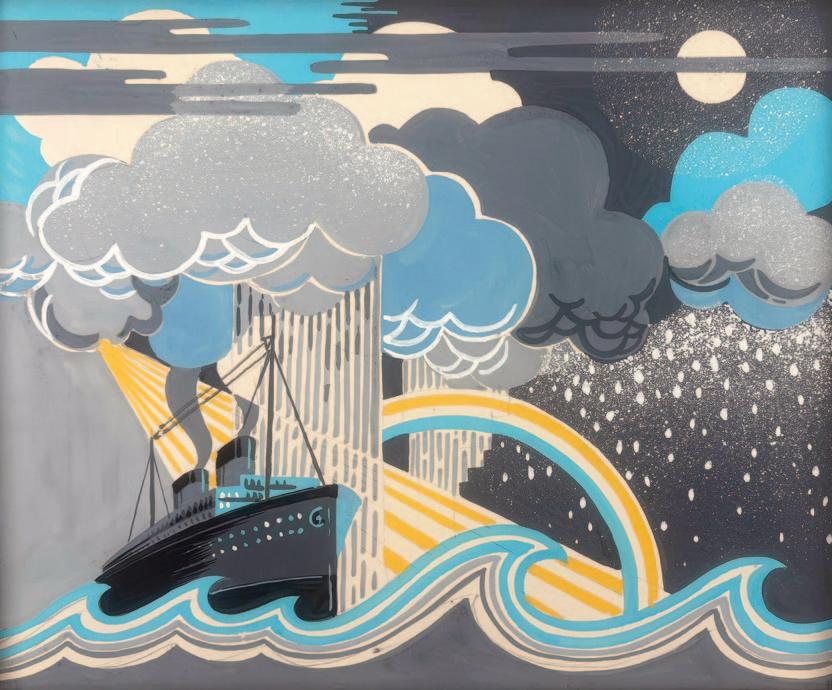
[cat.55]
Albert Edward Halliwell (1905-1987)
The Ocean Liner
Design idea for a Travel Poster, c.1928
With the artist’s address stamp (verso) Gouache, 22.5 by 27.5 cm, 8 ¾ by 10 ¾ ins
Halliwell, who studied at Stockport School of Art and the Royal College of Art is at his best in the commercial artwork he created in the 1920s which is amongst the best of the English Art Deco. As well as posters for London Transport, Southern Electric and Imperial and International Communications he made packaging design for firms such as Bird's Custard and Melias Coffee. Latterly he was an influential teacher in the field of commercial design at both Camberwell and Central School of Arts and Crafts.
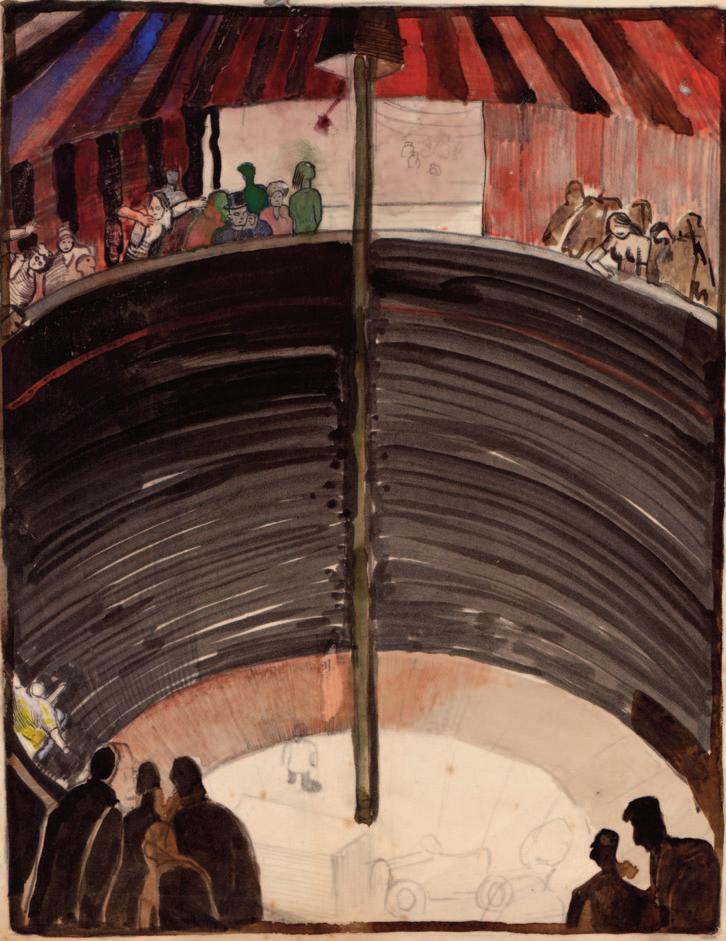
Harry Epworth Allen (1894-1958)
Study for “The Wall of Death”
Gouache and watercolour over pencil, 21.5 by 16.5 cm, 8 ½ by 6 ½ ins
Dating from 1936, the present work is a study for one of Epworth Allen’s most original and dynamic works in tempera, The Wall of Death, now in The Laing Art Gallery, Newcastle (inv.F13744). The picture shows a Wall of Death, one of the most popular circus side shows from around the 1920s
onwards. The structure was a barrel-shaped board on which a stunt motorcyclist would perform tricks, mostly involving the building-up of terrifyingly excessive speeds. Allen’s depiction is as much a study of the reaction of an enthralled audience, than of the thrilling event itself.
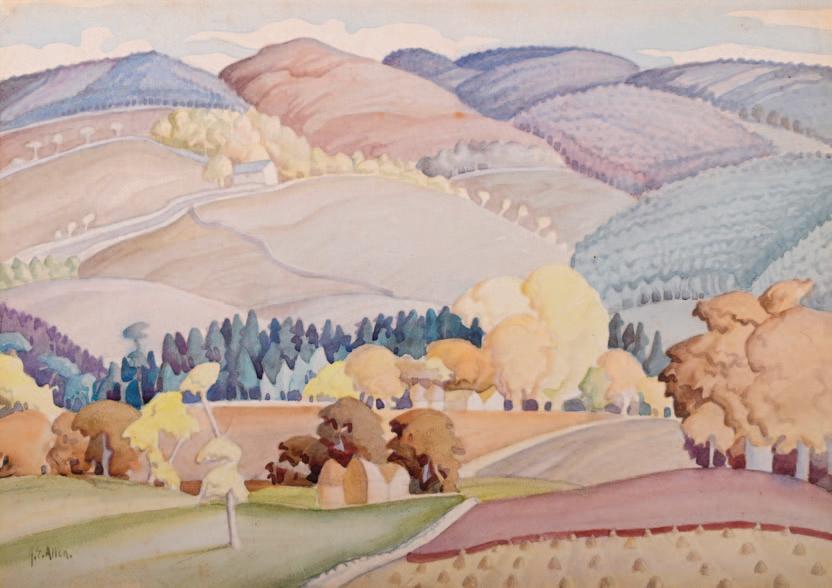
[cat.56b]
Harry Epworth Allen (1894-1958)
The Rolling Hills of Derbyshire, c.1936
Signed l.l.: H.E.Allen
Watercolour, 27 by 37 cm, 10 ½ by 14 ½ ins
There is a visionary quality to Epworth Allen’s inter-war landscapes, many of which are a record of the rolling hills of Derbyshire, or the countryside near Sheffield prior to being swallowed up in the process of urbanisation.
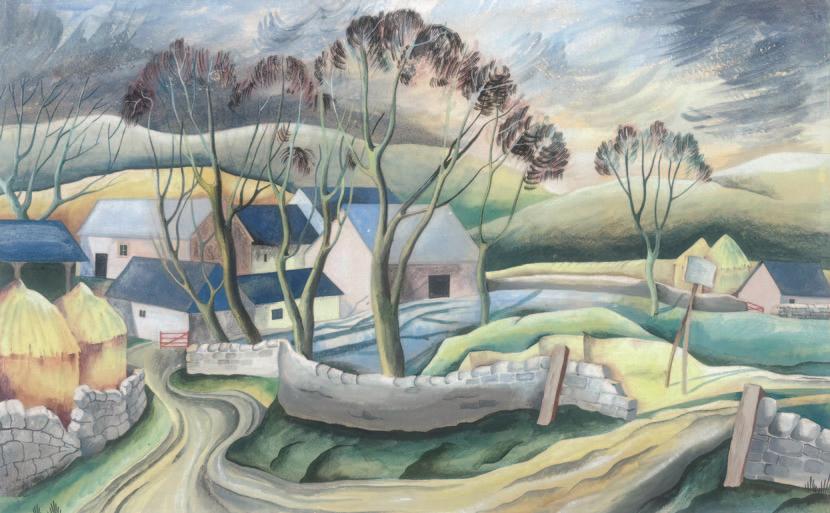
[cat.57a]
Clifford Webb, SWE, RBA (1895-1972)
Hill Farm near the Scottish Borders
Watercolour over pencil, 29.5 by 47 cm, 11 ½ by 18 ½ ins
Many of Webb’s most successful woodcuts depict the wild Northumbrian countryside near Hadrian’s Wall where he would visit regularly in the inter-war years. His best watercolours, like this picture, closely reflect his work as a printmaker and retain something of the same graphic quality and inventive composition. Webb was a leading figure in the British wood engraving revival of the 1920s and was highly regarded as an illustrator, with work including that for the Golden Cockerel Press and later for a famous edition of Swallows and Amazons He taught at Birmingham School of Art in the 1920s, later lecturing on engraving in London at St Martin’s School of Art.
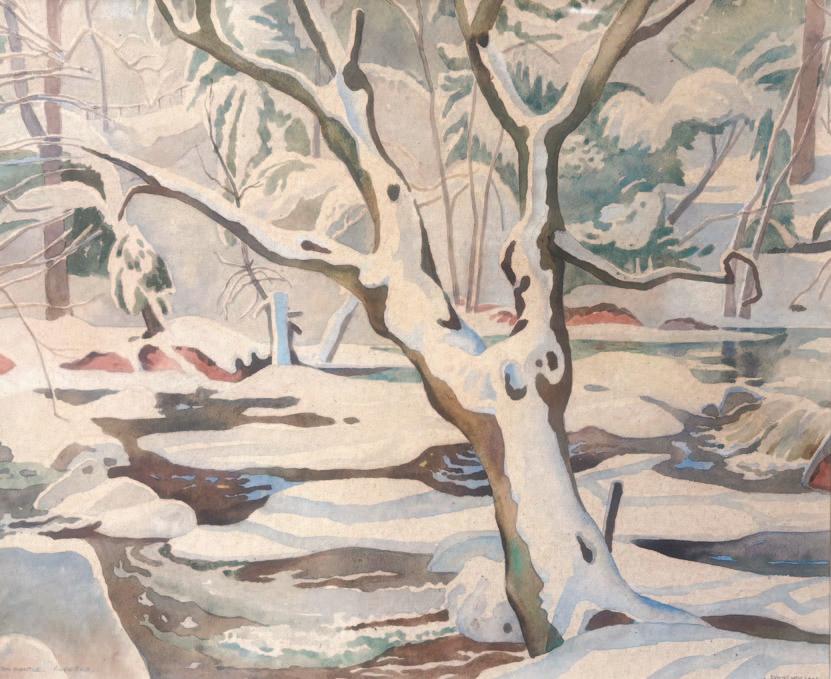
[cat.57b]
William Lyons Wilson (1892-1981)
Snow Mantle, River Exe, Devon
Signed l.r.: Lyons Wilson and inscribed with title l.r. Watercolour, 40 by 47 cm, 15 ¾ by 18 ½ ins
In the inter-war years, Lyons Wilson worked as a painter for the Cunard Shipping Line, creating painting for their interiors. His strong art deco, English modernist style was ideal for the role, as typified by works like this fine snow scene of the river Exe close to his home in nearby Tiverton. He particularly excelled in watercolour, the painter Richard Eurich claiming him as “the best watercolourist of his time”.

[cat.58]
Robert Tavener, RE (1920-2004)
Oast Houses, Kent
Signed l.r.: Robert Tavener
Watercolour over pen and ink, 14 by 18.5 cm, 5 ½ by 7 ¼ ins
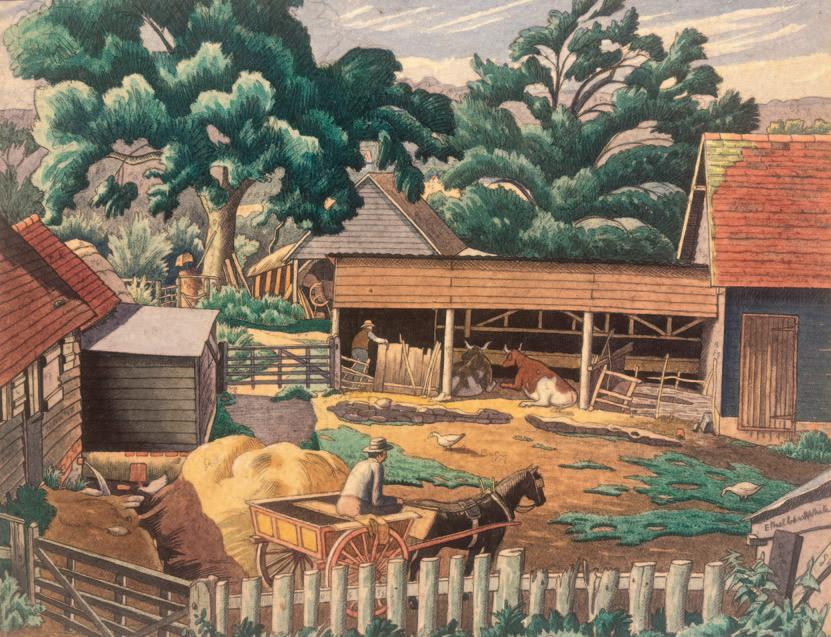
[cat.59]
Ethelbert White, RWS (1891-1972)
The Farmyard
Signed l.r.: Ethelbert White
Watercolour over pencil, 32.5 by 42 cm, 12 ¾ by 16 ½ ins
Provenance: acquired from Michael Parkin Fine Art Ltd by Luke Gertler, probably in the 1980s
White’s landscape pictures of the 1920s are some of the most instantly recognisable of the period. One of the leading printmakers of the time (he was a founder-member of the English Wood Engraving Society in 1925), such works are remarkable in their ability to imbue everyday subjects with an unusual sense of poetry and lyricism. Peyton Skipwith has appropriately described him as “a draughtsman with an engraver’s eye”. This busy farmyard scene is a fine example of one such 1920s work.

[cat.60]
John Piper, CH (1903-1992) Egalyieres, Provence
Signed l.l.: John Piper
Watercolour with gouache over pen and ink, 35.5 by 53 cm, 14 by 20 ¾ ins
Provenance: with the Leicester Galleries, c.late 1950s

[cat.61]
John Craxton, RA (1922-2009)
Cat
With inscription (verso): lightening sketch drawn for me by John Craxton (at Kidderpore Avene, NW3, 1965)
Pencil, 14 by 10 cm, 5 ½ by 4 ins
Provenance: a gift from the artist to the family of the previous owner in 1965
Cats are the signature subject of Craxton’s later work – a constant in his Christmas cards, notes and letters to friends. At the artist’s memorial service, Sir David Attenborough, Craxton’s old friend and collector of his work observed “He had a robust sense of humour and an almost unforgivable taste
for puns. He produced a series of linocuts for a Christmas card based on that favourite animal of his – the cat. One showed a cat sitting on a column with the caption ‘cat-a-pillar’. There were others – which I will leave to your imagination – captioned ‘catastrophe’, ‘cat-a-pult’ and, regrettably, ‘cat-stration’”.

[cat.62]
Edward Bawden, RA (1903-1989)
All Saint’s Church, St Ewe, Cornwall
Signed with initials and dedicated u.r.: to Daphne Grierson/from EB
Watercolour over pen and ink and pencil, 49 by 62.5cm, 19 ¼ by 24 ½ ins
Provenance: a gift from the artist to the painter Daphne Grierson
Later in life Bawden made annual trips to Cornwall where he stayed in Rose Cottage in St Ewe, some five miles from St Austell. In the churchyard at All Saint’s he found a gravestone of his namesake which read “Edward Bawden, died 29th October 1894. Aged 68 years. His End Was Peace.” There is a photograph by his friend Christopher Brown of Bawden leaning on it. Malcolm Yorke has written of late watercolours like the present work: “These landscapes of Bawden’s maturity have come an astonishing distance from those early tentative ones he made sitting beside Ravilious… Now he works big and bold, taking liberties with his compositions… he sits close to a building so its perspective soars away from him… (or) to draw every flint on a church exterior or to put a square outline round every leaf… These are the playful but highly effective strategies of a man in total control of his medium.”
(Malcolm Yorke, Edward Bawden and His Circle, Antique Collectors’ Club, 2007, pp.240-41)
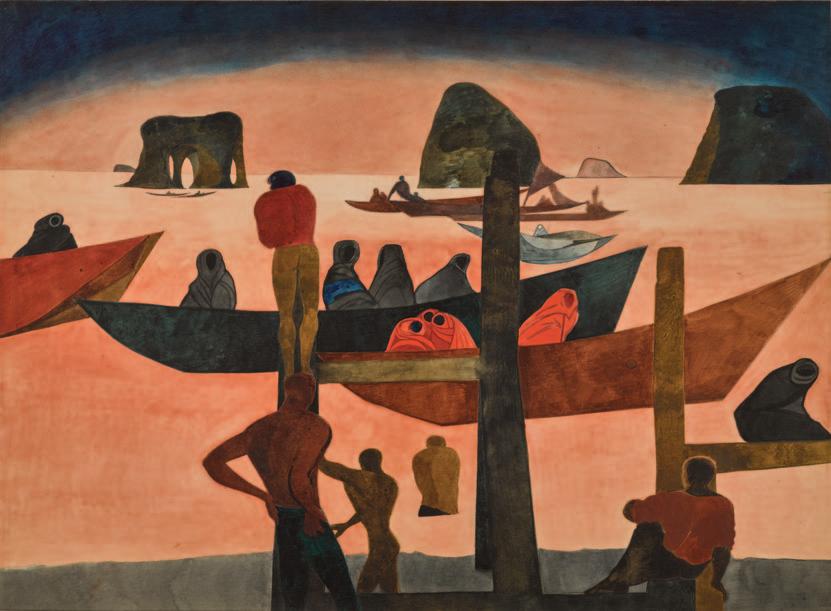
[cat.63]
Edward Burra (1905-1976)
Boats and Rocks, 1952-54
Watercolour over pencil on paper, 56 by 76cm (22 by 30 in)
Provenance: Lefevre Gallery, London; Private Collection, London; Sale, Sotheby’s London, 11 May 1988, lot 144; Crane Kalman Gallery, London, where acquired by the family of the present owner, April 2008, and thence by descent Exhibited: London, Crane Kalman Gallery, A Selection of Paintings, April 2008 Literature: Andrew Causey, Edward Burra: Complete Catalogue, Phaidon, London, illustrated no. 216a
Boats and Rocks is a fine example of Burra’s 1950s work, a dream-like seascape loosely based around the coast near his hometown in Rye but ultimately a product of his uniquely strange and fertile imagination. The Burra expert Jane Stevenson has written of this work: “Painted in 1952, the execution of Boats and Rocks contrasts with Burra’s earlier
works, which are painted tightly, with a matte finish and opaqueness, feeling similar in many ways to tempera. Here Burra uses the watercolour medium to an entirely different effect - he utilizes the swirling diffusion, the blurring of boundaries, to encourage the prevailing sense of the uncanny and strange.”
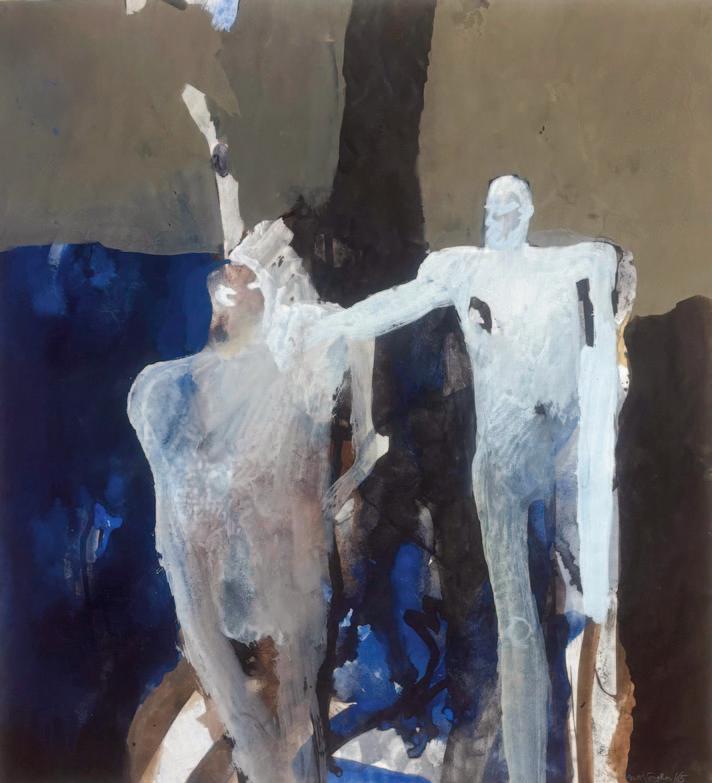
[cat.64]
Keith Vaughan (1912-1977)
Two Figures (Cain and Abel)
Signed and dated l.r.: Keith Vaughan/65 and inscribed by the artist (verso) Two Figures (Cain and Abel)
Gouache with ink and watercolour, 47.5 by 44 cm, 18 ¾ by 17 ¼ ins
Provenance: the artist to Marlborough Fine Art from whom probably acquired by the present owners
Exhibited: Marlborough Fine Art, Keith Vaughan, Recent Gouaches, 1965, October 1965, no.48
The gouaches that Vaughan produced in 1965 are considered amongst his finest in the medium – with some sixty completed by June of that year. Many (including the present work) were submitted to his landmark (if ultimately unsuccessful) Marlborough Fine Art show in October 1965. Gerard Hastings has written “He considered this to be his golden period in representing the figure simultaneously in
figurative and abstract terms”, whilst Vaughan himself observed in 1968 in an unpublished manuscript Notes on Art that he had aimed to … ”render the human presence as something very real and very abstract, creating an image without identity of gender or number, which is unmistakably human - the human figure as an abstract element, like a musical chord.”

[cat.65]
Lynn Chadwick, RA (1914-2003)
Abstract figure, 1966
Signed and dated l.r.: Chadwick 66
Watercolour over pen and ink on light green paper, 63 by 47cm, 24 ¾ by 18 ½ ins
Chadwick’s drawings tend to reflect the work he was creating in sculpture at the same time and were generally conceived alongside it. Like his work in that medium they are constantly inventive and experimental – here creating part of the image by applying the watercolour with triangular wooden blocks created in his studio.

[cat.66]
Sir Peter Blake, RA (born 1932)
“Little Chip” The Smallest Comedian in the World
Signed, dated and inscribed to lower part of sheet: “Little Chip” the smallest comedian in the world. From “The Encore” March 31st 1893/Peter Blake/May 1970
Sepia wash over pencil, 28 by 21 cm, 11 by 8 ¼ ins
Provenance: given by the artist to Francis Greenacre (curator of the first retrospective exhibition of Peter Blake’s work held at the City Art Gallery, Bristol) in 1970. He later assisted in retrospectives at the Stedelijk Museum, Amsterdam, in 1973, travelling to Hamburg, Brussels and Arnhem
This drawing, apparently taken from late Victorian magazine, relates to Blake’s enduring interest in popular entertainment, circuses and side shows in the late 1960s and early 1970s. Out of this would result a notable set of prints called Side Show which recall the popular entertainers, wrestlers and circus performers he remembered from his youth. These would include such figures as Tattooed Lady, the Strongest Man in the World, Bearded Lady, Smallest
Man in the World, Fat Lady and Thin Man. Blake has written of these subjects: “There’s a whole background to it, but really it’s a class thing, a working class thing. When I was a kid these were my interests – the fairgrounds, circuses, rock’n’roll. So, at a certain point in making art, when I had to make a decision about what to do, I thought, “be autobiographical”.
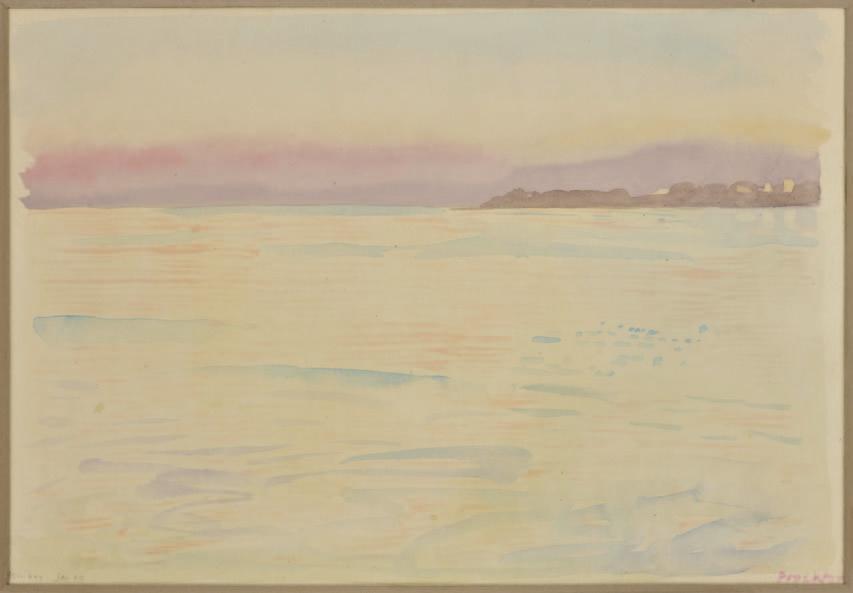
[cat.67] Patrick Procktor, RA (1936-2003) Sunset, Bombay
Signed l.r.: Procktor and inscribed and dated Bombay/Jan 29 Watercolour, 18 by 27 cm, 7 by 10 ¾ ins


FREYA MITTON

[cat.68]
Maxwell Ashby Armfield (1881-1972)
Dragonfly and Amaryllis
signed with monogram and dated ‘16
pencil and pastel
34 by 23.5 cm.; 13 ¼ by 9 ¼ in.

[cat.69] Christopher Wood (1901-1930) Still Life with Tulips in a Vase pencil
24.5 by 28.5 cm.; 9 ¾ by 11 ¼ in.
Provenance: Sale; Christie’s London, 13 Dec 1999, Lot 69
[cat.70] Paul Nash (1889-1946)
Bristol Souvenir
signed watercolour over pencil 20 by 25.5 cm.; 8 by 10 in.
Provenance:
Thos. Agnew & Sons Ltd, London
Leicester Galleries, London
Lord Croft, 1958
Sotheby’s Sale, 10 Nov, 1976, no. 143
Private Collection, London
Paintings in Hospitals, Cat. no. 13170
Exhibited:
London, Redfern Gallery, 1942, no.33
Bedford, Castle Close, Cecil Higgins Museum, Collector’s Choice Exhibition, 16 April – 14 May 1960
Literature:
Andrew Causey, Paul Nash, Clarendon Press, Oxford, 1980, no. 959



[cat.71]
Keith Vaughan (1912-1977)
Farm Labourers
signed and dated ‘45 pen, ink and gouache
6.5 by 9.5 cm.; 2 ½ by 3 ¾ in.
Provenance:
The Leicester Galleries, London Redfern Gallery, London
Purchased by the present owner in 1978

[cat.72]
John Minton (1917-1957)
Casting
painted in 1948
pen, ink, watercolour and wash
16.5 by 18 cm.; 6 ½ by 7 in.
Provenance:
Mercury Gallery, Cork Street, London; Where acquired by the current owner in 1979
The present work was part of a commission from Everetts Advertising Ltd, then in 10 Hertford Street, London, W1, and is one of several studies Minton made of the Imperial Smelting Corporation in their industrial plants at Avonmouth and Widnes. Minton worked up watercolours from studies he made, which were then used in a series of announcements made by Imperial Smelting Corporation in a variety of trade magazines and journals. A finished watercolour of a blast furnace in this series is reproduced in Martin Salisbury's The Snail that Climbed the Eiffel Tower and Other Work by John Minton, Mainstone Press, 2017, p. 19.
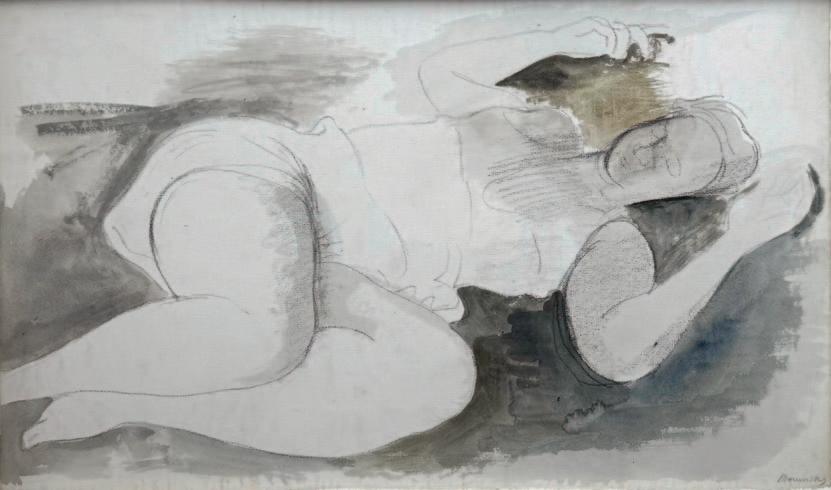
[cat.73]
Bernard Meninsky (1891-1950)
signed
pencil, watercolour and wash
35.5 by 60 cm.; 14 by 23 ¾ in
Sleeping Girl

pencil and watercolour
25.5 by 31.5 cm.; 10 by 12 ½ in.
[cat.74]
Doris Hatt (1890-1969)
Fish Market

[cat.75]
Patrick Hayman (1915-1988)
Lovers and Animals
signed and dated 1968
pen and ink with watercolour
29 by 45 cm.; 11 ½ by 17 ¾ in.

signed, executed in 1968
gouache
17.5 by 35.5 cm.; 7 by 14 in.
Provenance: Circle Gallery, London
[cat.76] Scottie Wilson (1890-1972) Snow White
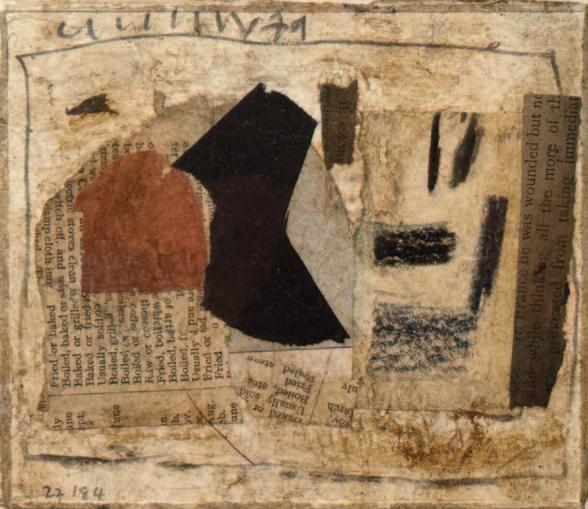
[cat.77]
Roy Turner Durrant (1925-1998) Composition (Hadstock)
signed, dated ’79 and numbered mixed media collage
12.5 by 14.5 cm.; 5 by 5 ¾ in.
[cat.78]
Keith Vaughan (1912-1977)
Maze of Figures
executed c.1973-5 ink, watercolour, gouache and oil pastel 77 by 53 cm.; 30 ¼ by 20 ¾.
Provenance: New Grafton Gallery, 1985
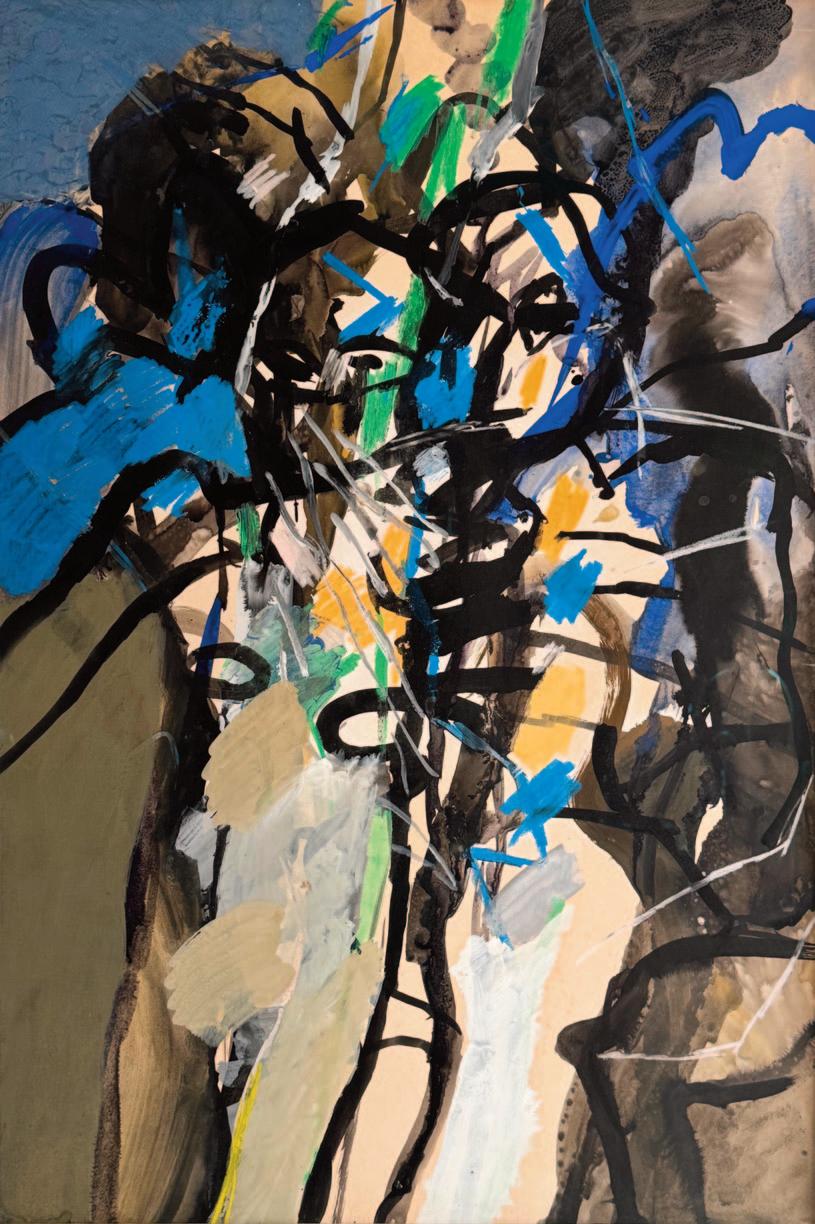

[cat.79a]
Edward Wolfe, RA (1897-1982)
Head Study
signed, pencil
9 by 9 cm.; 3 ½ by 3 ½ in.
Provenance: By descent from Jim O’Connor, Edward Wolfe’s partner
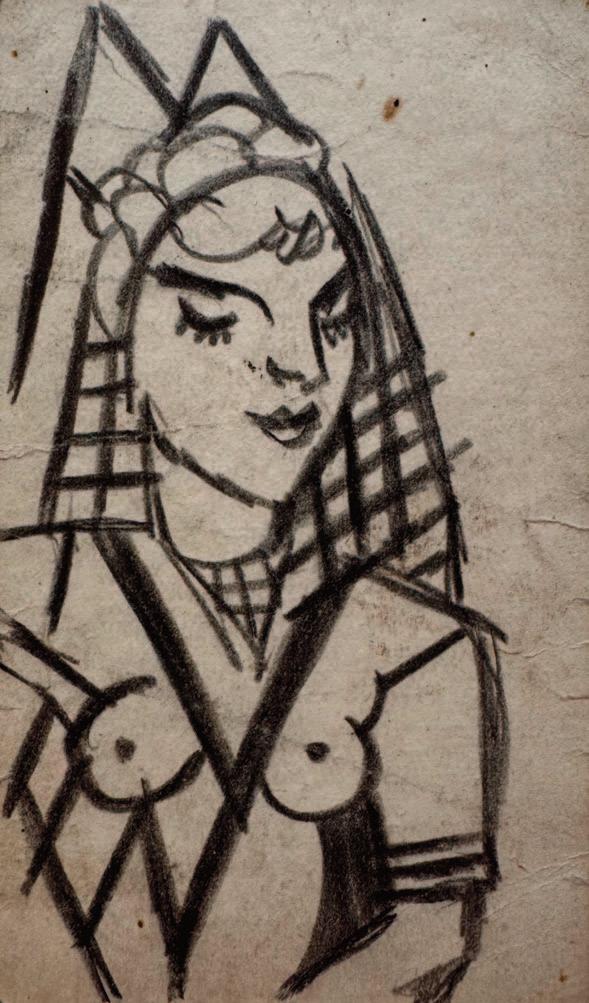
[cat.79b]
Edward Wolfe, RA (1897-1982)
Costume Design
pencil
9.25 by 5.5 cm.; 3 ¾ by 2 ¼ in.
Provenance: By descent from Jim O’Connor, Edward Wolfe’s partner
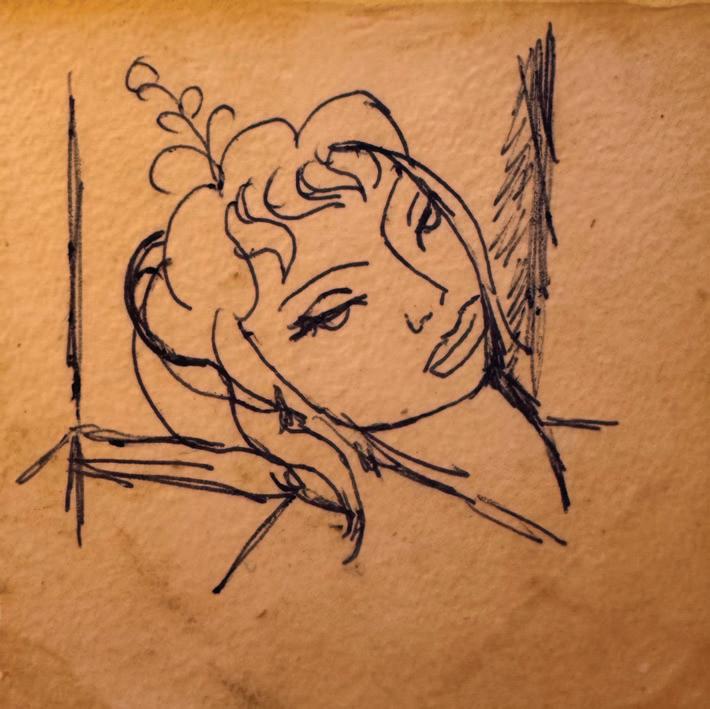
Edward Wolfe, RA (1897-1982)
Girl in a Headdress
pen and ink
9 by 9 cm.; 3 ½ by 3 ½ in.
Provenance:
By descent from Jim O’Connor, Edward Wolfe’s partner
[cat.79c]
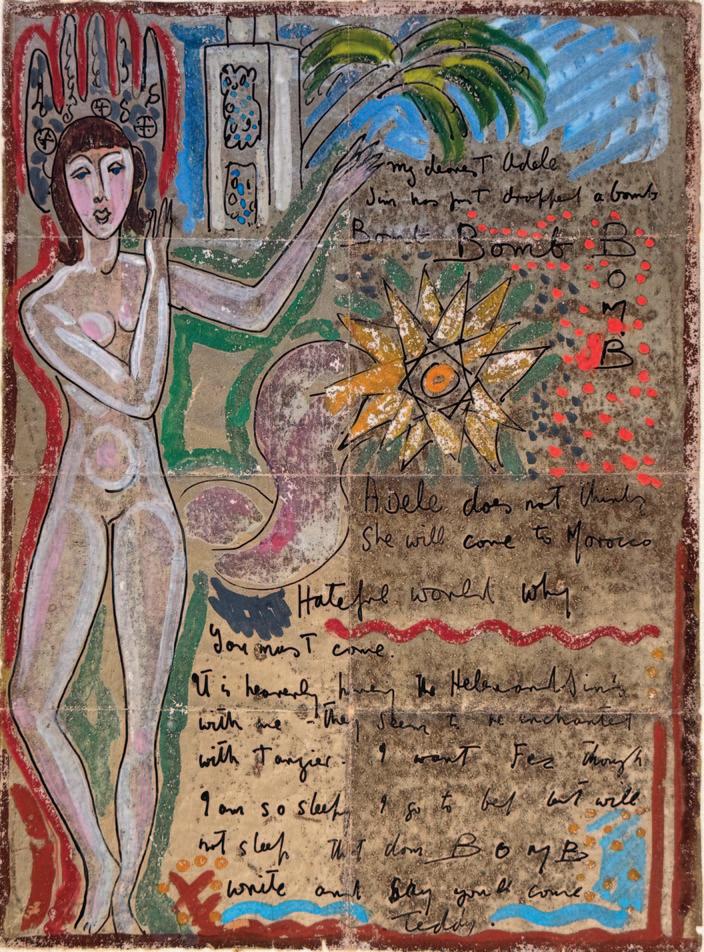
[cat.80]
Edward Wolfe, RA (1897-1982)
Illustrated Letter to Adele signed and inscribed ‘My Dearest Adele, Jim has just dropped and bomb, bomb, bomb, BOMB. Adele does not think she will come to Morrocco….’ gouache on silvered paper
35.5 by 26.5 cm.; 14 by 10 ½ in.
This letter is most likely addressed to Adele Gersteley whose portrait Edward Wolfe painted in the 1930s.

signed and dated 1973
pencil
76 by 56 cm.; 30 by 22 in.
Mary Fedden, RA (1915-2012)
Sunflowers
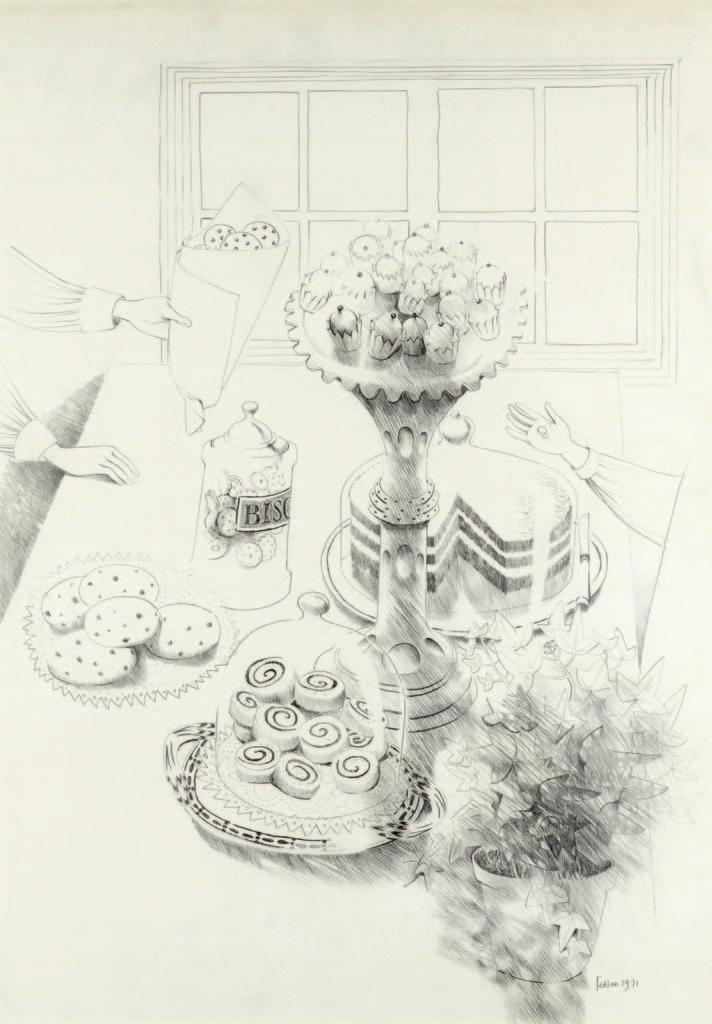
[cat.82]
Mary Fedden, RA (1915-2012)
The Cake Shop signed and dated 1971 pencil
66.5 by 46 cm.; 26 by 18 in.

[cat.83]
Mary Fedden, RA (1915-2012)
Harbour Still Life
watercolour and collage
21.5 by 28.5 cm.; 8 ½ by 11 ¼ in Provenance:
From the collection of Michael and Henrietta Gough

[cat.84]
John Piper, CH (1903-1992)
Ashwell Thorpe, Norfolk
signed, titled and dated 4.IV.78 pencil, pen, ink and wash, watercolour and pastel 39.5 by 57 cm.; 15 ½ by 22 ½ in.

[cat.85]
Paul Feiler (1918-2013)
Sekos GXX
signed, dated ’79 and titled gouache
19 by 19 cm.; 7 ½ by 7 ½ in (sheet); 12 by 12 cm. 4 ¾ by 4 ¾ in. (image)
Provenance: Salthouse Gallery, St Ives, circa 1985
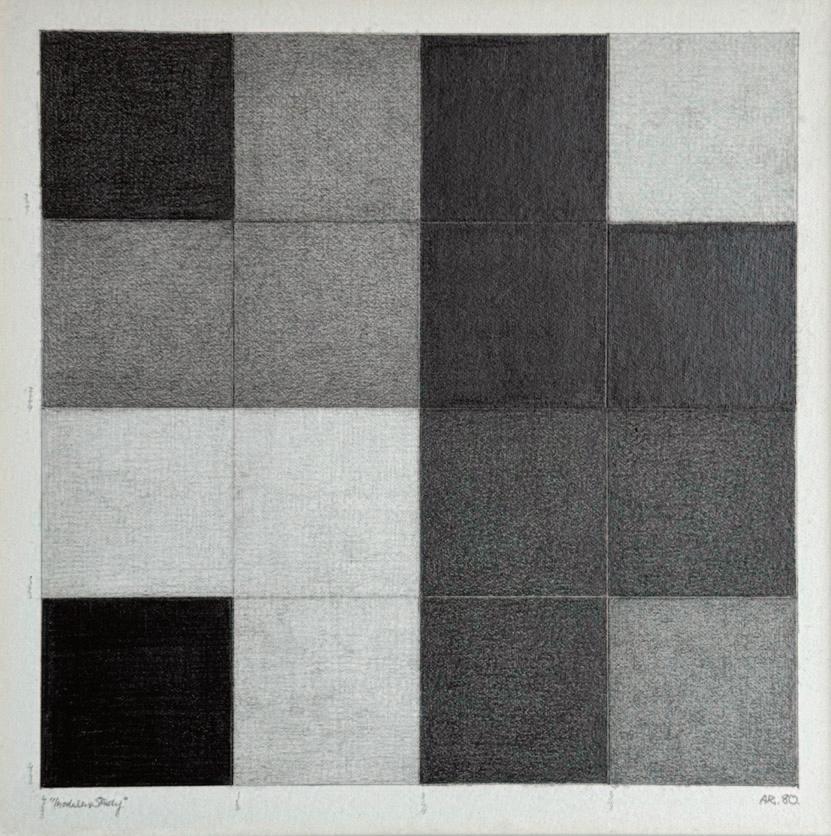
[cat.86]
Alan Reynolds (1926-2014) Modular Study
signed with initials, titled and dated ’80; also titled and inscribed For John with my thanks and warmest greetings, Alan. 14/9/81 lead pencil on paper laid on card 28 by 28 cm.; 11 by 11 in.
Provenance: Annely Juda Fine Art, London
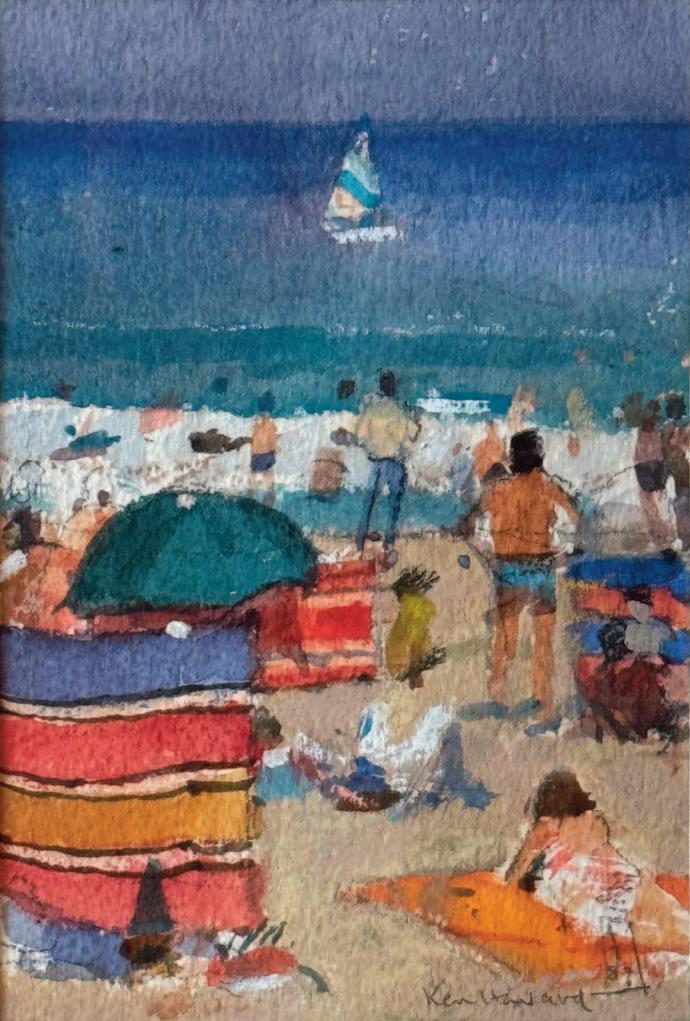
signed and dated 4.7.87
watercolour
18 by 12 cm.; 7 by 4 ¾ in.
Ken Howard, RA (1932-2022)
Sennen
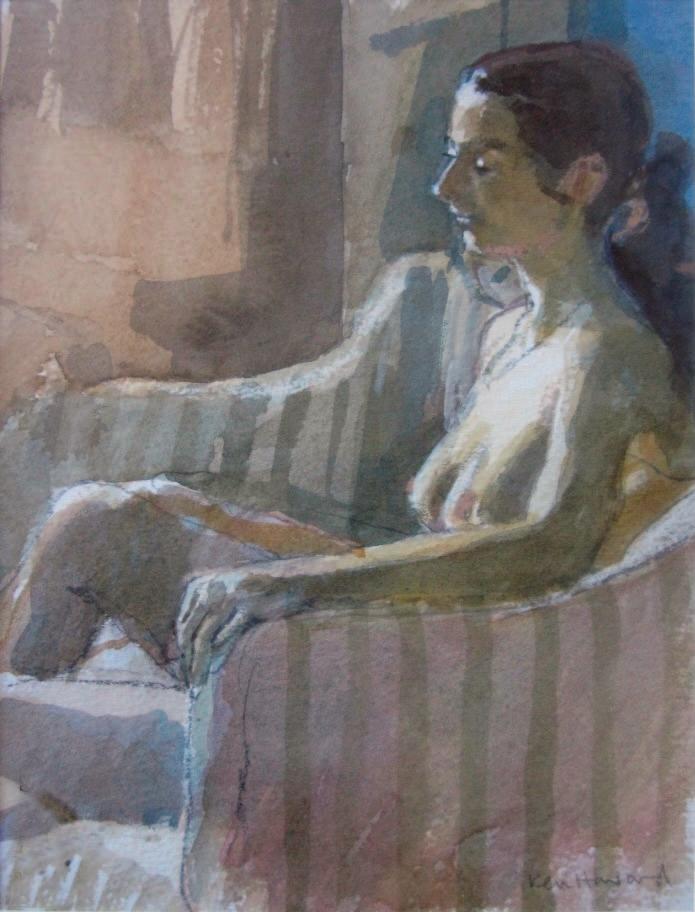
[cat.88] Ken Howard, RA (1932-2022)
Nude on Stripy Sofa signed watercolour 22.5 by 18 cm.; 9 by 7 in.

[cat.89]
Ken Howard, RA (1932-2022)
Udaipur
signed watercolour, painted with another watercolour of a lake scene verso 11.5 by 14.5 cm.; 4 ½ by 5 ¾ in.

[cat.90]
George Dannatt (1915-2009)
Autumn
signed with initials and dated 86/9; also signed, inscribed and dated verso pencil and watercolour 15 by 12 cm. 6 by 4 ¾ in.

Sir Terry Frost, RA (1915-2003)
Blue, Green and Pink
A Christmas card, signed and inscribed inside the card gouache and collage 10 by 12.5 cm.; 4 by 5 in.
[cat.91a]

[cat.91b] Sir Terry Frost, RA (1915-2003)
Easter Eggs
an Easter card, signed and inscribed on the reverse gouache and collage 19 by 25 cm.; 7 ½ by 10 in.

Sir Terry Frost, RA (1915-2003)
Door Plate
canvas collage
22.5 by 5 cm.; 9 by 2 in.
[cat.91c]
[cat.91d]
Sir Terry Frost, RA (1915-2003)
Hanging Circles
signed and dated ‘91
leather lace, gouache and collage
38 by 6 cm.; 15 by 2 ½ in.

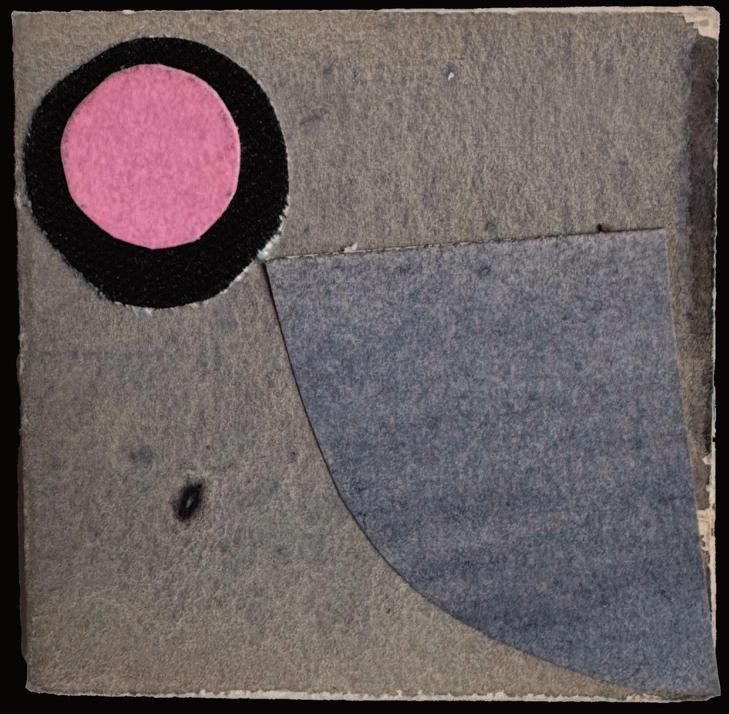
[cat.91e]
Sir Terry Frost, RA (1915-2003)
Boat and Pink Sun, a Christmas Card
signed and inscribed Lots of good wishes to Joan & Fred from Kath & Terry watercolour, wash and collage
7.5 by 8 cm.; 3 by 3 ¼ in.
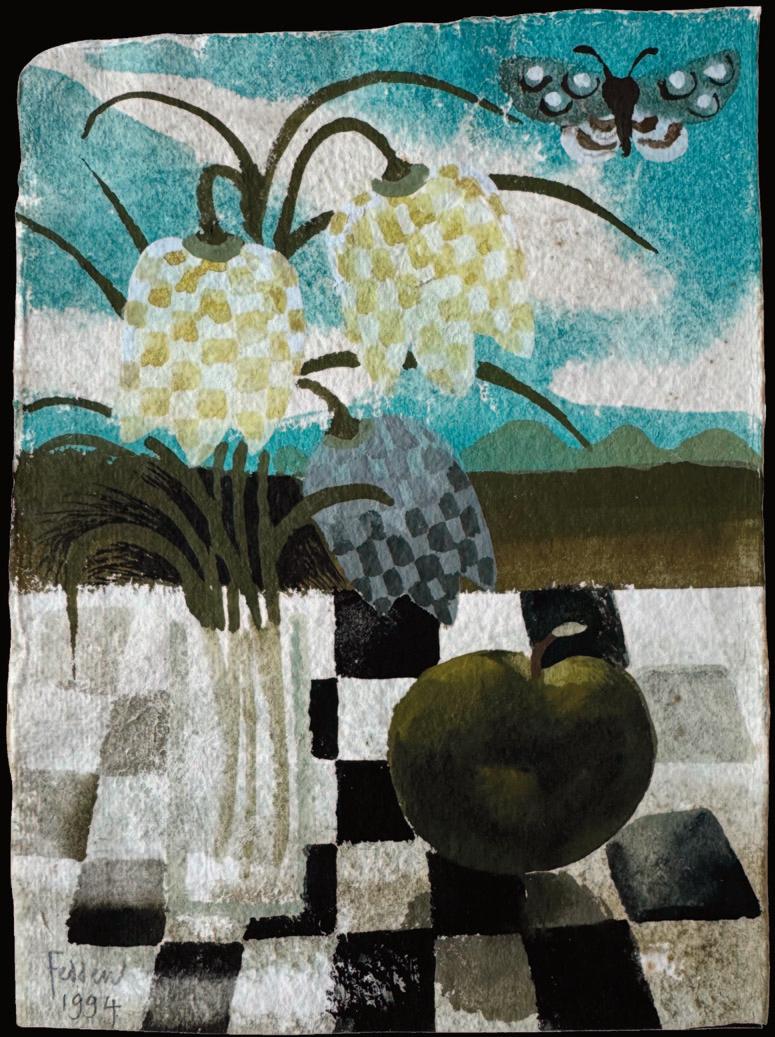
[cat.92]
Mary Fedden, RA (1915-2012)
Fritillaries
signed and dated 1994; also signed and titled on a label attached to the reverse ink, watercolour and gouache 19 by 14 cm.; 7 ½ by 5 ½ in.
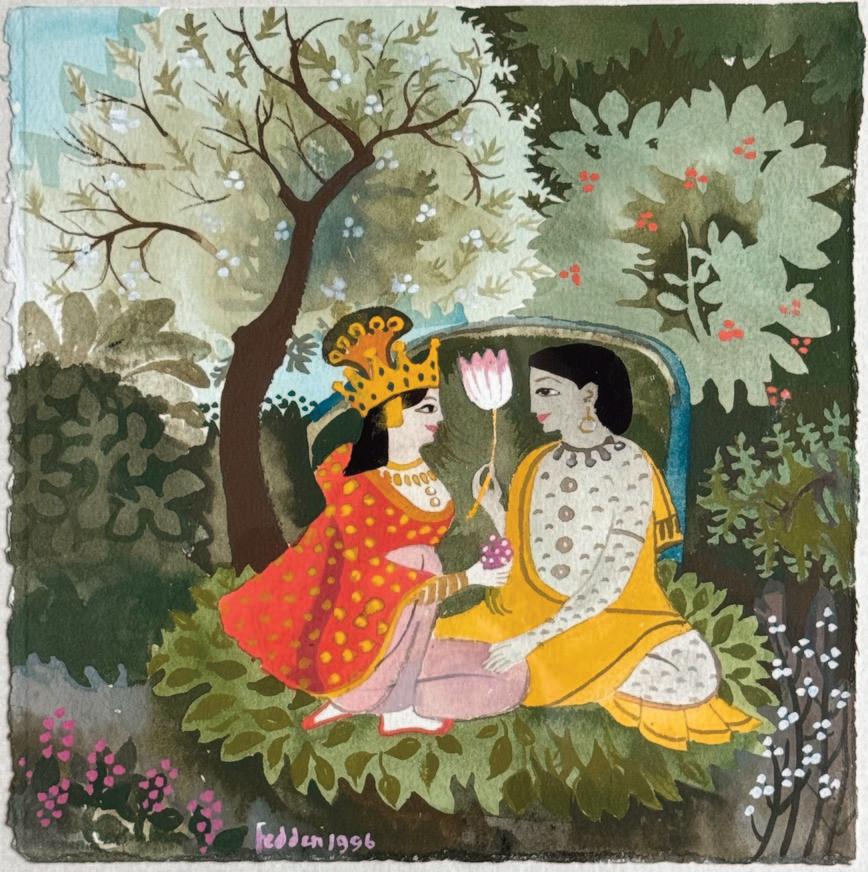
[cat.93]
Mary Fedden, RA (1915-2012)
Radha and Krishna
signed and dated 1996
watercolour and gouache
21.5 by 21.5 cm.; 8 ½ by 8 ½ in.
In Hindu mythology the story of Radha and Krishna symbolises divine love and devotion. Their relationship represents the deep spiritual connection between the human soul (Radha) and the divine (Krishna). One of the most symbolic moments in their story is the exchange of garments in the forest - an act that signifies their deep
spiritual connection and unity. By wearing each other’s clothes, Radha and Krishna not only express the intensity of their love, but also the merging of their identities. Together, they represent the pinnacle of love, devotion and spiritual awakening - an enduring theme in Indian art, poetry and worship.
Life Drawing signed and dated Phipps ‘78 pencil 46 by 20.5 cm.; 18 by 8 in.
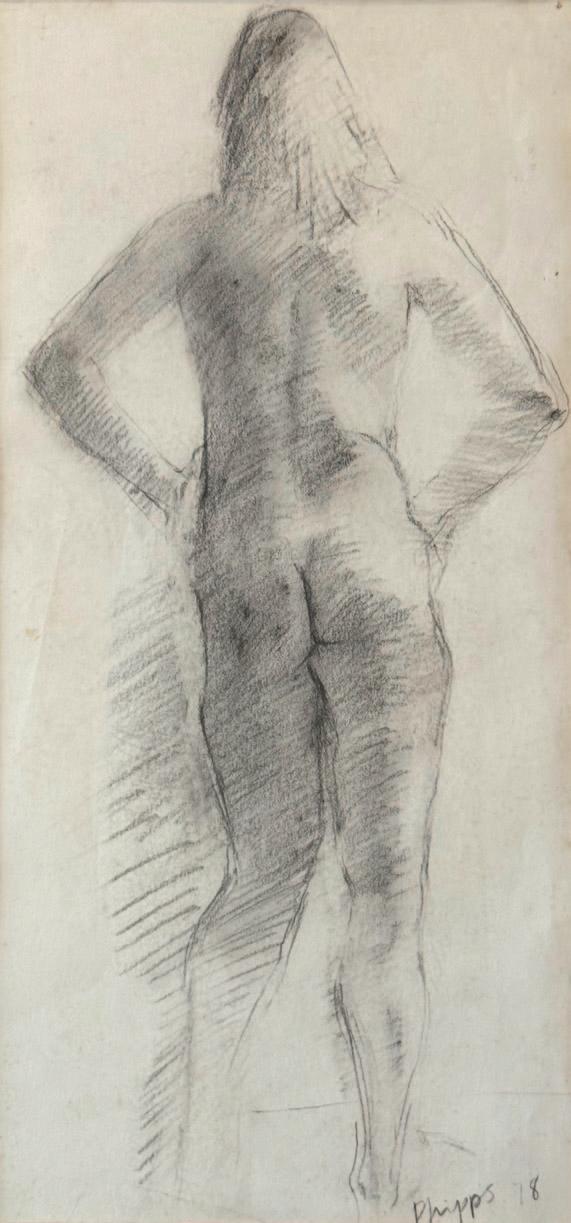
[cat.94a] Rose Hilton (1931–2019)

24 by 32 cm.; 9 ½ by 12 ½ in.
[cat.94b]
Rose Hilton (1931–2019)
Two Female Nudes
pencil
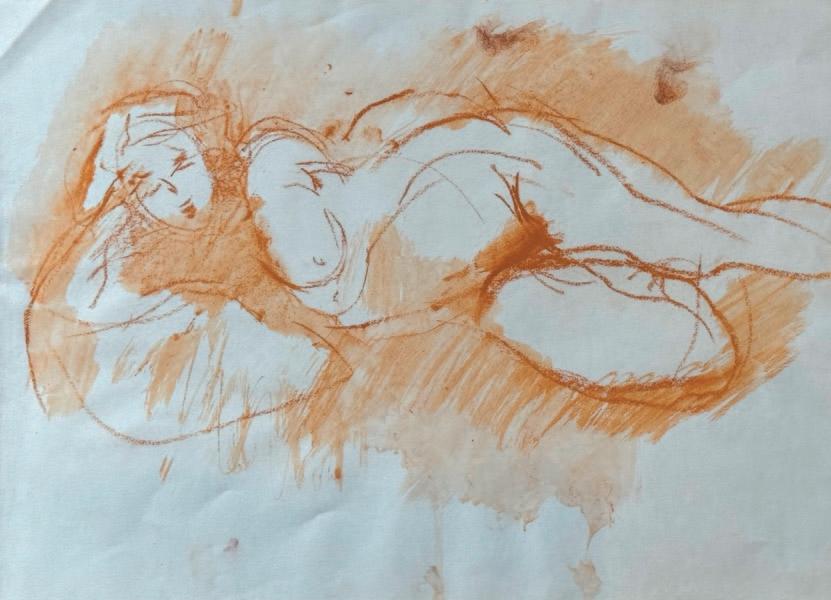
pastel and watercolour
30 by 42.5 cm.; 11 ¾ by 16 ¾ in.
[cat.94c] Rose Hilton (1931–2019) Orange Nude

[cat.94d] Rose Hilton (1931–2019) Standing Nude pastel and watercolour 41.5 by 26.5 cm.; 16 ¼ by 10 ½ in.
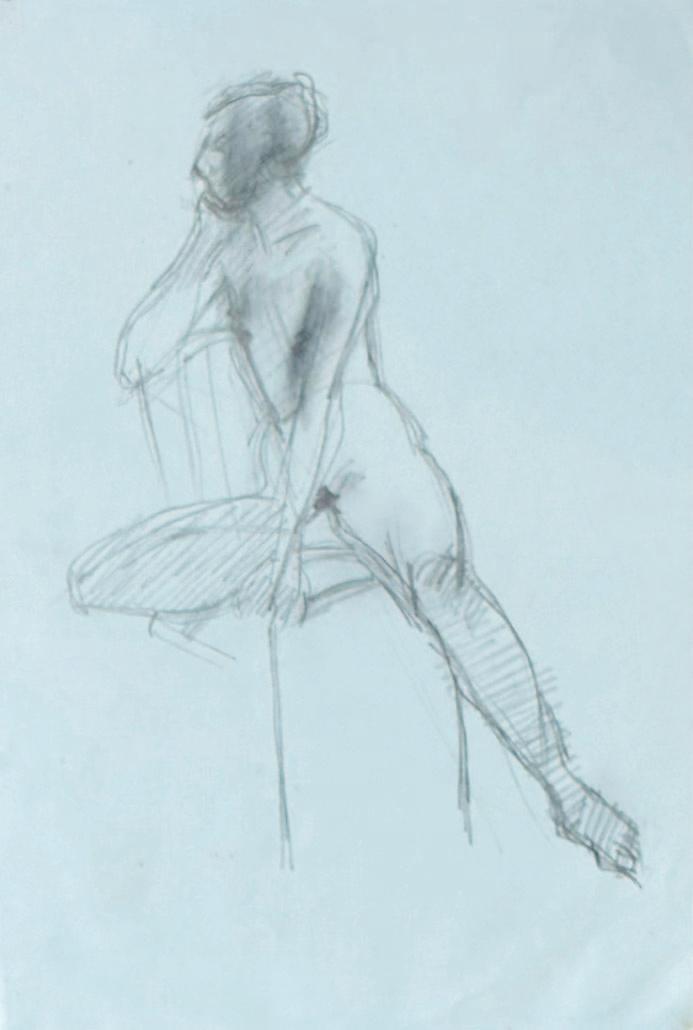
Seated Male Nude
29 by 19.5 cm.; 11 ½ by 7 ¾ in.
[cat.94e] Rose Hilton (1931–2019)
pencil
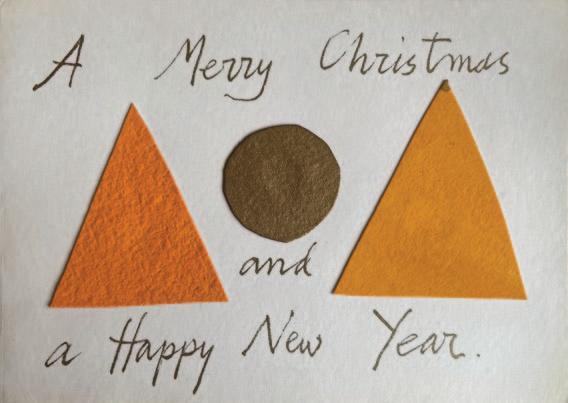
[cat.95]
Breon O’Casey (1928-2011)
Orange Triangles, a Christmas Card
inscribed A Merry Christmas and a Happy New Year, also inscribed inside Shivaun & Leck & Rubin with love from Breon & Doreen gouache, collage and gold pen 11.5 by 16.5 cm.; 4 ½ by 6 ½ in.
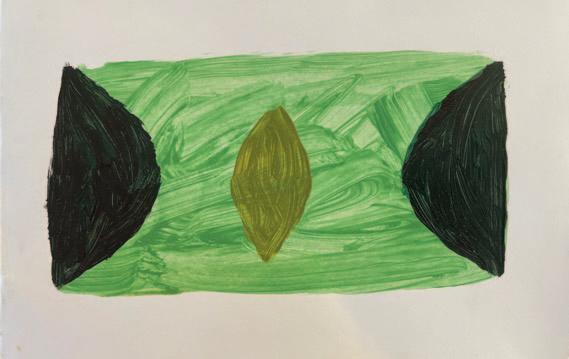
[cat.96]
Breon O’Casey (1928-2011)
Green Forms, a Christmas Card
inscribed inside To Shivaun, A Merry Christmas & A Happy New Year, love Breon gouache 11 by 17.5 cm.; 4 ½ by 7 in.
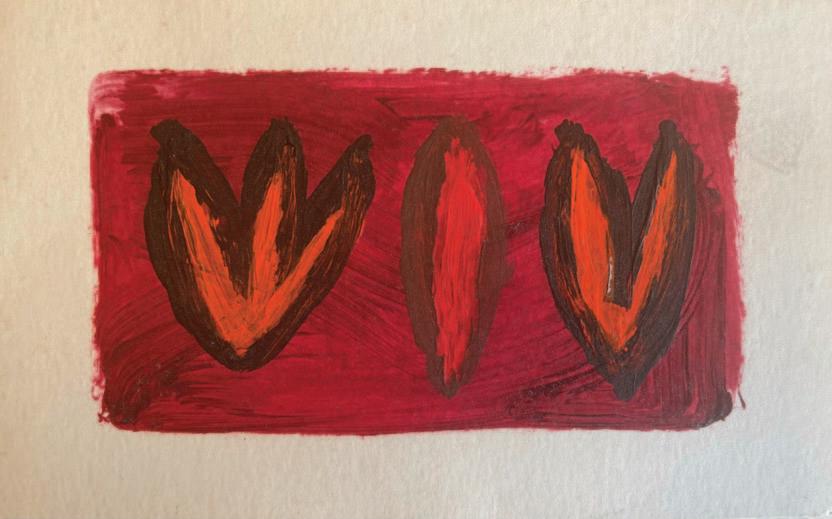
[cat.97]
Breon O’Casey (1928-2011)
Flowers, a Christmas Card
inscribed inside To Shivaun with best wishes for a Merry Christmas and a good New Year and with love from Breon & Doreen gouache and oil paint 11 by 18 cm.; 4 ¼ by 7 in.
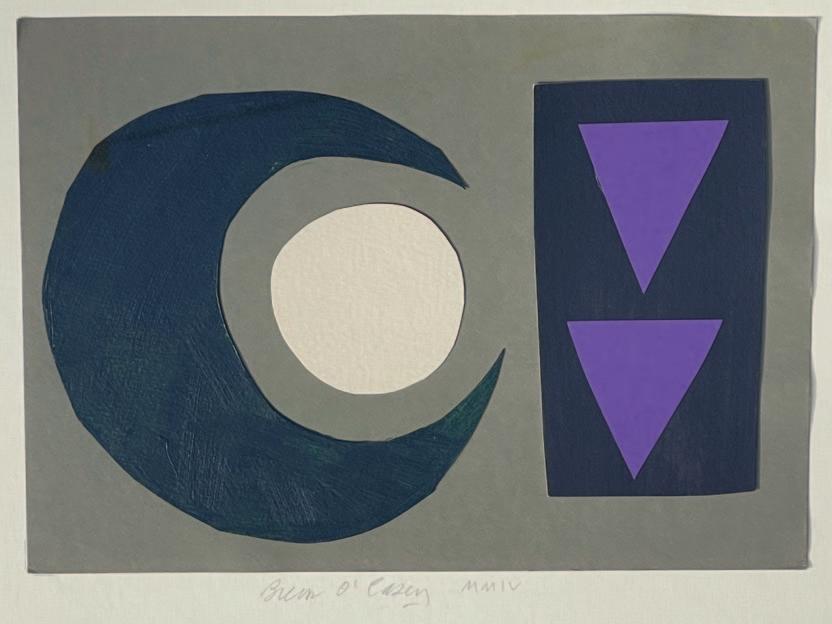
Breon
Bagatelle I
signed and dated MMIV
mixed media and collage 15 by 21 cm.; 6 by 8 ¼ in.
Provenance: The Stour Gallery, Shipston-on-Stour
[cat.98]
O’Casey (1928-2011)
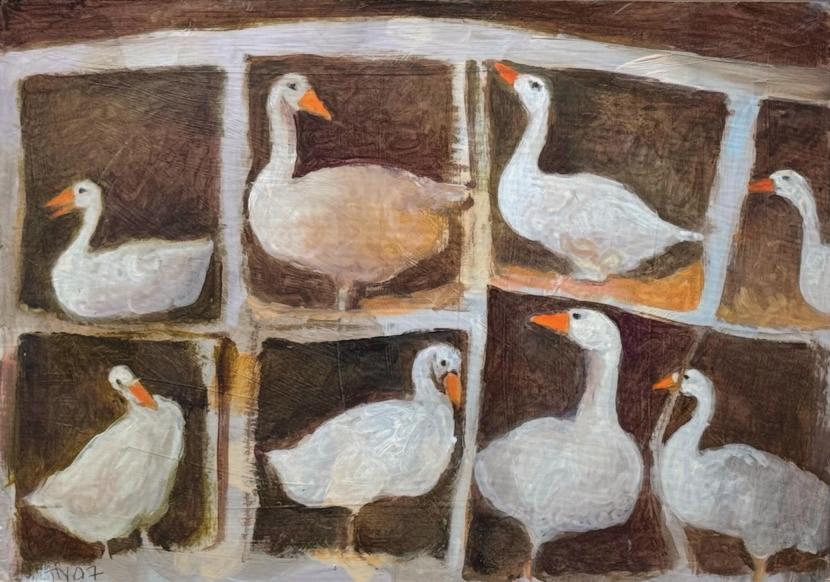
signed with initials and dated ‘07 gouache 15 by 21.5 cm.; 6 by 8 ½ in.
[cat.99] Tessa Newcomb (b.1955) Geese in their Houses
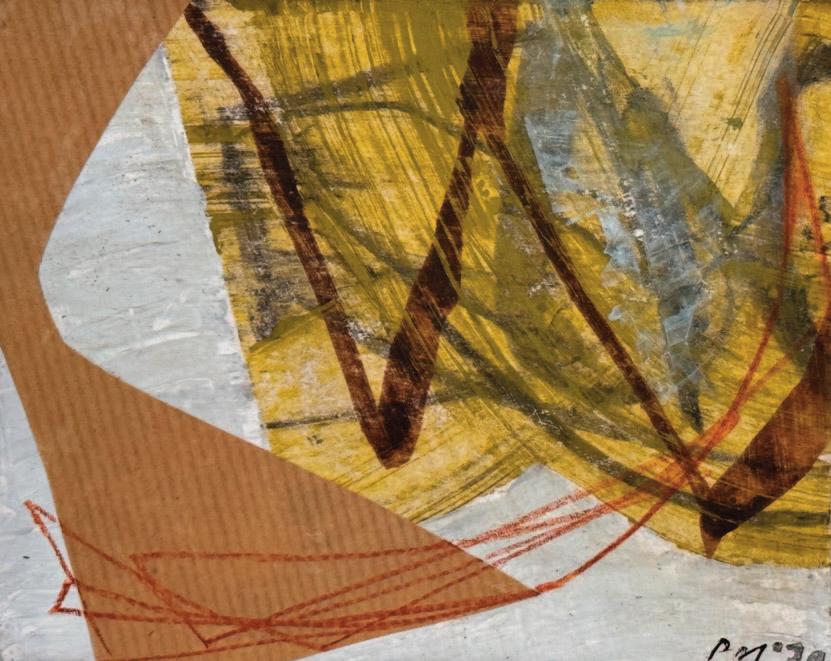
[cat.100a]
Peter Joyce (b.1964)
Abstract I
signed with initials and dated ‘20 mixed media collage 12 by 15 cm.; 4 ¾ by 6 in.

[cat.100b] Peter Joyce (b.1964) Abstract 2
signed with initials and dated ‘20 mixed media collage 12 by 15 cm.; 4 ¾ by 6 in.

GUY PEPPIATT
Guy Peppiatt started his working life at Dulwich Picture Gallery before joining Sotheby’s British Pictures Department in 1993. He soon specialised in early British drawings and watercolours and took over the running of Sotheby’s Topographical sales.
Guy left Sotheby’s in 2004 to work as a dealer in early British watercolours and since 2006 he has shared a gallery on the ground floor of 6 Mason’s Yard, St James’s. He advises clients and museums on their collections, buys and sells on their behalf and can provide insurance valuations. Guy Peppiatt Fine Art exhibit as part of Master Drawings New York every January as well as London Art Week in July and December.
He has recently curated an exhibition of early British watercolours at Eton College and held a loan exhibition in the gallery in 2022 - ‘Views of Nature – Four Centuries from Winchester College’. He has regular selling exhibitions in the gallery – recent ones including ‘Dr William Crotch and the Great School of Oxford’, ‘Bristol School of artists 1820-1860’, ‘Charles Gore 1729-1807’, ‘Edward Lear 1812-1888’, ‘British Portrait and Figure Drawings’ and ‘John Linnell and his Contemporaries’. He is also a Trustee of Turner’s House in Twickenham.
FREYA MITTON
Freya Mitton has been specialising in 20th Century British Art for over 25 years. She set up as an independent dealer in 2012 having previously been a specialist and auctioneer at both Sotheby’s and Bonhams.
She is a board member of the Association of Art & Antiques Dealers (LAPADA), and also a member
of the British Antique Dealers Association (BADA) and an associate member of The Cotswold Art & Antique Dealer Association.
Prior to moving into 6 Mason’s Yard Freya exhibited at over 100 Art and Antiques Fairs in London and across the country.

Harry Moore-Gwyn studied at Oxford University and Christie’s Education before working as graduate trainee at Sotheby’s London. He started dealing independently in 2000 and has since established his reputation as a dealer in British Paintings, drawings and sculpture, focusing on the period from 1870 to 1950 and with artists including the painters of the Bloomsbury and Camden Town groups, John and Paul Nash, John Piper and Graham Sutherland. He opened his first gallery on the Third floor at 6 Mason’s Yard in St James’s in 2018, moving to the Ground floor in 2021 in a space he now shares with Freya Mitton and Guy Peppiatt. He has also taken stands at many of the leading London art and antique fairs. He has a particular
interest in unsung painters of the period, publishing numerous catalogues on twentieth century British art and working with several artist’s estates amongst them James Boswell, Anthony Devas and Lowes Dalbiac Luard. In 2015 he cocurated the centenary show on Kenneth Rowntree at the Fry Art Gallery, Saffron Walden and Pallant House, Chichester, the catalogue for which was nominated for the Berger Prize for British Art History in 2016. In 2018 he curated the first major retrospective on the painter Henry Lamb for a generation at Salisbury Museum (later travelling to Poole Museum in 2019). His catalogue for this show, Henry Lamb: Out of the Shadows was published by Paul Holberton in 2018.
HARRY MOORE-GWYN
A
Cat No.
Allen, Harry Epworth 56a, 56b
Armfield, Maxwell Ashby 68
B
Barret Junior, George O.W.S. 16
Bawden, Edward RA 62
Beaton, Sir Cecil 52a, 52b
Blake, Sir Peter RA 66
Bomberg, David 48b
Burra, Edward 63
C
Callow, William R.W.S. 24a, 24b, 25
Chadwick, Lynn RA 65
Collins, Cecil 51
Cotman, John Sell 23
Cotman, Miles Edmund 22
Cox, David 26, 27a, 27b
Craxton, John RA 61
D
Dannatt, George 90
de László, Philip PRBA 40
de Loutherbourg, Philip James RA 6
de Wint, Peter 17
Devis, Anthony 8
Duncan, Edward R.W.S. 32
Durrant, Roy Turner 77
E
English School 1, 3a, 3b
Fedden, Mary RA. 81, 82, 83, 92, 93
Feiler, Paul 85
Fielding, Newton Smith
Limbird 14a, 14b
Fripp, George Arthur R.W.S. 29
Frost, Sir Terry RA 91a, 91b, 91c, 91d, 91e
G
Cat No.
Gamley, Andrew RSW 39
Grant, Duncan 46
Gresse, John Alexander 7
H
Halliwell, Albert Edward 55
Hallward, Reginald 50
Hatt, Doris 74
Havell, William O.W.S. 15
Hayman, Patrick 75
Hills, Robert 13
Hilton, Rose 94a, 94b, 94c, 94d, 94e
Hodgkins, Frances 44b
Howard, Ken RA 87, 88, 89
J
John, Augustus OM, RA 45a
Joyce, Peter 100a, 100b
L Lamb, Henry R 45b
Lawrence, Sir Thomas P.R.A. 2
Lear, Edward 31a, 31b, 35a, 35b
Lucas, Arthur 37
M
Mason, Charles Heming ARA 36a
Meninsky, Bernard 73
Minton, John 49a, 49b, 72
Morley, Harry ARA 38
N
Nash, Paul 70
Nash, John RA 53a, 53b
Nevinson, Christopher
Richard Wynne ARA 48a
Newcomb, Tessa 99
Nicholson, Winifred 44a
O
O’Casey, Breon 95, 96, 97, 98
Olver, Kate Elizabeth 34a, 34b
Piper, John CH 60, 84 Porter, Sir Robert Ker 12 Potter, Beatrix 42 Procktor, Patrick RA 67 R Reinagle, Ramsay Richard RA 10
Reynolds, Alan 86 Richardson Junior, Thomas Miles R.W.S. 11
Richmond, Sir William Blake RA 36b
Rowbotham, Thomas Charles Leeson 30a, 30b
Rowlandson, Thomas 4a, 4b, 5
S
Smith, Sir Matthew 47 T
Tavener, Robert RA 58
Turner, William (of Oxford) 21
Varley, Cornelius 20
Varley, John 18, 19a, 19b, 28
Vaughan, Keith 64, 71, 78 W
Watts, George Frederic OM, RA 41
Webb, Clifford SWE, RBA 57a
Weber, Audrey 54
White Abbott, John 9a, 9b
White, Ethelbert RWS 59
Wilson, Scottie 76
Wilson, William Lyons 57b
Wolfe, Edward RA 79a, 79b, 79c, 80
Wood, Christopher 69
Wragg, Arthur 43a, 43b
Wyld, William 33
GUY PEPPIATT FINE ART
Tel: +44 (0) 20 7930 3839 or +44 (0) 7956 968 284 guy@peppiattfineart.co.uk www.peppiattfineart.co.uk
HARRY MOORE-GWYN BRITISH ART
Tel: +44 (0)7765 966 256 harry@mooregwynfineart.co.uk www.mooregwynfineart.co.uk
FREYA MITTON 20 TH CENTURY BRITISH ART
Tel: +44 (0)7968 562 499 freya@freyamitton.com www.freyamitton.com
Ground Floor, 6 Mason’s Yard, Duke Street, St James’s, London SW1Y 6BU Monday to Friday 10.30am to 6pm Evenings and weekends by appointment
Design: Sarah Garwood Creative, sarahgarwoodcreative.com
Print: Zenith Print Group, enquiries@zenithprintgroup.com

Ground Floor, 6 Mason’s Yard, Duke Street, St James’s, London SW1Y 6BU
GUY PEPPIATT | HARRY MOORE - GWYN | FREYA MITTON
